Paul van Yperen's Blog, page 106
November 8, 2022
Dary Holm
Dary Holm (1897-1960) was a German silent cinema actress. She was the film partner of Harry Piel in several adventure films.
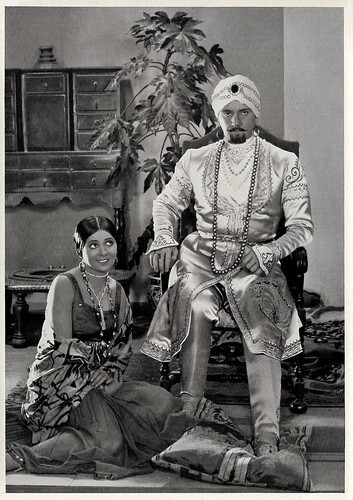
German collectors card by Ross Verlag in the series 'Vom Werden deutscher Filmkunst - Der stumme Film', group no. 42, picture no. 127. Photo: Ufa. Harry Piel and Dary Holm in Panik/Panic (Harry Piel, 1928).
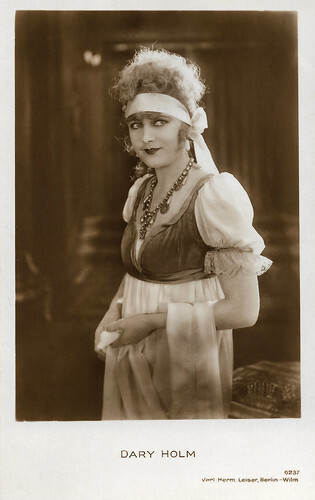
German postcard by Verlag Hermann Leiser, Berlin-Wilm., no. 6237.
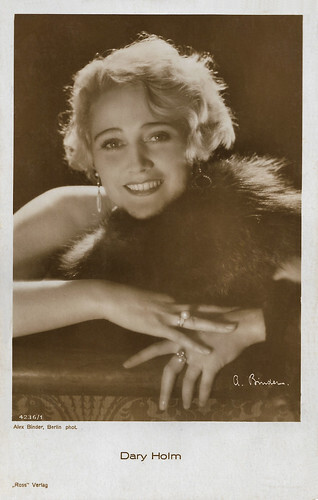
German postcard by Ross Verlag, no. 4236/1, 1929-1930. Photo: Alex Binder, Berlin.
Advancing from supporting to leading roles
Dary Holm was born in 1897 in Hamburg, Germany, as Anna Maria Dorothea Meyer. She grew up in Upper Bavaria and decided to take up acting after the First World War.
Initially, she started her film career under the name Anna Holm. Through her colleague Bernd Aldor , she was recommended to director Otto Rippert in 1921, who cast her in his film Die Beute der Erinnyen, with Werner Krauß and Ressel Orla .
In Munich she acted that year in the two-part film Hyänen der Welt (1921) and Der Todessegler (1921), both by Fred Stranz, while in Berlin she acted in Die rätselhafte Zwölf (Martin Hartwig, 1921).
In the following years, Dary Holm advanced from supporting to leading roles. In 1922-1923, she acted in several films at Union-Film-Co. in Munich, often opposite Ernst Rückert , and directed by directors like Franz Seitz and Josef Berger.
Probably one of her first leads she had in 1923 opposite Bernd Aldor in Die Affäre der Baronesse Orlowska/The Affair of Baroness Orlovska (Hans Werckmeister, 1923) while she also acted that year in the - lost - historical biopic Martin Luther (Karl Wüstenhagen, 1923). The film depicts the life of the 16th century Christian reformer Martin Luther. It was shot at historic sites in Erfurt and the Wartburg.
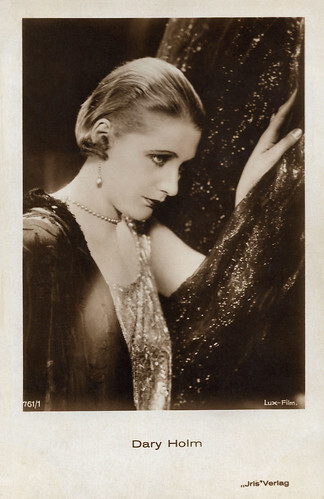
Austrian postcard by Iris-Verlag, no. 761/1. Photo: Lux-Film.
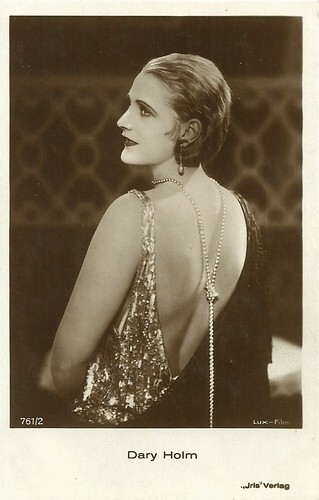
Austrian postcard by Iris Verlag, no. 761/2. Photo: Lux-Film.
The film partner of Harry Piel
From 1924 Dary Holm was regularly cast as a film partner of Harry Piel . They first appeared toergether in Auf gefährlichen Spuren/Dangerous Clues (Harry Piel, 1924), followed by several others, such as Der Mann ohne Nerven/The Man Without Nerves (Harry Piel, 1924), Abenteuer im Nachtexpreß/Adventure on the Night Express (Harry Piel, 1925), the French-German historical adventure film Zigano, der Brigant von Monte Diavolo/Zigano (Harry Piel, 1925) with Denise Legeay , Der schwarze Pierrot/The Black Pierrot (Harry Piel, 1926), and Rätsel einer Nacht/Night of Mystery (Harry Piel, 1927).
In 1927, after Piel's divorce from Johanna Präder, Holm married the popular actor-director. The couple continued together in Panik/Panic (Harry Piel, 1927-1928), Mann gegen Mann/Man Against Man (Harry Piel, 1928), Männer ohne Beruf/Men Without Work (Harry Piel, 1928) with Albert Paulig , Sein bester Freund/His Best Friend (Harry Piel, 1929), Achtung! Auto-Diebe!/Warning! Car thieves! (Harry Piel, 1930), Schatten der Unterwelt/Shadows of the Underworld (Harry Piel, 1931) - which was also shot in French version, and Jonny stiehlt Europa/Johnny Steals Europe (Harry Piel, 1932).
Occasionally, Dary Holm also acted in films by other directors, but most were with Piel from 1924 onward. "Playing with adventure is what attracts me to film", Dary Holm let her audience know. "Certainly, other stars often have more opportunity to reveal their mimic talent and to win the audience's heart with the smile of their beautiful lips and the magic of their eyes. I, however, have to take dangers with my partner and have to win sympathy through my deathly courage. But it also works like this. The tempo of danger that carries me through the film is what gives me the greatest pleasure and not least brings success. This tempo is the most genuine film - the stage can never achieve such a thing!)."
After her first talkies, Dary Holm retired into private life. She died at age 63 in 1960 in Munich and was buried there at the Waldfriedhof. When 2 1/2 years after Harry Piel died too, he was buried in the same grave. And even Piel's third wife, Lilli Stromereder-Piel (1901-1984), was buried there.
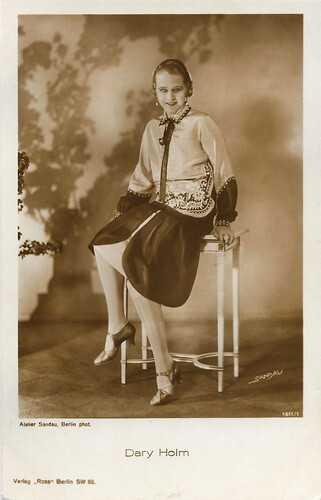
German postcard by Ross Verlag, Berlin, no. 1611/1, 1927-1928. Photo: Atelier Sandau, Berlin.
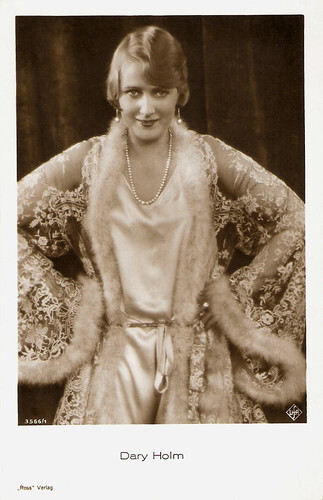
German postcard by Ross Verlag, no. 3566/1, 1928-1929. Photo: Ufa.
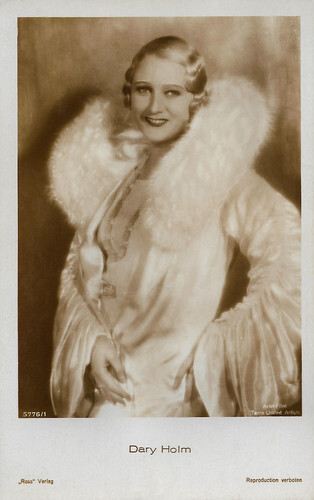
German postcard by Ross Verlag, no. 5776/1, 1930-1931. Photo: Ariël Film / Terra / United Artists. Dary Holm in Schatten der Unterwelt/Shadows of the Underworld (Harry Piel, 1931).
Sources: Stephanie D'heil (Steffi-line.de - German), Filmportal.de, Wikipedia (German and English), and .

German collectors card by Ross Verlag in the series 'Vom Werden deutscher Filmkunst - Der stumme Film', group no. 42, picture no. 127. Photo: Ufa. Harry Piel and Dary Holm in Panik/Panic (Harry Piel, 1928).

German postcard by Verlag Hermann Leiser, Berlin-Wilm., no. 6237.

German postcard by Ross Verlag, no. 4236/1, 1929-1930. Photo: Alex Binder, Berlin.
Advancing from supporting to leading roles
Dary Holm was born in 1897 in Hamburg, Germany, as Anna Maria Dorothea Meyer. She grew up in Upper Bavaria and decided to take up acting after the First World War.
Initially, she started her film career under the name Anna Holm. Through her colleague Bernd Aldor , she was recommended to director Otto Rippert in 1921, who cast her in his film Die Beute der Erinnyen, with Werner Krauß and Ressel Orla .
In Munich she acted that year in the two-part film Hyänen der Welt (1921) and Der Todessegler (1921), both by Fred Stranz, while in Berlin she acted in Die rätselhafte Zwölf (Martin Hartwig, 1921).
In the following years, Dary Holm advanced from supporting to leading roles. In 1922-1923, she acted in several films at Union-Film-Co. in Munich, often opposite Ernst Rückert , and directed by directors like Franz Seitz and Josef Berger.
Probably one of her first leads she had in 1923 opposite Bernd Aldor in Die Affäre der Baronesse Orlowska/The Affair of Baroness Orlovska (Hans Werckmeister, 1923) while she also acted that year in the - lost - historical biopic Martin Luther (Karl Wüstenhagen, 1923). The film depicts the life of the 16th century Christian reformer Martin Luther. It was shot at historic sites in Erfurt and the Wartburg.

Austrian postcard by Iris-Verlag, no. 761/1. Photo: Lux-Film.

Austrian postcard by Iris Verlag, no. 761/2. Photo: Lux-Film.
The film partner of Harry Piel
From 1924 Dary Holm was regularly cast as a film partner of Harry Piel . They first appeared toergether in Auf gefährlichen Spuren/Dangerous Clues (Harry Piel, 1924), followed by several others, such as Der Mann ohne Nerven/The Man Without Nerves (Harry Piel, 1924), Abenteuer im Nachtexpreß/Adventure on the Night Express (Harry Piel, 1925), the French-German historical adventure film Zigano, der Brigant von Monte Diavolo/Zigano (Harry Piel, 1925) with Denise Legeay , Der schwarze Pierrot/The Black Pierrot (Harry Piel, 1926), and Rätsel einer Nacht/Night of Mystery (Harry Piel, 1927).
In 1927, after Piel's divorce from Johanna Präder, Holm married the popular actor-director. The couple continued together in Panik/Panic (Harry Piel, 1927-1928), Mann gegen Mann/Man Against Man (Harry Piel, 1928), Männer ohne Beruf/Men Without Work (Harry Piel, 1928) with Albert Paulig , Sein bester Freund/His Best Friend (Harry Piel, 1929), Achtung! Auto-Diebe!/Warning! Car thieves! (Harry Piel, 1930), Schatten der Unterwelt/Shadows of the Underworld (Harry Piel, 1931) - which was also shot in French version, and Jonny stiehlt Europa/Johnny Steals Europe (Harry Piel, 1932).
Occasionally, Dary Holm also acted in films by other directors, but most were with Piel from 1924 onward. "Playing with adventure is what attracts me to film", Dary Holm let her audience know. "Certainly, other stars often have more opportunity to reveal their mimic talent and to win the audience's heart with the smile of their beautiful lips and the magic of their eyes. I, however, have to take dangers with my partner and have to win sympathy through my deathly courage. But it also works like this. The tempo of danger that carries me through the film is what gives me the greatest pleasure and not least brings success. This tempo is the most genuine film - the stage can never achieve such a thing!)."
After her first talkies, Dary Holm retired into private life. She died at age 63 in 1960 in Munich and was buried there at the Waldfriedhof. When 2 1/2 years after Harry Piel died too, he was buried in the same grave. And even Piel's third wife, Lilli Stromereder-Piel (1901-1984), was buried there.

German postcard by Ross Verlag, Berlin, no. 1611/1, 1927-1928. Photo: Atelier Sandau, Berlin.

German postcard by Ross Verlag, no. 3566/1, 1928-1929. Photo: Ufa.

German postcard by Ross Verlag, no. 5776/1, 1930-1931. Photo: Ariël Film / Terra / United Artists. Dary Holm in Schatten der Unterwelt/Shadows of the Underworld (Harry Piel, 1931).
Sources: Stephanie D'heil (Steffi-line.de - German), Filmportal.de, Wikipedia (German and English), and .
Published on November 08, 2022 22:00
November 7, 2022
Harry Carey
American actor and cowboy Harry Carey (1878-1947) was one of the silent film's earliest superstars. Carey often played in films by D.W. Griffith and starred in John Ford's feature debut, Straight Shooting (1918). It was the first of their 27 films together. He was the father of Harry Carey Jr., who was a prominent character actor.
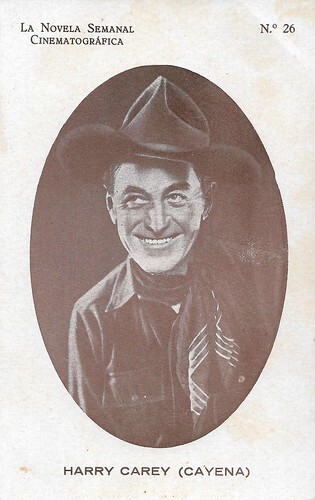
Spanish collectors card by La Novela Semanal Cinematográfica, no. 26. 'Cayena' refers to Carey's character Cheyenne Harry.
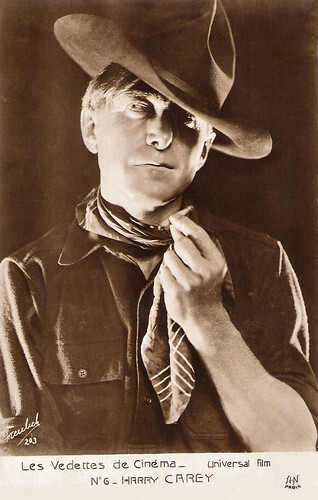
French postcard by A.N., Paris, in the series Les Vedettes de Cinéma, no. 6. Photo: Universal Film / Roman Freulich, no. 203.
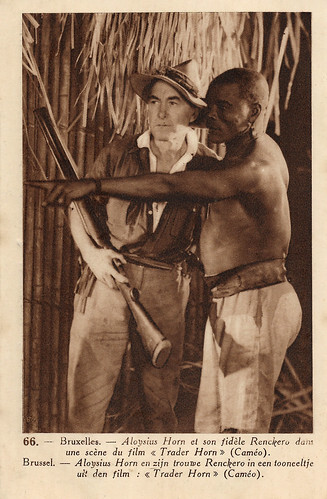
Belgian postcard by Edition de la Chocolaterie Lecocq, Brussels, no. 66. Photo: Metro-Goldwyn-Mayer. Harry Carey and Mutia Omoolu in Trader Horn (W.S. Van Dyke, 1931). Caption: Aloysius Horn and his loyal Renckero in a scene from the film Trader Horn.
Carey's rugged frame and weather-beaten face
Harry Carey was born Henry DeWitt Carey II in the Bronx, New York, in 1878. He was a son of Henry DeWitt Carey, a prominent lawyer and judge of the New York Supreme Court, and his wife Ella J. (Ludlum). He grew up on City Island, Bronx. Carey's love of horses was instilled in him at a young age as he watched New York City's mounted policemen go through their paces in the 1880s.
Carey attended Hamilton Military Academy and then studied law at New York University. At 21, he had a boating accident that led to pneumonia. While recuperating he wrote a play,' Montana', about the Western frontier. He decided to star in his own creation and the play was very successful. Audiences were thrilled when Carey brought his horse onto the stage. He toured the country performing in it for three years and earned a lot of money, but his fortune evaporated after his next play, 'Heart of Alaska' (1909) closed after only 16 performances.
His friend Henry B. Walthall introduced him to legendary director D.W. Griffith , with whom Carey would make many films. His first credited picture is Bill Sharkey's Last Game (D.W. Griffith, 1909). Memorable is The Musketeers of Pig Alley (D.W. Griffith, 1912), in which Carey played a hood in the 'hoods of New York. Carey followed Griffith to Hollywood and appeared in his The Battle at Elderbush Gulch (D.W. Griffith, 1913) with Lillian Gish, and Judith of Bethulia (D.W. Griffith, 1914).
Carey's rugged frame and weather-beaten face were well suited to Westerns. One of his most popular roles was as the good-hearted outlaw Cheyenne Harry. In most of the films, his co-stars included the teen-aged Olive Golden (from 1920: Olive Carey) as the love interest and Hoot Gibson as his young sidekick. The Cheyenne Harry franchise spanned two decades, from A Knight of the Range (Jacques Jaccard, 1916) to Aces Wild (Harry L. Fraser, 1936).
Olive Golden introduced him to future director John Ford. Carey influenced Universal Studios head, Carl Laemmle, to use Ford as a director. Jon C. Hopwood at IMDb : "The first Carey-Ford collaboration was Straight Shooting (John Ford, 1917), an entertaining if crude (by today's standards) western, most notable for Carey's performance." The partnership lasted until a rift in the friendship in 1921.
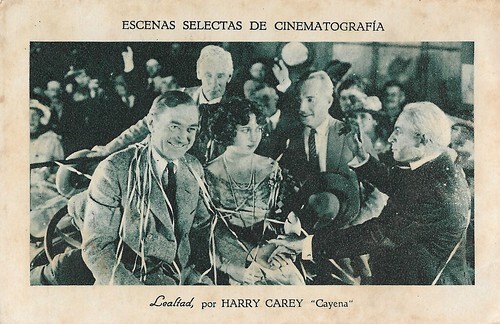
Spanish collectors card by Escenas selectas de cinematografia, series A, no. 12. 'Cayena' refers to Carey's regular character 'Cheyenne Harry'. There is no Carey film with Loyalty (Lealtad) in the title.
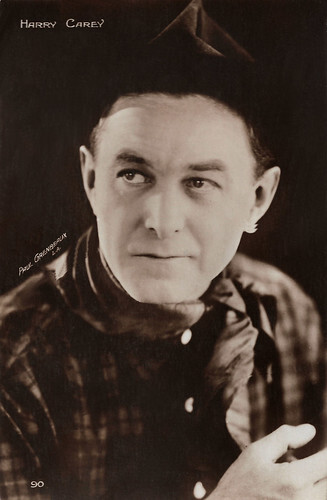
French postcard by Editions Cinémagazine, no. 90. Photo: Paul Grenbeaux, L.A.
True portrayals of the West
When sound films arrived, Harry Carey displayed an assured, gritty baritone voice that suited his rough-hewn screen personality. He was the logical choice for the title role in MGM's outdoor jungle epic Trader Horn (W.S. Van Dyke, 1931). By this time Carey, already in his fifties, was too mature for most leading roles, and the only starring roles that he was offered were in low-budget Westerns and serials.
He soon settled into a comfortable career as a solid, memorable character actor. He reunited with John Ford for The Prisoner of Shark Island (John Ford, 1936). It was the last of their 27 pictures together.
Carey received an Academy Award nomination for Best Supporting Actor for his role as the President of the Senate in Mr. Smith Goes to Washington (Frank Capra, 1939). Among his other notable later roles were that of Sgt. Robert White, crew chief of the bomber Mary Ann in Air Force (Howard Hawks, 1943) and Mr. Melville, the cattle buyer, in Red River (Howard Hawks, 1948).
Carey made his Broadway stage debut in 1940 in 'Heavenly Express' with John Garfield . Harry Carey married at least twice and perhaps a third time (census records for 1910 indicate he had a wife named Clare E. Carey, and some references state that he was also married to actress Fern Foster). His last marriage was to actress Olive Fuller Golden in 1920. They were together until his death. They purchased a large ranch in Saugus, California, north of Los Angeles.
Their son, Harry Carey, Jr., would become a character actor too, most famous for his roles in Westerns. Father and son both appear (albeit in different scenes) in Red River (Howard Hawks, 1948), and mother and son are both featured in The Searchers (John Ford, 1956). Harry Carey died in 1947 from a combination of lung cancer, emphysema, and coronary thrombosis, at the age of 69. Ford dedicated his remake of 3 Godfathers (John Ford, 1948) "To Harry Carey--Bright Star Of The Early Western Sky."
Jon Hopwood at IMDb : "Carey did not dress as flashily as Ken Maynard or the great Tom Mix , and his films were often true portrayals of the West instead of Mix's flashy hoss operas. Good with a physical business, particularly involving his hands, Carey developed signature gestures such as the way he sat on a horse, a semi-slouch with his elbows resting on the saddle horn. Another signature was his holding his left forearm with his right, a physical gesture that in the elocutionary style of stage melodrama and the early silents signalled thoughtfulness, but which Carey made uniquely his own." John Wayne paid homage to Carey when he held his right elbow with his left hand in the closing shot of The Searchers (John Ford, 1956).
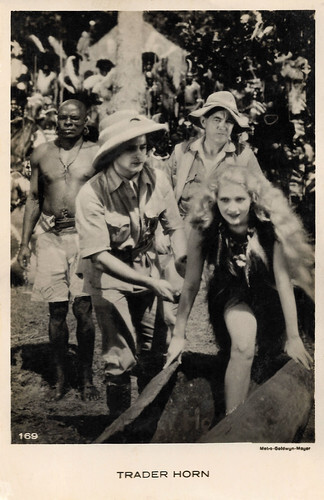
Dutch postcard, no. 169. Photo: Metro-Goldwyn-Mayer. Harry Carey, Edwina Booth and Duncan Renaldo in Trader Horn (W.S. Van Dyke, 1931).
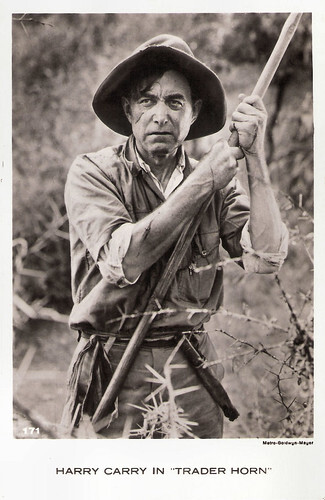
Dutch postcard, no. 171. Photo: Metro-Goldwyn-Mayer. Harry Carey in Trader Horn (W.S. Van Dyke, 1931). 'Carey' is mistakenly written on the card as 'Carry'.
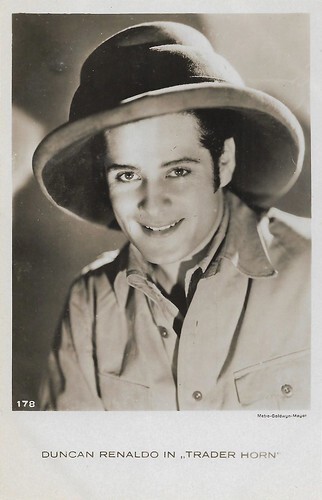
Dutch postcard, no. 178. Photo: Metro-Goldwyn-Mayer. Duncan Renaldo in Trader Horn (W.S. Van Dyke, 1931).
Sources: (IMDb), (IMDb), Wikipedia and .

Spanish collectors card by La Novela Semanal Cinematográfica, no. 26. 'Cayena' refers to Carey's character Cheyenne Harry.

French postcard by A.N., Paris, in the series Les Vedettes de Cinéma, no. 6. Photo: Universal Film / Roman Freulich, no. 203.

Belgian postcard by Edition de la Chocolaterie Lecocq, Brussels, no. 66. Photo: Metro-Goldwyn-Mayer. Harry Carey and Mutia Omoolu in Trader Horn (W.S. Van Dyke, 1931). Caption: Aloysius Horn and his loyal Renckero in a scene from the film Trader Horn.
Carey's rugged frame and weather-beaten face
Harry Carey was born Henry DeWitt Carey II in the Bronx, New York, in 1878. He was a son of Henry DeWitt Carey, a prominent lawyer and judge of the New York Supreme Court, and his wife Ella J. (Ludlum). He grew up on City Island, Bronx. Carey's love of horses was instilled in him at a young age as he watched New York City's mounted policemen go through their paces in the 1880s.
Carey attended Hamilton Military Academy and then studied law at New York University. At 21, he had a boating accident that led to pneumonia. While recuperating he wrote a play,' Montana', about the Western frontier. He decided to star in his own creation and the play was very successful. Audiences were thrilled when Carey brought his horse onto the stage. He toured the country performing in it for three years and earned a lot of money, but his fortune evaporated after his next play, 'Heart of Alaska' (1909) closed after only 16 performances.
His friend Henry B. Walthall introduced him to legendary director D.W. Griffith , with whom Carey would make many films. His first credited picture is Bill Sharkey's Last Game (D.W. Griffith, 1909). Memorable is The Musketeers of Pig Alley (D.W. Griffith, 1912), in which Carey played a hood in the 'hoods of New York. Carey followed Griffith to Hollywood and appeared in his The Battle at Elderbush Gulch (D.W. Griffith, 1913) with Lillian Gish, and Judith of Bethulia (D.W. Griffith, 1914).
Carey's rugged frame and weather-beaten face were well suited to Westerns. One of his most popular roles was as the good-hearted outlaw Cheyenne Harry. In most of the films, his co-stars included the teen-aged Olive Golden (from 1920: Olive Carey) as the love interest and Hoot Gibson as his young sidekick. The Cheyenne Harry franchise spanned two decades, from A Knight of the Range (Jacques Jaccard, 1916) to Aces Wild (Harry L. Fraser, 1936).
Olive Golden introduced him to future director John Ford. Carey influenced Universal Studios head, Carl Laemmle, to use Ford as a director. Jon C. Hopwood at IMDb : "The first Carey-Ford collaboration was Straight Shooting (John Ford, 1917), an entertaining if crude (by today's standards) western, most notable for Carey's performance." The partnership lasted until a rift in the friendship in 1921.

Spanish collectors card by Escenas selectas de cinematografia, series A, no. 12. 'Cayena' refers to Carey's regular character 'Cheyenne Harry'. There is no Carey film with Loyalty (Lealtad) in the title.

French postcard by Editions Cinémagazine, no. 90. Photo: Paul Grenbeaux, L.A.
True portrayals of the West
When sound films arrived, Harry Carey displayed an assured, gritty baritone voice that suited his rough-hewn screen personality. He was the logical choice for the title role in MGM's outdoor jungle epic Trader Horn (W.S. Van Dyke, 1931). By this time Carey, already in his fifties, was too mature for most leading roles, and the only starring roles that he was offered were in low-budget Westerns and serials.
He soon settled into a comfortable career as a solid, memorable character actor. He reunited with John Ford for The Prisoner of Shark Island (John Ford, 1936). It was the last of their 27 pictures together.
Carey received an Academy Award nomination for Best Supporting Actor for his role as the President of the Senate in Mr. Smith Goes to Washington (Frank Capra, 1939). Among his other notable later roles were that of Sgt. Robert White, crew chief of the bomber Mary Ann in Air Force (Howard Hawks, 1943) and Mr. Melville, the cattle buyer, in Red River (Howard Hawks, 1948).
Carey made his Broadway stage debut in 1940 in 'Heavenly Express' with John Garfield . Harry Carey married at least twice and perhaps a third time (census records for 1910 indicate he had a wife named Clare E. Carey, and some references state that he was also married to actress Fern Foster). His last marriage was to actress Olive Fuller Golden in 1920. They were together until his death. They purchased a large ranch in Saugus, California, north of Los Angeles.
Their son, Harry Carey, Jr., would become a character actor too, most famous for his roles in Westerns. Father and son both appear (albeit in different scenes) in Red River (Howard Hawks, 1948), and mother and son are both featured in The Searchers (John Ford, 1956). Harry Carey died in 1947 from a combination of lung cancer, emphysema, and coronary thrombosis, at the age of 69. Ford dedicated his remake of 3 Godfathers (John Ford, 1948) "To Harry Carey--Bright Star Of The Early Western Sky."
Jon Hopwood at IMDb : "Carey did not dress as flashily as Ken Maynard or the great Tom Mix , and his films were often true portrayals of the West instead of Mix's flashy hoss operas. Good with a physical business, particularly involving his hands, Carey developed signature gestures such as the way he sat on a horse, a semi-slouch with his elbows resting on the saddle horn. Another signature was his holding his left forearm with his right, a physical gesture that in the elocutionary style of stage melodrama and the early silents signalled thoughtfulness, but which Carey made uniquely his own." John Wayne paid homage to Carey when he held his right elbow with his left hand in the closing shot of The Searchers (John Ford, 1956).

Dutch postcard, no. 169. Photo: Metro-Goldwyn-Mayer. Harry Carey, Edwina Booth and Duncan Renaldo in Trader Horn (W.S. Van Dyke, 1931).

Dutch postcard, no. 171. Photo: Metro-Goldwyn-Mayer. Harry Carey in Trader Horn (W.S. Van Dyke, 1931). 'Carey' is mistakenly written on the card as 'Carry'.

Dutch postcard, no. 178. Photo: Metro-Goldwyn-Mayer. Duncan Renaldo in Trader Horn (W.S. Van Dyke, 1931).
Sources: (IMDb), (IMDb), Wikipedia and .
Published on November 07, 2022 22:00
November 6, 2022
Quadrophenia (1979)
Quadrophenia (Franc Roddam, 1979) is a British musical film based on the concept album 'Quadrophenia' (1973) by British rock band The Who. The film is a reflection of proto-punk, pre-Thatcher Britain and revolves around Jimmy (Phil Daniels), a member of the Mods, a 1960s youth gang at odds with the Rockers. It is now seen as a cult film with a great soundtrack and many familiar faces, including Ray Winstone, Timothy Spall, Leslie Ash, Toyah Wilcox and Sting. I was a huge fan when the film premiered and bought the lobby cards I used for this post, in a film shop near London's Oxford Street in 1980.

British lobby card. Photo: Curbishley Baird Production / Brent Walker Film Distributors. Phil Daniels and Leslie Ash in Quadrophenia (Franc Roddam, 1979).
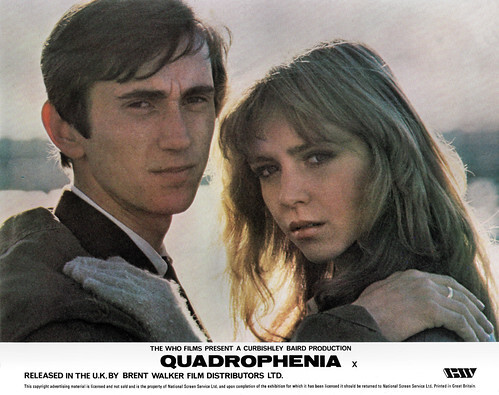
British lobby card. Photo: Curbishley Baird Production / Brent Walker Film Distributors. Phil Daniels and Leslie Ash in Quadrophenia (Franc Roddam, 1979).
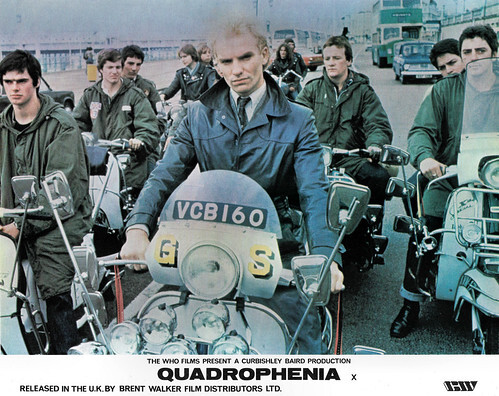
British lobby card. Photo: Curbishley Baird Production / Brent Walker Film Distributors. Sting in Quadrophenia (Franc Roddam, 1979).
Mods and Rockers at odds
Quadrophenia (1979) deals with the identity conflicts of British working-class youth in the mid-1960s and their subcultures. It is 1964 in London and young James Michael "Jimmy" Cooper (Phil Daniels) is a member of the Mods, a movement of well-dressed young men riding Vespa and Lambretta scooters with several mirrors on the leg shield. "I don't wanna be the same as everyone else. That's why I'm a Mod, see? ", Jimmy says at the start of the film.
The Mods are the counterparts of the Rockers, with whom they are always at odds. The Rockers dress in black leather and ride heavy motorbikes. Disillusioned by his parents and his boring job as an office messenger at an advertising agency, Jimmy only finds an outlet for his bleak and depressing life with his Mod friends Dave (Mark Wingett), Chalky (Phil Davis) and Spider (Gary Shail). They cruise London on their scooters, celebrate parties and take "coloured pills" (amphetamines), which they obtain by breaking into pharmacies.
The first big conflict for Jimmy comes when he meets his old friend Kevin (Ray Winstone) again, who was in the army and turns out to be a rocker. In a late-night brawl involving both of them, Jimmy abandons Kevin and drives off, while Kevin is beaten up by the other mods. A three-day holiday gives both gangs an excuse to meet in the seaside resort Brighton during a big dance event. This eventually escalates into a bloody fight between the Mods and the Rockers on a Brighton beach. This event, incidentally, was based on a fight that actually happened.
In the over-familiar ending of Quadrophenia, it seems that Jimmy lets himself drift off a cliff as a form of suicide. Although Jimmy is not actually seen in this scene, the scooter is seen flying through the air and clattering on the rocks. This event sparked quite a debate about whether this Jimmy would be dead or not. The average answer is that Jimmy must have jumped off his scooter just before he could have fallen to his death. Several actors have said that it is the opening scene of the film that equals the ending. In it, Jimmy is seen walking away from the cliff unharmed (and without a scooter).
The buzz about the film's ending scene is largely misplaced, as the main character can clearly be seen in an instant on top of the cliff (completely unharmed), while the scooter floats through the air. Indeed, the opening scene is Jimmy walking back to the overhang from the cliff. Symbolically, he has thrown the mod culture in the trash and Ace Face's scooter in the process. He had found out that Ace Face's heroism and rebelliousness is only fake. Sting , then still the singer of the band The Police, played Ace Face in his film debut.
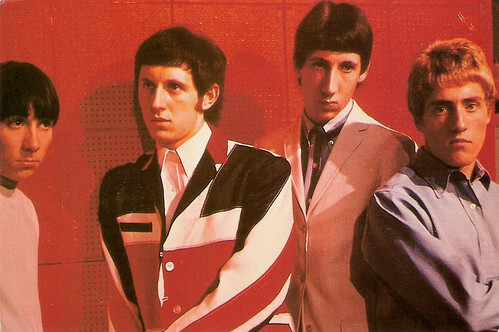
British postcard by Splash, Manchester, X017. The Who.
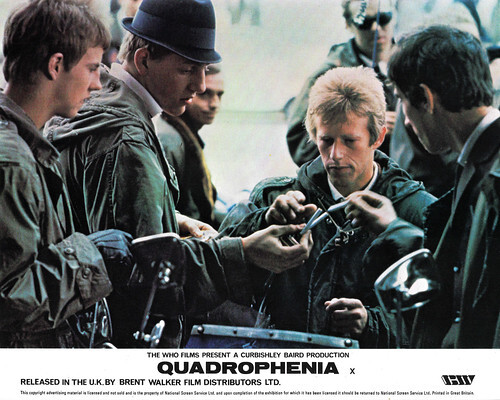
British lobby card. Photo: Curbishley Baird Production / Brent Walker Film Distributors. Phil Davis in Quadrophenia (Franc Roddam, 1979).
Extremely believable from the start to the finish
Quadrophenia (1979), which was also Franc Roddam's directorial debut, got mixed reviews. Janet Maslin, reviewing the film for The New York Times in 1979, called it "...gritty and ragged and sometimes quite beautiful", creating a "...slice-of-life movie that feels tremendously authentic in its sentiments as well as its details." Maslin states that the director's scenes of youth battles "...capture a fierce, dizzying excitement that epitomizes a kind of youthful extreme."
Other critics rejected the film because of the large amount of sex, violence, and drug abuse, Today the film is considered a cult classic and a realistic reflection of youth culture in the 1960s. Consequently, many have since praised Phil Daniels' performance. Sting 's appearance in the film also gave his band The Police a positive push, even though their music is totally out of step with traditional mod taste.
The film had a major impact on the brief mod revival in the music and fashion world. This revival paved the way for careers for bands such as Secret Affair, The Chords and The Lambrettas, who capitalised on the popularity of The Jam.
Michael Elliott at IMDb : "I never was a big fan of the film TOMMY but I found this one here to be much better overall. I think the greatest thing going for this film is the soundtrack, which not only includes The Who songs from this album but we also get some of their older material (a memorable bit on 'My Generation') as well as songs from other artists. This soundtrack is certainly something terrific and The Who songs are put to good use here.
Another thing working well is the performance of Daniels who perfectly nails this troubled character. I thought he was extremely believable from the start to the finish as he perfectly nailed the various emotions that this teenager is going through. I thought he was especially good towards the end once the guy starts to finally have a breakdown."
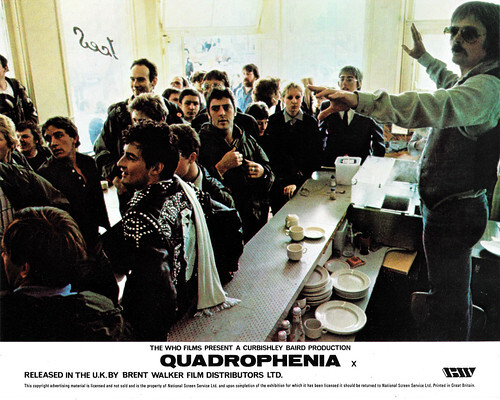
British lobby card. Photo: Curbishley Baird Production / Brent Walker Film Distributors. Publicity still for Quadrophenia (Franc Roddam, 1979).
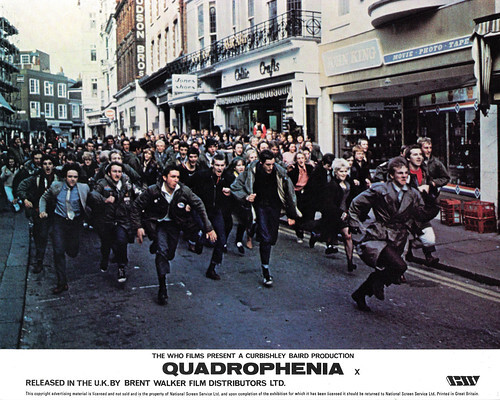
British lobby card. Photo: Curbishley Baird Production / Brent Walker Film Distributors. Publicity still for Quadrophenia (Franc Roddam, 1979).
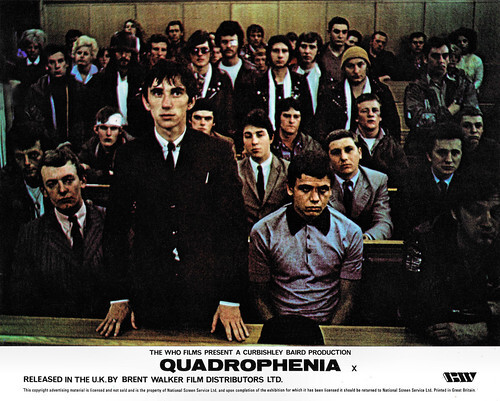
British lobby card. Photo: Curbishley Baird Production / Brent Walker Film Distributors. Phil Daniels in Quadrophenia (Franc Roddam, 1979).
Sources: Michael Elliott (IMDb), Wikipedia (Dutch, German and English), and IMDb.

British lobby card. Photo: Curbishley Baird Production / Brent Walker Film Distributors. Phil Daniels and Leslie Ash in Quadrophenia (Franc Roddam, 1979).

British lobby card. Photo: Curbishley Baird Production / Brent Walker Film Distributors. Phil Daniels and Leslie Ash in Quadrophenia (Franc Roddam, 1979).

British lobby card. Photo: Curbishley Baird Production / Brent Walker Film Distributors. Sting in Quadrophenia (Franc Roddam, 1979).
Mods and Rockers at odds
Quadrophenia (1979) deals with the identity conflicts of British working-class youth in the mid-1960s and their subcultures. It is 1964 in London and young James Michael "Jimmy" Cooper (Phil Daniels) is a member of the Mods, a movement of well-dressed young men riding Vespa and Lambretta scooters with several mirrors on the leg shield. "I don't wanna be the same as everyone else. That's why I'm a Mod, see? ", Jimmy says at the start of the film.
The Mods are the counterparts of the Rockers, with whom they are always at odds. The Rockers dress in black leather and ride heavy motorbikes. Disillusioned by his parents and his boring job as an office messenger at an advertising agency, Jimmy only finds an outlet for his bleak and depressing life with his Mod friends Dave (Mark Wingett), Chalky (Phil Davis) and Spider (Gary Shail). They cruise London on their scooters, celebrate parties and take "coloured pills" (amphetamines), which they obtain by breaking into pharmacies.
The first big conflict for Jimmy comes when he meets his old friend Kevin (Ray Winstone) again, who was in the army and turns out to be a rocker. In a late-night brawl involving both of them, Jimmy abandons Kevin and drives off, while Kevin is beaten up by the other mods. A three-day holiday gives both gangs an excuse to meet in the seaside resort Brighton during a big dance event. This eventually escalates into a bloody fight between the Mods and the Rockers on a Brighton beach. This event, incidentally, was based on a fight that actually happened.
In the over-familiar ending of Quadrophenia, it seems that Jimmy lets himself drift off a cliff as a form of suicide. Although Jimmy is not actually seen in this scene, the scooter is seen flying through the air and clattering on the rocks. This event sparked quite a debate about whether this Jimmy would be dead or not. The average answer is that Jimmy must have jumped off his scooter just before he could have fallen to his death. Several actors have said that it is the opening scene of the film that equals the ending. In it, Jimmy is seen walking away from the cliff unharmed (and without a scooter).
The buzz about the film's ending scene is largely misplaced, as the main character can clearly be seen in an instant on top of the cliff (completely unharmed), while the scooter floats through the air. Indeed, the opening scene is Jimmy walking back to the overhang from the cliff. Symbolically, he has thrown the mod culture in the trash and Ace Face's scooter in the process. He had found out that Ace Face's heroism and rebelliousness is only fake. Sting , then still the singer of the band The Police, played Ace Face in his film debut.

British postcard by Splash, Manchester, X017. The Who.

British lobby card. Photo: Curbishley Baird Production / Brent Walker Film Distributors. Phil Davis in Quadrophenia (Franc Roddam, 1979).
Extremely believable from the start to the finish
Quadrophenia (1979), which was also Franc Roddam's directorial debut, got mixed reviews. Janet Maslin, reviewing the film for The New York Times in 1979, called it "...gritty and ragged and sometimes quite beautiful", creating a "...slice-of-life movie that feels tremendously authentic in its sentiments as well as its details." Maslin states that the director's scenes of youth battles "...capture a fierce, dizzying excitement that epitomizes a kind of youthful extreme."
Other critics rejected the film because of the large amount of sex, violence, and drug abuse, Today the film is considered a cult classic and a realistic reflection of youth culture in the 1960s. Consequently, many have since praised Phil Daniels' performance. Sting 's appearance in the film also gave his band The Police a positive push, even though their music is totally out of step with traditional mod taste.
The film had a major impact on the brief mod revival in the music and fashion world. This revival paved the way for careers for bands such as Secret Affair, The Chords and The Lambrettas, who capitalised on the popularity of The Jam.
Michael Elliott at IMDb : "I never was a big fan of the film TOMMY but I found this one here to be much better overall. I think the greatest thing going for this film is the soundtrack, which not only includes The Who songs from this album but we also get some of their older material (a memorable bit on 'My Generation') as well as songs from other artists. This soundtrack is certainly something terrific and The Who songs are put to good use here.
Another thing working well is the performance of Daniels who perfectly nails this troubled character. I thought he was extremely believable from the start to the finish as he perfectly nailed the various emotions that this teenager is going through. I thought he was especially good towards the end once the guy starts to finally have a breakdown."

British lobby card. Photo: Curbishley Baird Production / Brent Walker Film Distributors. Publicity still for Quadrophenia (Franc Roddam, 1979).

British lobby card. Photo: Curbishley Baird Production / Brent Walker Film Distributors. Publicity still for Quadrophenia (Franc Roddam, 1979).

British lobby card. Photo: Curbishley Baird Production / Brent Walker Film Distributors. Phil Daniels in Quadrophenia (Franc Roddam, 1979).
Sources: Michael Elliott (IMDb), Wikipedia (Dutch, German and English), and IMDb.
Published on November 06, 2022 22:00
November 5, 2022
Written by Victor Hugo
Victor Hugo (1802-1885) was a French writer, poet, essayist and statesman and is considered one of the most important and influential French Romantic authors of the 19th century. He wrote novels, poems, plays, essays and political speeches and also left an extensive correspondence. More than 20 film adaptations have been made of his most famous novel, 'Les Misérables', but also his 'Notre-Dame de Paris' (The Hunchback of Notre Dame) has been adapted to the screen several times. Hugo's work has been filmed in Hollywood, India, Japan, Egypt and Italy.

French postcard by Croissant, Paris, no. 3664. Photo: Film Pathé. Publicity still for Le chemineau/The Tramp (Albert Capellani, 1905), based on the first part of Victor Hugo's novel 'Les misérables'. Jean Valjean is granted lodging by the parish priest of a village, steals several silver candlesticks but escapes arrest thanks to the false testimony of the priest.
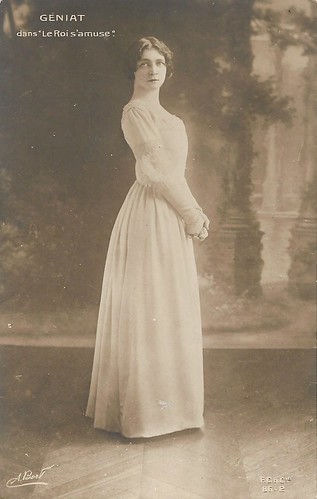
French postcard by FC & Cie, no. 86/2. Photo: A. Bert. Marcelle Géniat in 'Le Roi s'amuse'. French stage and screen actress Marcelle Géniat (1881-1959) made her film debut in Le roi s'amuse/The King Amuses Himself (Albert Capellani, 1909) as Blanche opposite Paul Cappelani as the king and Henry Sylvain as Triboulet. The following decade, an Austrian film version was made, Der König amüsiert sich (Jakob Fleck, Luise Fleck, 1918) starring Hermann Benke as Rigoletto and Liane Haid as his daughter, Blanche. Another adaptation of Hugo's play is the Italian film Il re si diverte/The King's Jester (1941) which starred Michel Simon as Rigoletto and Rossano Brazzi as the king.

German postcard by Ross Verlag, no. 105/1. Photo: Universal Pictures Corp. Conrad Veidt as Gwynplaine and Mary Philbin as the blind Dea in The Man Who Laughs (Paul Leni, 1928), based on Hugo's 1869 novel 'L'homme qui rit'. The Man Who Laughs is a romantic melodrama similar to films such as The Hunchback of Notre Dame. The film is known for the grim Joker-like grin on Gwynplaine's face and is often classified as a horror film. Film critic Roger Ebert stated, "The Man Who Laughs is a melodrama at times even a swashbuckler, but so steeped in expressionist gloom that it plays like a horror film." 'L'homme qui rit' had been filmed twice before. Wikipedia mentions a French Pathé version, L'Homme qui rit (1909) of which no copies are known to survive, and the Austrian film company Olympic-Film released a German version, Das grinsende Gesicht/The Grinning Face (Julius Herska, 1921).
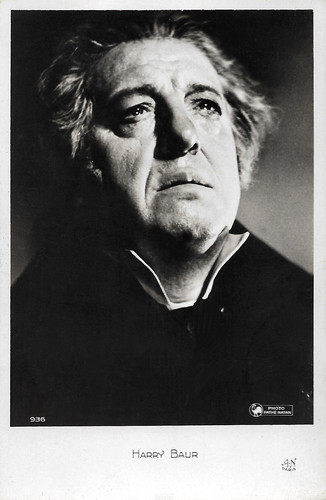
French postcard by A.N., Paris, no. 936. Photo: Pathé Natan. Harry Baur as Jean Valjean in Les Misérables (Raymond Bernard, 1934), based on the novel by Victor Hugo. For six months in 1933 shooting took place in Paris and the South of France. Because of its length, the film was released in two parts. It became Harry Baur ’s best-performed film performance and some say the best film interpretation of Hugo’s famous character. His costars were Charles Vanel as Javert and Josseline Gael as Cosette. Because of the European success, Baur received Hollywood offers but declined. He didn’t want to leave Paris.
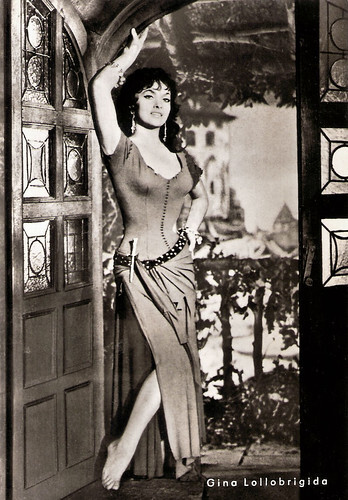
East-German postcard by VEB Progress Film-Vertrieb, Berlin, no. 2/72. Photo: Gina Lollobrigida as beautiful Romani street dancer Esmeralda in Notre-Dame de Paris/The Hunchback of Notre Dame (Jean Delannoy, 1956). The film also stars Anthony Quinn as Quasimodo and Alain Cuny as Frollo. Hugo's Gothic novel 'Notre-Dame de Paris'(1831) details the story of Quasimodo, the disabled bell-ringer of Notre-Dame, as he struggles to stand up to his ableist guardian Claude Frollo, who also wants to commit genocide against Paris' Romani population. The novel has been described as a key text in French literature and has been adapted for films over a dozen times, such as a 1923 silent film with Lon Chaney, a 1939 sound film with Charles Laughton, and a 1996 Disney animated film with Tom Hulce.
The Battle of Hernani
Victor Marie Hugo was born in Besançon, France, in 1802. He was the third son of Joseph Léopold Sigisbert Hugo, a French general under Napoleon's empire from Lorraine, and Sophie Trébuchet, originally from Nantes. Due to his father's profession, Hugo had a difficult childhood and was dragged from town to town by garrison life. Hugo stayed in Paris, in the old monastery des Feuillantines, in Naples, where his father was governor of a province for a while, and in Spain, where his father governed three provinces. Moreover, Hugo's parents were on bad terms with each other and had different political and religious views.
Hugo's mother lived apart from her husband from 1813 onwards and went to live with her son in Paris. On the advice of his father, Hugo went to the Lycée Louis-le-Grand, but it was mainly his mother, a Catholic royalist, who influenced his education and that of his two brothers, Abel and Eugène. It is therefore not surprising that themes such as 'faith' and 'monarchy' appear frequently in Hugo's early work. Hugo made his vocation as a writer known quite early when, at the age of fourteen, he wrote in his diary, "Je veux être Chateaubriand ou rien." (I want to be François René de Chateaubriand or nothing).
At the age of 15, he already received recognition for his poetry from the Académie française. In 1820, he founded with his brothers the literary magazine Le Conservateur littéraire, thus attracting early literary attention. He won the competition of the Académie des Jeux Floraux in Toulouse, of which he was also the laureate the following year. Hugo abandoned his studies of mathematics and threw himself entirely into his literary career. In 1822 his first book of poetry appeared, 'Odes'. Several more books of poetry would follow. In 1824, the collection 'Nouvelles Odes et Poésies diverses' appeared, which earned him a royal allowance from Louis XVIII. However, it was the collection 'Odes et Ballades' (1828), that made him famous. In 1827, he took part in Le Cénacle, a literary circle around writer Charles Nodier that met in the Bibliothèque de l'Arsenal and can be considered the cradle of French Romanticism. He met François René de Chateaubriand, Théophile Gautier, Alfred de Musset and Alfred de Vigny, among others. His participation in this group also meant that he moved to the liberal camp.
In 1822, Hugo married Adèle Foucher, with whom he had been in love since 1819. The marriage also aroused jealousy in his brother Eugène, who would gradually fall prey to insanity. The couple had five children: Léopold (1823), who died a few months after his birth, Léopoldine (1824), Charles (1826), François-Victor (1828) and Adèle (1830). Of these five children, only Adèle would survive her father, although her unstable mental health meant that she often stayed in nursing homes. In the year after his marriage, Hugo published his first novel, the horror novel 'Han d'Islande'. His second novel, 'Bug-Jargal', followed three years later.
From the end of the 1920s, Hugo can be considered the leader of the Romantic Cénacle. He was also attacked and vilified in that capacity by the supporters of academism. Moreover, Hugo also clashed with the censors because of the boldness of some of his plays. His 1829 drama 'Marion de Lorme' was initially banned by the censors because it painted an unflattering picture of the French monarchy. In 1827, he published the never-staged verse drama 'Cromwell', which gained notoriety for its preface in which Hugo attacked the classical rules, including the unity of time and that of place. The preface thus enjoyed the reputation of a manifesto of the Romantic movement.
The big fuss came with the premiere of Hugo's play 'Hernani' in 1830, which is largely forgotten today, except as the basis of Giuseppe Verdi's opera of the same name. 'Hernani' can be considered an important stage in the history of French theatre. The second performance is known as 'la bataille d'Hernani' (The Battle of Hernani). Hugo had already had to defend his play verse by verse to the royal censors and fragments had been leaked to the press, intended to ridicule the work and its author. On the evening of the second performance, Hugo had invited many of his friends (Balzac, Gautier, de Nerval, etc.) to counter the representatives of the classical theatre. The play almost provoked revolts between the opposing camps: classicists versus romantics, republicans versus royalists, and liberals versus conformists. In the theatre, the battle was won by Hugo's supporters, but the press denounced the play. The following performances were still rather unsettled, but the play booked full houses each time. Hugo had succeeded in bringing the romantic innovation, which until then had mainly enthused salon insiders, to the people on stage.
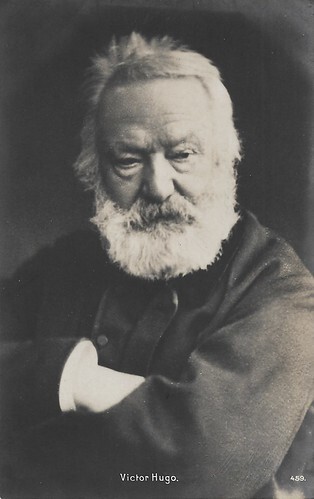
Possibly Belgian postcard, no. 459. Photo: Studio Nadar. The card was mailed in 1912 in Belgium.
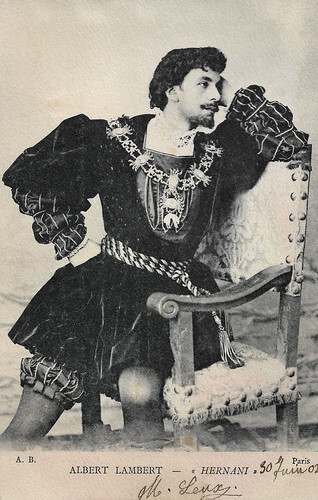
French postcard by A.B. Photo: Albert Lambert in a stage production of 'Hernani' by Victor Hugo. Sent by mail in 1902. Albert Lambert (1865-1941) acted in many plays by Victor Hugo. He entered the reputed Comédie-Française in 1885 with his part in 'Ruy Blas' by Hugo. In 1905, he played Didier in 'Marion Delorme'. His prole was so popular, that he repeated it in 1922. In 1934 he also performed at the London Cambridge Theatre in the lead of Hugo's 'Ruy Blas' (1934).
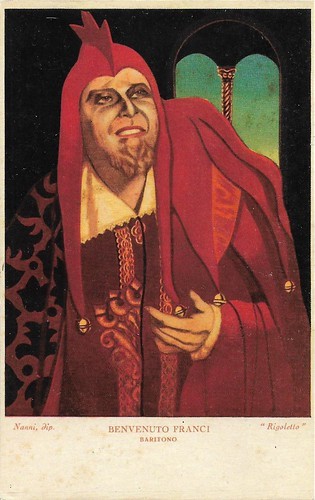
Italian postcard. Artwork by Nanni. Benvenuto Franci in the opera 'Rigoletto'. Although Hugo was not keen on having adaptations of his work set to music, there are several operas based on his work. A famous example is 'Rigoletto' by Giuseppe Verdi (1851), based on 'Le Roi s'amuse'. The Italian baritone Benvenuto Franci (1891-1985) sang Rigoletto in 1931 at Covent Garden in London.
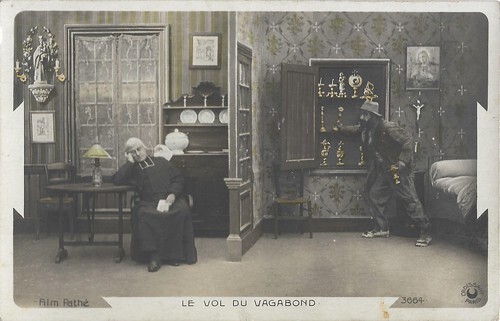
French postcard by Croisant, Paris, no. 3664. Photo: Film Pathé. Publicity still for Le chemineau/The Tramp (Albert Capellani, 1905), based on the first part of Victor Hugo's novel 'Les Misérables'. Unclear is who the actors are, but sets were by Hugues Laurent. The film appeared in the 'Scènes dramatiques et réalistes (8ème Série)' by Pathé.
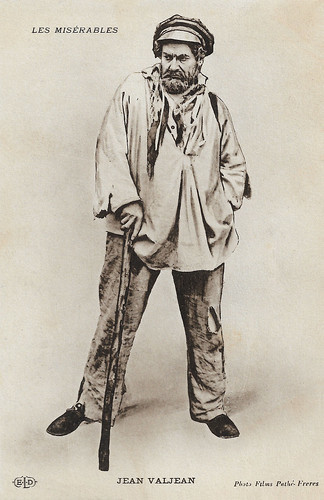
French postcard by ELD. Photo: Films Pathé-Frères. Henry Krauss in Les Misérables (Albert Capellani, 1913). Sent by mail in 1916. French actor and director Henry Krauss (1866-1935) became a star with his interpretations of two characters from novels by Victor Hugo. In 1911 he starred as Quasimodo in Notre Dame de Paris/The Hunchback of Notre-Dame (Albert Capellani, 1911) opposite Stacia Napierkowska as Esmeralda, and in Les Misérables (Albert Capellani, 1913), he was Jean Valjean, relentlessly pursued by the Justice.
A true national hero
Victor Hugo's next play was 'Le roi s'amuse'(1832), which was banned by the censors after one performance because of its open mockery of the French nobility. However, the play became a success in written form. Hugo was so enraged by the ban that he wrote his next play, 'Lucrèce Borgia', in just two weeks. This play was first performed in 1833 and was a great success. Mademoiselle George, a former mistress of Napoleon, played the leading role. Another role was played by the actress Juliette Drouet. Drouet became his muse and mistress and, although Hugo had several romantic escapades during his lifetime, this relationship was recognised and tolerated as quite special even by his wife. Drouet was given the opportunity to play the role of Lady Jane Grey in Hugo's play 'Marie Tudor' (1833), but after the first performance was deemed too light and replaced. She then stopped acting and devoted until her death in 1883 to her lover as an unpaid secretary and travelling companion.
In 1835, Hugo's play 'Angelo' successfully premiered. In 1838, it was the turn of 'Ruy Blas'. That play was the first to be performed at the Théâtre de la Renaissance, the new theatre founded by the Duke of Orléans, a brother of King Louis-Philippe and an admirer of Hugo's work, to stage new plays. Although it is considered to be one of Hugo's best pieces, it was only met with moderate enthusiasm at the time. It would be 1843 before Hugo produced another piece. 'Les Burgraves' ran for 33 nights but lost an audience to a rival play. It would be the last play Hugo wrote. He would write another short verse drama in 1869, 'Torquemada', but this was never intended to be performed and was not published until a few years before his death in 1882.
Hugo's first full-fledged novel, 'Le dernier jour d'un condamné' (The Last Day of a Condemned Man), appeared in 1829 and already showed the social conscience that would later shine through in many of his works. In 1831, Hugo's first major novel was published: 'Notre-Dame de Paris' (The Hunchback of Notre Dame). The work was so successful that it was soon translated into several European languages. In 1834, the documentary novella 'Claude Gueux' was published, telling the story of a real-life murderer being executed in France. This short story would later be regarded by Hugo as a precursor to his immense work on social inequality, 'Les Misérables'. The first steps towards this novel were probably taken around 1830, but it would take until 1862 before the book was completely finished and could be published.
After the coup d'état of Napoleon III, the critical Hugo was threatened with arrest and went into exile on Guernsey. He found new inspiration in his new surroundings and published several famous pamphlets against Napoleon III, such as 'Napoléon le Petit' (The Little Napoleon) and 'Histoire d'un crime' (History of a Crime), in which he condemned Napoleon III's coup d'état on moral grounds. During his stay on Guernsey, he also wrote some of his best works. He published three widely acclaimed books of poetry: 'Les Châtiments' (1853), 'Les Contemplations' (1856) and 'La légende des siècles' (1859-1883). He also published the famous novel 'Les Misérables' (1862). Well aware of the high standard of his work, Hugo decided to award the publication to the highest bidder. That was the Belgian publishing house Lacroix and Verboeckhoven, which sent out press releases six months before publication and launched an unprecedented marketing campaign.
His novel 'Les Travailleurs de la mer' (1866) was dedicated to the island of Guernsey and was well received. In it, Hugo described man's constant struggle against the sea and the creatures living in it. In 1869, the novel 'L'Homme qui rit' was published, which once again tied in with the political and social criticism of 'Les Misérables'. The novel presented a critical image of the aristocracy. However, the novel was not as successful as its predecessor and Hugo himself noticed the distance that was developing between himself and literary contemporaries such as Flaubert and Zola, whose naturalistic novels surpassed his in popularity.
In 1870, Victor Hugo returned to France after Napoleon III was defeated by Prussia at the Battle of Sedan and the Third French Republic was proclaimed. His return to Paris was triumphant. He was received as a true national hero. During the last years of his life, he published 'Religions et religion' (1870) on the limits and possibilities of science, 'L'année terrible' (1872) a poetic commentary on the Commune), his last novel 'Quatre-vingt-treize'(1873) about the Terror after the French Revolution, 'L'Art d'être grand-père' (1877) and 'Les Quatre Vents de l'esprit' (1881). Victor Hugo died in 1885 at the age of 83. His death gave rise to national mourning. His coffin stood for several days under the Arc de Triomphe, from where it was transported to its final resting place in the Panthéon amid massive interest. It is estimated that some three million people paid their last respects.
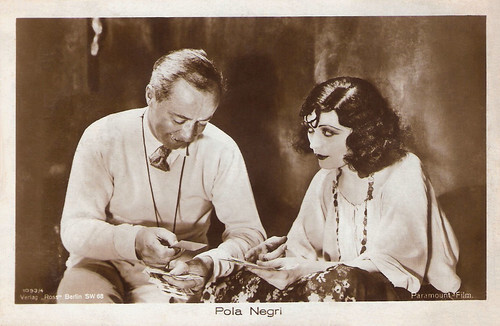
German postcard by Verlag Ross, Berlin, no. 1093/4, 1927-1928. Photo: Paramount-Film. Director Herbert Brenon and Pola Negri during the shooting of the silent film The Spanish Dancer (1923), based on Hugo's popular character of Don César de Bazan, created for his drama 'Ruy Blas'(1838). The Spanish Dancer tells the love story between Don Cesar de Bazan (Antonio Moreno) and the beautiful Gypsy dancer and fortune teller Maritana, played by Pola Negri .
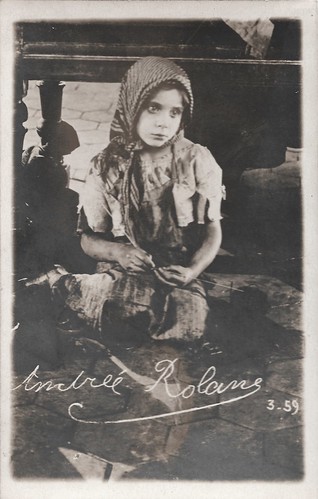
French postcard, no. 3.59. Andrée Rolane as Cosette in Les Misérables (Henri Fescourt, 1925). Andrée Rolane debuted at a very young age as young Cosette in Henri Fescourt's silent version of Les Misérables (1925), with Gabriel Gabrio as Jean Valjean.
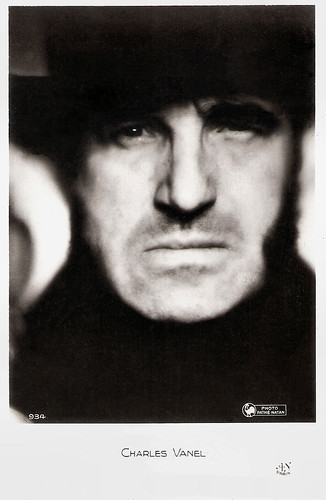
French postcard by A.N. Paris, no. 934. Photo Pathé Natan. Charles Vanel as Javert in Les Misérables (Raymond Bernard, 1934).
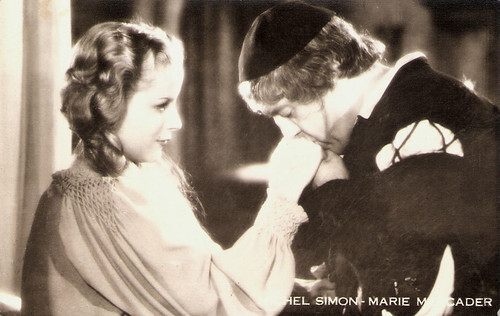
Italian postcard. Photo: María Mercader and Michel Simon in Il re si diverte/The King's Jester (Mario Bonnard, 1941), based on Hugo's novel 'L'homme qui rit'.
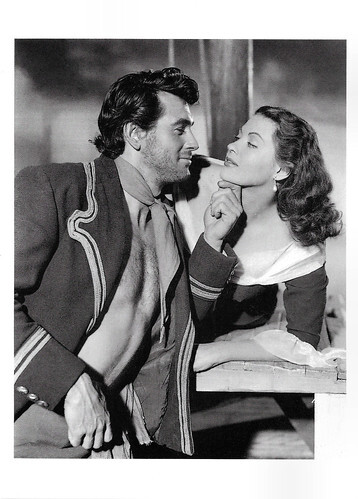
Swiss-German-British postcard by News Productions, Baulmes / Filmwelt Berlin, Bakede / News Productions, Stroud, no. 56493. Rock Hudson as Gilliat and Yvonne De Carlo as Droucette in Sea Devils (Raoul Walsh, 1952), produced by Coronado (RKO). Sea Devils is based on Hugo's 'Les Travailleurs de la mer' (1866). Rock Hudson stars as Gilliat, a jailed fisherman/smuggler who is offered a pardon if he undertakes a mission to sail to France to rescue Droucette, an English agent whose cover has been blown, and who has now been jailed. Gilliat accepts the challenge.
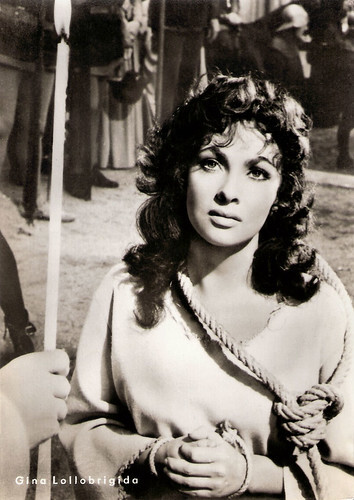
East-German postcard by VEB Progress Film-Vertrieb, Berlin, no. 56/72. Photo: Gina Lollobrigida in Notre-Dame de Paris/The Hunchback of Notre Dame (Jean Delannoy, 1956).
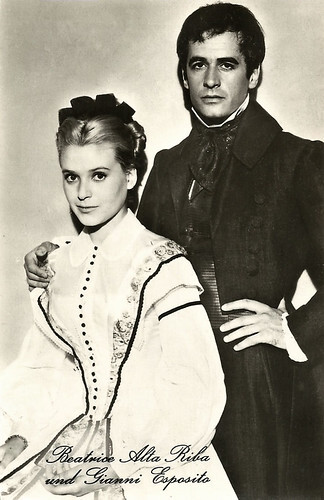
East-German postcard by VEB Progress Film-Vertrieb. Photo: DEFA. Béatrice Altariba as Cosette and Gianni Esposito as Marius in Les misérables (Jean-Paul Le Chanois, 1958).
Sources: Wikipedia (Dutch and English), and IMDb.

French postcard by Croissant, Paris, no. 3664. Photo: Film Pathé. Publicity still for Le chemineau/The Tramp (Albert Capellani, 1905), based on the first part of Victor Hugo's novel 'Les misérables'. Jean Valjean is granted lodging by the parish priest of a village, steals several silver candlesticks but escapes arrest thanks to the false testimony of the priest.

French postcard by FC & Cie, no. 86/2. Photo: A. Bert. Marcelle Géniat in 'Le Roi s'amuse'. French stage and screen actress Marcelle Géniat (1881-1959) made her film debut in Le roi s'amuse/The King Amuses Himself (Albert Capellani, 1909) as Blanche opposite Paul Cappelani as the king and Henry Sylvain as Triboulet. The following decade, an Austrian film version was made, Der König amüsiert sich (Jakob Fleck, Luise Fleck, 1918) starring Hermann Benke as Rigoletto and Liane Haid as his daughter, Blanche. Another adaptation of Hugo's play is the Italian film Il re si diverte/The King's Jester (1941) which starred Michel Simon as Rigoletto and Rossano Brazzi as the king.

German postcard by Ross Verlag, no. 105/1. Photo: Universal Pictures Corp. Conrad Veidt as Gwynplaine and Mary Philbin as the blind Dea in The Man Who Laughs (Paul Leni, 1928), based on Hugo's 1869 novel 'L'homme qui rit'. The Man Who Laughs is a romantic melodrama similar to films such as The Hunchback of Notre Dame. The film is known for the grim Joker-like grin on Gwynplaine's face and is often classified as a horror film. Film critic Roger Ebert stated, "The Man Who Laughs is a melodrama at times even a swashbuckler, but so steeped in expressionist gloom that it plays like a horror film." 'L'homme qui rit' had been filmed twice before. Wikipedia mentions a French Pathé version, L'Homme qui rit (1909) of which no copies are known to survive, and the Austrian film company Olympic-Film released a German version, Das grinsende Gesicht/The Grinning Face (Julius Herska, 1921).

French postcard by A.N., Paris, no. 936. Photo: Pathé Natan. Harry Baur as Jean Valjean in Les Misérables (Raymond Bernard, 1934), based on the novel by Victor Hugo. For six months in 1933 shooting took place in Paris and the South of France. Because of its length, the film was released in two parts. It became Harry Baur ’s best-performed film performance and some say the best film interpretation of Hugo’s famous character. His costars were Charles Vanel as Javert and Josseline Gael as Cosette. Because of the European success, Baur received Hollywood offers but declined. He didn’t want to leave Paris.

East-German postcard by VEB Progress Film-Vertrieb, Berlin, no. 2/72. Photo: Gina Lollobrigida as beautiful Romani street dancer Esmeralda in Notre-Dame de Paris/The Hunchback of Notre Dame (Jean Delannoy, 1956). The film also stars Anthony Quinn as Quasimodo and Alain Cuny as Frollo. Hugo's Gothic novel 'Notre-Dame de Paris'(1831) details the story of Quasimodo, the disabled bell-ringer of Notre-Dame, as he struggles to stand up to his ableist guardian Claude Frollo, who also wants to commit genocide against Paris' Romani population. The novel has been described as a key text in French literature and has been adapted for films over a dozen times, such as a 1923 silent film with Lon Chaney, a 1939 sound film with Charles Laughton, and a 1996 Disney animated film with Tom Hulce.
The Battle of Hernani
Victor Marie Hugo was born in Besançon, France, in 1802. He was the third son of Joseph Léopold Sigisbert Hugo, a French general under Napoleon's empire from Lorraine, and Sophie Trébuchet, originally from Nantes. Due to his father's profession, Hugo had a difficult childhood and was dragged from town to town by garrison life. Hugo stayed in Paris, in the old monastery des Feuillantines, in Naples, where his father was governor of a province for a while, and in Spain, where his father governed three provinces. Moreover, Hugo's parents were on bad terms with each other and had different political and religious views.
Hugo's mother lived apart from her husband from 1813 onwards and went to live with her son in Paris. On the advice of his father, Hugo went to the Lycée Louis-le-Grand, but it was mainly his mother, a Catholic royalist, who influenced his education and that of his two brothers, Abel and Eugène. It is therefore not surprising that themes such as 'faith' and 'monarchy' appear frequently in Hugo's early work. Hugo made his vocation as a writer known quite early when, at the age of fourteen, he wrote in his diary, "Je veux être Chateaubriand ou rien." (I want to be François René de Chateaubriand or nothing).
At the age of 15, he already received recognition for his poetry from the Académie française. In 1820, he founded with his brothers the literary magazine Le Conservateur littéraire, thus attracting early literary attention. He won the competition of the Académie des Jeux Floraux in Toulouse, of which he was also the laureate the following year. Hugo abandoned his studies of mathematics and threw himself entirely into his literary career. In 1822 his first book of poetry appeared, 'Odes'. Several more books of poetry would follow. In 1824, the collection 'Nouvelles Odes et Poésies diverses' appeared, which earned him a royal allowance from Louis XVIII. However, it was the collection 'Odes et Ballades' (1828), that made him famous. In 1827, he took part in Le Cénacle, a literary circle around writer Charles Nodier that met in the Bibliothèque de l'Arsenal and can be considered the cradle of French Romanticism. He met François René de Chateaubriand, Théophile Gautier, Alfred de Musset and Alfred de Vigny, among others. His participation in this group also meant that he moved to the liberal camp.
In 1822, Hugo married Adèle Foucher, with whom he had been in love since 1819. The marriage also aroused jealousy in his brother Eugène, who would gradually fall prey to insanity. The couple had five children: Léopold (1823), who died a few months after his birth, Léopoldine (1824), Charles (1826), François-Victor (1828) and Adèle (1830). Of these five children, only Adèle would survive her father, although her unstable mental health meant that she often stayed in nursing homes. In the year after his marriage, Hugo published his first novel, the horror novel 'Han d'Islande'. His second novel, 'Bug-Jargal', followed three years later.
From the end of the 1920s, Hugo can be considered the leader of the Romantic Cénacle. He was also attacked and vilified in that capacity by the supporters of academism. Moreover, Hugo also clashed with the censors because of the boldness of some of his plays. His 1829 drama 'Marion de Lorme' was initially banned by the censors because it painted an unflattering picture of the French monarchy. In 1827, he published the never-staged verse drama 'Cromwell', which gained notoriety for its preface in which Hugo attacked the classical rules, including the unity of time and that of place. The preface thus enjoyed the reputation of a manifesto of the Romantic movement.
The big fuss came with the premiere of Hugo's play 'Hernani' in 1830, which is largely forgotten today, except as the basis of Giuseppe Verdi's opera of the same name. 'Hernani' can be considered an important stage in the history of French theatre. The second performance is known as 'la bataille d'Hernani' (The Battle of Hernani). Hugo had already had to defend his play verse by verse to the royal censors and fragments had been leaked to the press, intended to ridicule the work and its author. On the evening of the second performance, Hugo had invited many of his friends (Balzac, Gautier, de Nerval, etc.) to counter the representatives of the classical theatre. The play almost provoked revolts between the opposing camps: classicists versus romantics, republicans versus royalists, and liberals versus conformists. In the theatre, the battle was won by Hugo's supporters, but the press denounced the play. The following performances were still rather unsettled, but the play booked full houses each time. Hugo had succeeded in bringing the romantic innovation, which until then had mainly enthused salon insiders, to the people on stage.

Possibly Belgian postcard, no. 459. Photo: Studio Nadar. The card was mailed in 1912 in Belgium.

French postcard by A.B. Photo: Albert Lambert in a stage production of 'Hernani' by Victor Hugo. Sent by mail in 1902. Albert Lambert (1865-1941) acted in many plays by Victor Hugo. He entered the reputed Comédie-Française in 1885 with his part in 'Ruy Blas' by Hugo. In 1905, he played Didier in 'Marion Delorme'. His prole was so popular, that he repeated it in 1922. In 1934 he also performed at the London Cambridge Theatre in the lead of Hugo's 'Ruy Blas' (1934).

Italian postcard. Artwork by Nanni. Benvenuto Franci in the opera 'Rigoletto'. Although Hugo was not keen on having adaptations of his work set to music, there are several operas based on his work. A famous example is 'Rigoletto' by Giuseppe Verdi (1851), based on 'Le Roi s'amuse'. The Italian baritone Benvenuto Franci (1891-1985) sang Rigoletto in 1931 at Covent Garden in London.

French postcard by Croisant, Paris, no. 3664. Photo: Film Pathé. Publicity still for Le chemineau/The Tramp (Albert Capellani, 1905), based on the first part of Victor Hugo's novel 'Les Misérables'. Unclear is who the actors are, but sets were by Hugues Laurent. The film appeared in the 'Scènes dramatiques et réalistes (8ème Série)' by Pathé.

French postcard by ELD. Photo: Films Pathé-Frères. Henry Krauss in Les Misérables (Albert Capellani, 1913). Sent by mail in 1916. French actor and director Henry Krauss (1866-1935) became a star with his interpretations of two characters from novels by Victor Hugo. In 1911 he starred as Quasimodo in Notre Dame de Paris/The Hunchback of Notre-Dame (Albert Capellani, 1911) opposite Stacia Napierkowska as Esmeralda, and in Les Misérables (Albert Capellani, 1913), he was Jean Valjean, relentlessly pursued by the Justice.
A true national hero
Victor Hugo's next play was 'Le roi s'amuse'(1832), which was banned by the censors after one performance because of its open mockery of the French nobility. However, the play became a success in written form. Hugo was so enraged by the ban that he wrote his next play, 'Lucrèce Borgia', in just two weeks. This play was first performed in 1833 and was a great success. Mademoiselle George, a former mistress of Napoleon, played the leading role. Another role was played by the actress Juliette Drouet. Drouet became his muse and mistress and, although Hugo had several romantic escapades during his lifetime, this relationship was recognised and tolerated as quite special even by his wife. Drouet was given the opportunity to play the role of Lady Jane Grey in Hugo's play 'Marie Tudor' (1833), but after the first performance was deemed too light and replaced. She then stopped acting and devoted until her death in 1883 to her lover as an unpaid secretary and travelling companion.
In 1835, Hugo's play 'Angelo' successfully premiered. In 1838, it was the turn of 'Ruy Blas'. That play was the first to be performed at the Théâtre de la Renaissance, the new theatre founded by the Duke of Orléans, a brother of King Louis-Philippe and an admirer of Hugo's work, to stage new plays. Although it is considered to be one of Hugo's best pieces, it was only met with moderate enthusiasm at the time. It would be 1843 before Hugo produced another piece. 'Les Burgraves' ran for 33 nights but lost an audience to a rival play. It would be the last play Hugo wrote. He would write another short verse drama in 1869, 'Torquemada', but this was never intended to be performed and was not published until a few years before his death in 1882.
Hugo's first full-fledged novel, 'Le dernier jour d'un condamné' (The Last Day of a Condemned Man), appeared in 1829 and already showed the social conscience that would later shine through in many of his works. In 1831, Hugo's first major novel was published: 'Notre-Dame de Paris' (The Hunchback of Notre Dame). The work was so successful that it was soon translated into several European languages. In 1834, the documentary novella 'Claude Gueux' was published, telling the story of a real-life murderer being executed in France. This short story would later be regarded by Hugo as a precursor to his immense work on social inequality, 'Les Misérables'. The first steps towards this novel were probably taken around 1830, but it would take until 1862 before the book was completely finished and could be published.
After the coup d'état of Napoleon III, the critical Hugo was threatened with arrest and went into exile on Guernsey. He found new inspiration in his new surroundings and published several famous pamphlets against Napoleon III, such as 'Napoléon le Petit' (The Little Napoleon) and 'Histoire d'un crime' (History of a Crime), in which he condemned Napoleon III's coup d'état on moral grounds. During his stay on Guernsey, he also wrote some of his best works. He published three widely acclaimed books of poetry: 'Les Châtiments' (1853), 'Les Contemplations' (1856) and 'La légende des siècles' (1859-1883). He also published the famous novel 'Les Misérables' (1862). Well aware of the high standard of his work, Hugo decided to award the publication to the highest bidder. That was the Belgian publishing house Lacroix and Verboeckhoven, which sent out press releases six months before publication and launched an unprecedented marketing campaign.
His novel 'Les Travailleurs de la mer' (1866) was dedicated to the island of Guernsey and was well received. In it, Hugo described man's constant struggle against the sea and the creatures living in it. In 1869, the novel 'L'Homme qui rit' was published, which once again tied in with the political and social criticism of 'Les Misérables'. The novel presented a critical image of the aristocracy. However, the novel was not as successful as its predecessor and Hugo himself noticed the distance that was developing between himself and literary contemporaries such as Flaubert and Zola, whose naturalistic novels surpassed his in popularity.
In 1870, Victor Hugo returned to France after Napoleon III was defeated by Prussia at the Battle of Sedan and the Third French Republic was proclaimed. His return to Paris was triumphant. He was received as a true national hero. During the last years of his life, he published 'Religions et religion' (1870) on the limits and possibilities of science, 'L'année terrible' (1872) a poetic commentary on the Commune), his last novel 'Quatre-vingt-treize'(1873) about the Terror after the French Revolution, 'L'Art d'être grand-père' (1877) and 'Les Quatre Vents de l'esprit' (1881). Victor Hugo died in 1885 at the age of 83. His death gave rise to national mourning. His coffin stood for several days under the Arc de Triomphe, from where it was transported to its final resting place in the Panthéon amid massive interest. It is estimated that some three million people paid their last respects.

German postcard by Verlag Ross, Berlin, no. 1093/4, 1927-1928. Photo: Paramount-Film. Director Herbert Brenon and Pola Negri during the shooting of the silent film The Spanish Dancer (1923), based on Hugo's popular character of Don César de Bazan, created for his drama 'Ruy Blas'(1838). The Spanish Dancer tells the love story between Don Cesar de Bazan (Antonio Moreno) and the beautiful Gypsy dancer and fortune teller Maritana, played by Pola Negri .

French postcard, no. 3.59. Andrée Rolane as Cosette in Les Misérables (Henri Fescourt, 1925). Andrée Rolane debuted at a very young age as young Cosette in Henri Fescourt's silent version of Les Misérables (1925), with Gabriel Gabrio as Jean Valjean.

French postcard by A.N. Paris, no. 934. Photo Pathé Natan. Charles Vanel as Javert in Les Misérables (Raymond Bernard, 1934).

Italian postcard. Photo: María Mercader and Michel Simon in Il re si diverte/The King's Jester (Mario Bonnard, 1941), based on Hugo's novel 'L'homme qui rit'.

Swiss-German-British postcard by News Productions, Baulmes / Filmwelt Berlin, Bakede / News Productions, Stroud, no. 56493. Rock Hudson as Gilliat and Yvonne De Carlo as Droucette in Sea Devils (Raoul Walsh, 1952), produced by Coronado (RKO). Sea Devils is based on Hugo's 'Les Travailleurs de la mer' (1866). Rock Hudson stars as Gilliat, a jailed fisherman/smuggler who is offered a pardon if he undertakes a mission to sail to France to rescue Droucette, an English agent whose cover has been blown, and who has now been jailed. Gilliat accepts the challenge.

East-German postcard by VEB Progress Film-Vertrieb, Berlin, no. 56/72. Photo: Gina Lollobrigida in Notre-Dame de Paris/The Hunchback of Notre Dame (Jean Delannoy, 1956).

East-German postcard by VEB Progress Film-Vertrieb. Photo: DEFA. Béatrice Altariba as Cosette and Gianni Esposito as Marius in Les misérables (Jean-Paul Le Chanois, 1958).
Sources: Wikipedia (Dutch and English), and IMDb.
Published on November 05, 2022 23:00
November 4, 2022
Körkarlen (1921)
Victor Sjöström's poetic and touching Körkarlen/The Phantom Carriage (Victor Sjöström, 1921) is considered by many film critics the best Swedish film of all time. The silent masterpiece is one of Sjöström's adaptations of the novellas by Selma Lagerlöf. Sjöström himself plays the down-and-out alcoholic, David Holm, who neglects a wish of a dying woman and is forced to take over the phantom carriage for a full year, collecting the souls of the dead. The film was produced by AB Svensk Filmindustri and Förlag Nordisk Konst in Stockholm made a series of wonderful sepia postcards for the film.
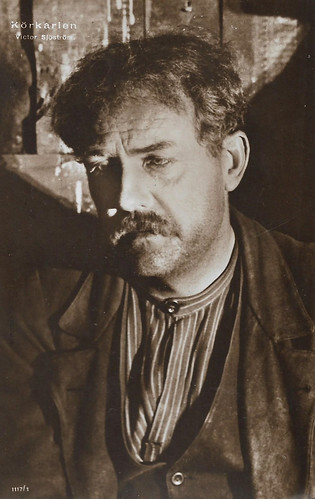
Swedish postcard by Förlag Nordisk Konst, Stockholm, no. 1117/1. Photo: Svensk Filmindustri. Victor Sjöström in Körkarlen/The Phantom Carriage (Victor Sjöström, 1921).
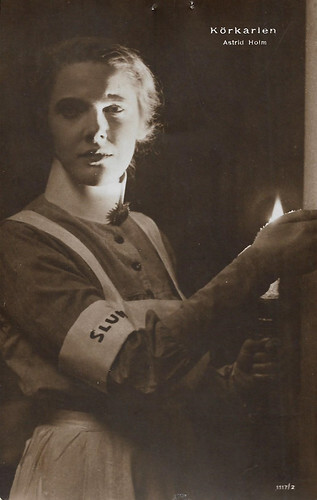
Swedish postcard by Förlag Nordisk Konst, Stockholm, no. 1117/2. Photo: Svensk Filmindustri. Astrid Holm in Körkarlen/The Phantom Carriage (Victor Sjöström, 1921).
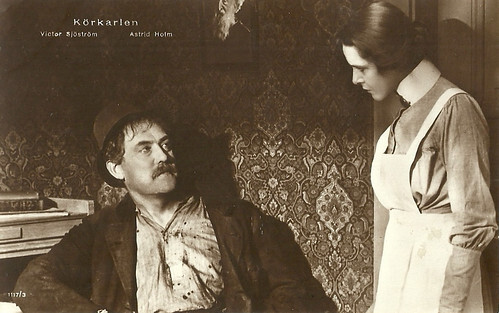
Swedish postcard by Förlag Nordisk Konst, Stockholm, no. 1117/3. Photo: Svensk Filmindustri. Victor Sjöström and Astrid Holm in Körkarlen/The Phantom Carriage (Victor Sjöström, 1921).
The legend of the Phantom Carriage
In Körkarlen/The Phantom Carriage (1920), the terminally ill Salvation Army nurse Edit (Astrid Holm) asks on New Year's Eve, her younger companions Maria (Lisa Lundholm) and Gustafsson (Tor Weijden) for one last wish: that they bring David Holm ( Victor Sjöström ) to her deathbed.
Meanwhile, David, a down-and-out alcoholic, gets drunk with two drinking buddies in a cemetery. He tells them about his former friend Georges (Tore Svennberg), who once told him the legend of the Phantom Carriage. This states that the last person to die in the old year is required by Death to collect the souls of the deceased in his carriage for the duration of the following year until the burden is transferred to a new person at the end of the year.
Gustafsson finds David in the cemetery and tries to persuade him to pay Edit his last visit, but he refuses. An argument breaks out with his cronies over his harsh rejection of the request, in the course of which David is mortally wounded. The carriage of death appears, driven by Georges. The latter had died a year ago on New Year's night and declared David his successor.
Georges takes David on a trip down memory lane to his once happy family life with his wife Anna Holm (Hilda Borgström) and their two children. This ended when David got involved with Georges and his drinking companions. He had to serve a prison sentence for drunkenness but professed to be on the mend when he was released. However, when he returned home to find that his wife had left him, he went back on his vow.
On New Year's Eve a year ago, David sought out the Salvation Army dormitory. Despite the warning of her fellow sister, Edit mended his coat without disinfecting it first, contracting tuberculosis in the process. The next morning, as a parting taunt, David promises to call on her next year at the same time so she can see if her prayers for his salvation have been answered. Georges points out to David that this promise must now be fulfilled.
In further flashbacks, we see how Edit, although she had fallen in love with the fallen man, snatched him from his milieu to reunite him with his wife. David, however, soon fell back into his former habits and threatened his family. In a fit of frenzy, after his wife locked him in the kitchen, he smashed the door with an axe. When the carriage enters Edit's room with David, she at first pleads for her life until she recognises David.
She blames herself for the fate of his family since she had reunited him with his wife at the time. The remorseful David kisses her hands, whereupon Edit dies in peace. Georges then brings David to Anna, who is about to kill her children and herself out of despair. In an act of selflessness, David begs God to prevent the desperate act, even if he has to pay for it eternally. As a result, he gets his life back. David and Anna embrace each other in tears.
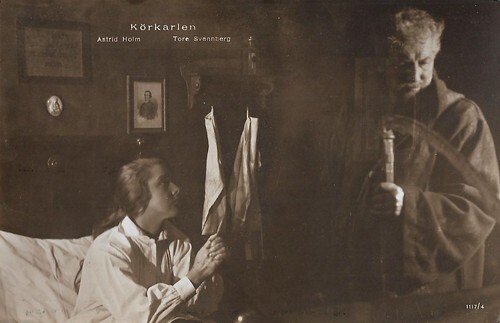
Swedish postcard by Förlag Nordisk Konst, Stockholm, no. 1117/4. Photo: Svensk Filmindustri. Astrid Holm and Tore Svennberg in Körkarlen/The Phantom Carriage (Victor Sjöström, 1921).
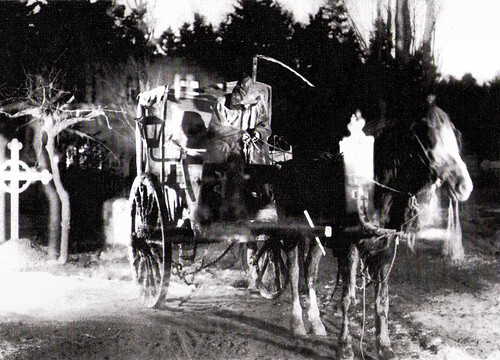
Italian programme card for Il Cinema Ritrovata 2003. Photo: publicity still for Körkarlen/The Phantom Carriage (Victor Sjöström, 1921).
Intensive use of special effects
As early as 1917, A-B Svenska Biografteater, whose merger with Filmindustri AB Scandia created AB Svensk Filmindustri in 1919, had signed a contract with Selma Lagerlöf to bring one of her works to the screen each year. In 1920, Victor Sjöström had already filmed three novels since the contract was signed: Tösen från Stormyrtorpet/The Girl from the Marsh Croft (Victor Sjöström, 1917), Ingmarssönerna/Sons of Ingmar (1919) and Karin Ingmarsdotter/God's Way/Karin Daughter of Ingmar (1920). The latter two were both based on chapters of Lagerlöf's novel 'Jerusalem' (1901-1902), about religious emigrants from Sweden to Palestine. Lagerlöf would win the Nobel Prize for Literature for 'Jerusalem'. Victor Sjöström's film adaptations had been consistently well received by critics, audiences and Lagerlöf herself.
Since the productions had all been set in rural surroundings, Sjöström chose the urban-themed novella 'Körkarlen' (Thy Soul Shall Bear Witness!) as his new project, Körkarlen/The Phantom Carriage (1921). Filming took place at Filmstaden Studios in Solna between May and July 1920. The studio buildings were inspired by the southern Swedish town of Landskrona. Lagerlöf originally wanted to have the film shot on location in Landskrona, but Sjöström decided on a studio production due to the technical possibilities.
The post-production turned out to be an unusually elaborate affair for cinematographer Julius Jaenzon and lab supervisor Eugén Hellman due to the intensive use of special effects. Jaenzon had previously worked with double exposure in Herr Arnes pengar/Sir Arne's Treasure (Mauritz Stiller, 1919), another Lagerlöf adaptation in which Victor Sjöström was not involved, but in this case, several image layers were superimposed. In this way, it was made possible for the ghost figures to move in the picture in three-dimensional space. As soon as they stood in front of a solid object, it shone through the transparent body. This technical achievement must be rated all the more highly because it must be remembered that the cameras in use at the time were still operated with hand cranks.
Körkarlen/The Phantom Carriage (Victor Sjöström, 1920) premiered at 1 January 1921, New Year's Eve. It was a success at the time and is now seen as one of the classics of Swedish silent cinema. In the Lexicon des internationalen Films, Josef Nagel reviewed the film as follows: "An impressive cinematic 'eerie ballad' based on the novel by Selma Lagerlöf. Within the complex narrative and flashback structure, mystical elements meet realistic scenes that denounce social ills resulting from industrialisation. Thanks to great emotional moments, the film unfolds in an atmospherically dense way despite its rather pedagogical, didactic message."
The film had a lasting influence on the work of Ingmar Bergman , who used the character of Death in Det sjunde inseglet/The Seventh Seal (1957) and created a direct reference to the carter of Körkarlen/The Phantom Carriage (1921) by titling him "disciplinarian." In addition, Bergman enlisted Sjöström to star in Smultronstället/Wild Strawberries (1957). It was his final role. Bergman once reported that he had first watched Körkarlen at the age of 15 and every year since. In 2000, Ingmar Bergman made the TV drama Bildmakarna/The Image Makers (2000), which fictionalised the story of the making of Körkarlen/The Phantom Carriage (1920) with Anita Björk as Selma Lagerlöf and Lennart Hjulström as Victor Sjöström .
Remakes were directed by Julien Duvivier, La charrette fantôme/The Phantom Carriage (1939) starring Pierre Fresnay and Marie Bell , and by Arne Mattsson Körkarlen/The Phantom Carriage (1958) with George Fant, Ulla Jacobsson and Anita Björk . In 2012, Körkarlen/The Phantom Carriage (1921) was named the best Swedish film of all time by 50 film critics and connoisseurs in a poll conducted by the Swedish film magazine FLM.
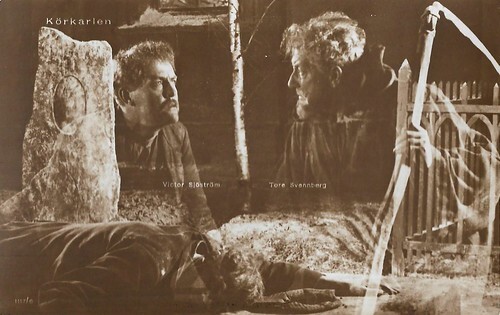
Swedish postcard by Förlag Nordisk Konst, Stockholm, no. 1117/6. Photo: Svensk Filmindustri. Victor Sjöström and Tore Svennberg in Körkarlen/The Phantom Carriage, (Victor Sjöström, 1921).
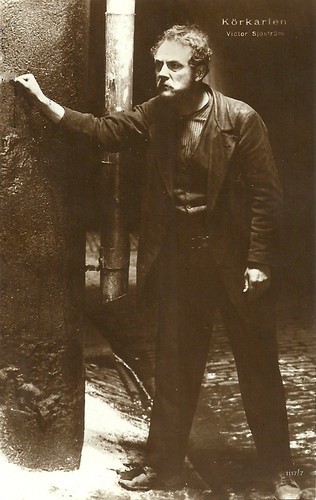
Swedish postcard by Förlag Nordisk Konst, Stockholm, no. 1117/7. Photo: Svensk Filmindustri. Victor Sjöström in Körkarlen/The Phantom Carriage, (Victor Sjöström, 1921).
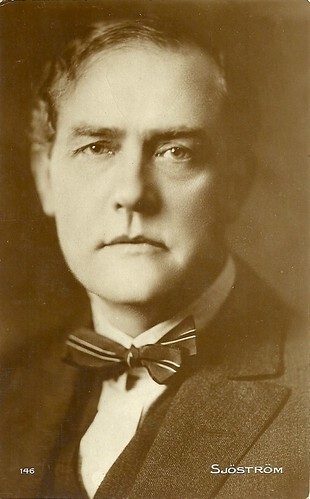
French postcard by Editions Cinémagazine, no. 146. Victor Sjöström.
Sources: Wikipedia (German and English), and IMDb.

Swedish postcard by Förlag Nordisk Konst, Stockholm, no. 1117/1. Photo: Svensk Filmindustri. Victor Sjöström in Körkarlen/The Phantom Carriage (Victor Sjöström, 1921).

Swedish postcard by Förlag Nordisk Konst, Stockholm, no. 1117/2. Photo: Svensk Filmindustri. Astrid Holm in Körkarlen/The Phantom Carriage (Victor Sjöström, 1921).

Swedish postcard by Förlag Nordisk Konst, Stockholm, no. 1117/3. Photo: Svensk Filmindustri. Victor Sjöström and Astrid Holm in Körkarlen/The Phantom Carriage (Victor Sjöström, 1921).
The legend of the Phantom Carriage
In Körkarlen/The Phantom Carriage (1920), the terminally ill Salvation Army nurse Edit (Astrid Holm) asks on New Year's Eve, her younger companions Maria (Lisa Lundholm) and Gustafsson (Tor Weijden) for one last wish: that they bring David Holm ( Victor Sjöström ) to her deathbed.
Meanwhile, David, a down-and-out alcoholic, gets drunk with two drinking buddies in a cemetery. He tells them about his former friend Georges (Tore Svennberg), who once told him the legend of the Phantom Carriage. This states that the last person to die in the old year is required by Death to collect the souls of the deceased in his carriage for the duration of the following year until the burden is transferred to a new person at the end of the year.
Gustafsson finds David in the cemetery and tries to persuade him to pay Edit his last visit, but he refuses. An argument breaks out with his cronies over his harsh rejection of the request, in the course of which David is mortally wounded. The carriage of death appears, driven by Georges. The latter had died a year ago on New Year's night and declared David his successor.
Georges takes David on a trip down memory lane to his once happy family life with his wife Anna Holm (Hilda Borgström) and their two children. This ended when David got involved with Georges and his drinking companions. He had to serve a prison sentence for drunkenness but professed to be on the mend when he was released. However, when he returned home to find that his wife had left him, he went back on his vow.
On New Year's Eve a year ago, David sought out the Salvation Army dormitory. Despite the warning of her fellow sister, Edit mended his coat without disinfecting it first, contracting tuberculosis in the process. The next morning, as a parting taunt, David promises to call on her next year at the same time so she can see if her prayers for his salvation have been answered. Georges points out to David that this promise must now be fulfilled.
In further flashbacks, we see how Edit, although she had fallen in love with the fallen man, snatched him from his milieu to reunite him with his wife. David, however, soon fell back into his former habits and threatened his family. In a fit of frenzy, after his wife locked him in the kitchen, he smashed the door with an axe. When the carriage enters Edit's room with David, she at first pleads for her life until she recognises David.
She blames herself for the fate of his family since she had reunited him with his wife at the time. The remorseful David kisses her hands, whereupon Edit dies in peace. Georges then brings David to Anna, who is about to kill her children and herself out of despair. In an act of selflessness, David begs God to prevent the desperate act, even if he has to pay for it eternally. As a result, he gets his life back. David and Anna embrace each other in tears.

Swedish postcard by Förlag Nordisk Konst, Stockholm, no. 1117/4. Photo: Svensk Filmindustri. Astrid Holm and Tore Svennberg in Körkarlen/The Phantom Carriage (Victor Sjöström, 1921).

Italian programme card for Il Cinema Ritrovata 2003. Photo: publicity still for Körkarlen/The Phantom Carriage (Victor Sjöström, 1921).
Intensive use of special effects
As early as 1917, A-B Svenska Biografteater, whose merger with Filmindustri AB Scandia created AB Svensk Filmindustri in 1919, had signed a contract with Selma Lagerlöf to bring one of her works to the screen each year. In 1920, Victor Sjöström had already filmed three novels since the contract was signed: Tösen från Stormyrtorpet/The Girl from the Marsh Croft (Victor Sjöström, 1917), Ingmarssönerna/Sons of Ingmar (1919) and Karin Ingmarsdotter/God's Way/Karin Daughter of Ingmar (1920). The latter two were both based on chapters of Lagerlöf's novel 'Jerusalem' (1901-1902), about religious emigrants from Sweden to Palestine. Lagerlöf would win the Nobel Prize for Literature for 'Jerusalem'. Victor Sjöström's film adaptations had been consistently well received by critics, audiences and Lagerlöf herself.
Since the productions had all been set in rural surroundings, Sjöström chose the urban-themed novella 'Körkarlen' (Thy Soul Shall Bear Witness!) as his new project, Körkarlen/The Phantom Carriage (1921). Filming took place at Filmstaden Studios in Solna between May and July 1920. The studio buildings were inspired by the southern Swedish town of Landskrona. Lagerlöf originally wanted to have the film shot on location in Landskrona, but Sjöström decided on a studio production due to the technical possibilities.
The post-production turned out to be an unusually elaborate affair for cinematographer Julius Jaenzon and lab supervisor Eugén Hellman due to the intensive use of special effects. Jaenzon had previously worked with double exposure in Herr Arnes pengar/Sir Arne's Treasure (Mauritz Stiller, 1919), another Lagerlöf adaptation in which Victor Sjöström was not involved, but in this case, several image layers were superimposed. In this way, it was made possible for the ghost figures to move in the picture in three-dimensional space. As soon as they stood in front of a solid object, it shone through the transparent body. This technical achievement must be rated all the more highly because it must be remembered that the cameras in use at the time were still operated with hand cranks.
Körkarlen/The Phantom Carriage (Victor Sjöström, 1920) premiered at 1 January 1921, New Year's Eve. It was a success at the time and is now seen as one of the classics of Swedish silent cinema. In the Lexicon des internationalen Films, Josef Nagel reviewed the film as follows: "An impressive cinematic 'eerie ballad' based on the novel by Selma Lagerlöf. Within the complex narrative and flashback structure, mystical elements meet realistic scenes that denounce social ills resulting from industrialisation. Thanks to great emotional moments, the film unfolds in an atmospherically dense way despite its rather pedagogical, didactic message."
The film had a lasting influence on the work of Ingmar Bergman , who used the character of Death in Det sjunde inseglet/The Seventh Seal (1957) and created a direct reference to the carter of Körkarlen/The Phantom Carriage (1921) by titling him "disciplinarian." In addition, Bergman enlisted Sjöström to star in Smultronstället/Wild Strawberries (1957). It was his final role. Bergman once reported that he had first watched Körkarlen at the age of 15 and every year since. In 2000, Ingmar Bergman made the TV drama Bildmakarna/The Image Makers (2000), which fictionalised the story of the making of Körkarlen/The Phantom Carriage (1920) with Anita Björk as Selma Lagerlöf and Lennart Hjulström as Victor Sjöström .
Remakes were directed by Julien Duvivier, La charrette fantôme/The Phantom Carriage (1939) starring Pierre Fresnay and Marie Bell , and by Arne Mattsson Körkarlen/The Phantom Carriage (1958) with George Fant, Ulla Jacobsson and Anita Björk . In 2012, Körkarlen/The Phantom Carriage (1921) was named the best Swedish film of all time by 50 film critics and connoisseurs in a poll conducted by the Swedish film magazine FLM.

Swedish postcard by Förlag Nordisk Konst, Stockholm, no. 1117/6. Photo: Svensk Filmindustri. Victor Sjöström and Tore Svennberg in Körkarlen/The Phantom Carriage, (Victor Sjöström, 1921).

Swedish postcard by Förlag Nordisk Konst, Stockholm, no. 1117/7. Photo: Svensk Filmindustri. Victor Sjöström in Körkarlen/The Phantom Carriage, (Victor Sjöström, 1921).

French postcard by Editions Cinémagazine, no. 146. Victor Sjöström.
Sources: Wikipedia (German and English), and IMDb.
Published on November 04, 2022 23:00
November 3, 2022
Woody Allen
American actor-writer-director Woody Allen (1935) is best known for his romantic comedies Annie Hall (1977) and Manhattan (1979). He has written and directed over 50 films and has written numerous stories, plays and columns. In his films, Allen frequently plays a neurotic New Yorker and often bases them on his own life experiences. He received 24 Oscar nominations and won the award four times.
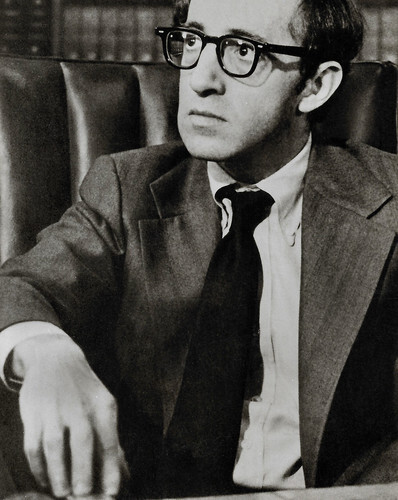
East-German postcard by Progress Film-Verleih, Berlin, no. 71/78. Woody Allen in The Front (Martin Ritt, 1976).

French postcard in the Collection Magie Noire by Editions Hazan, Paris, no. 6273, 1991. Woody Allen in Hannah and Her Sisters (Woody Allen, 1986).

French postcard by Humour a la Carte, Paris, no. ST-146. (Woody Allen is mistakenly written as Woody Halen at the backside).
Spies searching for the secret recipe for egg salad
Woody Allen was born in 1935, as Allan Stewart Konigsberg in Brooklyn, NY. He was the son of Martin Konigsberg and Nettie Konigsberg and has one younger sister, film producer Letty Aronson. The family lived in Flatbush, a Jewish neighbourhood. As a young boy, Allan became intrigued with magic tricks and playing the clarinet, two hobbies that he continues today.
Allan broke into show business at 15 years when he started writing jokes for a local paper, receiving $200 a week. Thanks to his talent and the connections he made, he was soon allowed to work for entertainment stars like Sid Caesar. He started to use the stage name 'Woody Allen' for which he borrowed 'Woody' from the clarinettist Woody Herman. At 17, he changed his civil name to Heywood Allen. He chose the first name 'Heywood' in reference to jazz pianist Eddie Heywood.
In 1956, Allen married the seventeen-year-old philosophy student Harlene Rosen. The young couple moved to Manhattan. In this period, Woody rose from gag supplier to scriptwriter for TV shows such as The Ed Sullivan Show and The Tonight Show. In 1957, nominated for an Emmy, he stepped out of the shadow of his clients and in front of the camera for the first time.
Despite his lucrative job, Allen took a Communications Arts Course at New York University - for the sake of his parents - but was hardly ever seen there. A formative event of his student days was probably that, following the advice of his dean, he went to see a psychoanalyst. His marriage to Harlene fell apart. The couple separated and the marriage ended in divorce in 1962. Until Harlene was the main subject of his gags until 1969 when she sued him for two million dollars.
Woody felt that his jokes for the TV shows were being wasted. His agents, Charles Joffe and Jack Rollins convinced him to start doing stand-up and telling his own jokes. Reluctantly he agreed and, although he initially performed with such fear of the audience that he would cover his ears when they applauded his jokes, he eventually became very successful at stand-up. With his unusual intellectual style and made-up stories from his private life, he was well on his way to becoming a national celebrity.
Allen was approached to write a script for Warren Beatty to star in What's New Pussycat (Clive Donner, 1965). He would also have a moderate role as a character in the film. During production, Woody gave himself more and better lines and left Beatty with less compelling dialogue. Beatty inevitably quit the project and was replaced by Peter Sellers , who demanded all the best lines and more screen time. It was from this experience that Allen realised that he could not work on a film without complete control over its production.
Woody took his first steps in the new medium using the same formula that had brought him such great success on the stage. His theoretical directorial debut was What's Up, Tiger Lily? (Senkichi Taniguchi, Woody Allen, 1966). This was a Japanese spy flick that he dubbed over with his own comedic dialogue about spies searching for the secret recipe for egg salad. His real directorial debut came the next year with the mockumentary Take the Money and Run (Woody Allen, 1969). In the next decades, he wrote, directed and, more often than not, starred in about a film a year. Simultaneously, he wrote more than a dozen plays and several comedy books.
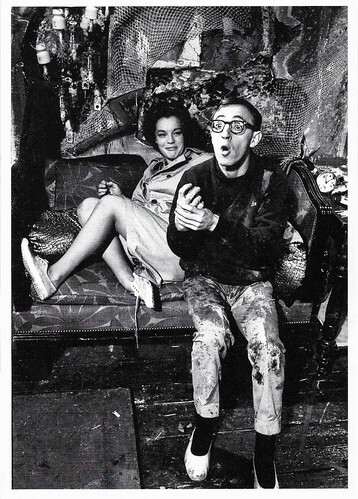
Swiss-German postcard by News Productions / artconcept, no. 0103-6100284. Photo: Larry Shaw. Woody Allen and Romy Schneider in What's New Pussycat (Clive Donner, 1965).
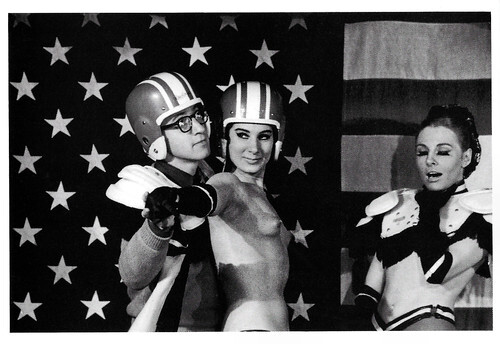
Swiss-German-British postcard by News Productions, Baulmes / Filmwelt Berlin, Bakede / News Productions, Stroud, no. 56570 Photo: Larry Shaw. Caption: Woody Allen at the Crazy Horse, Paris, 1965.
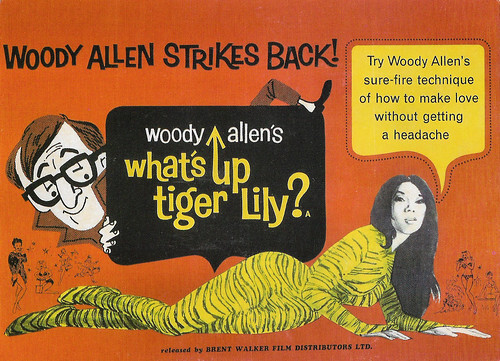
British postcard by Brent Walker Film Distributors LTD. Poster for What's Up Tiger Lily? (Woody Allen, Senkichi Taniguchi, 1966). In Woody Allen's directorial debut, he took the Japanese spy film Kokusai himitsu keisatsu: Kagi no kagi/International Secret Police: Key of Keys (Senkichi Taniguchi, 1965), the fourth instalment of five films in the Kokusai himitsu keisatsu series, and completely changed the tone of the film into a comedy about the search for the world's best egg salad recipe.
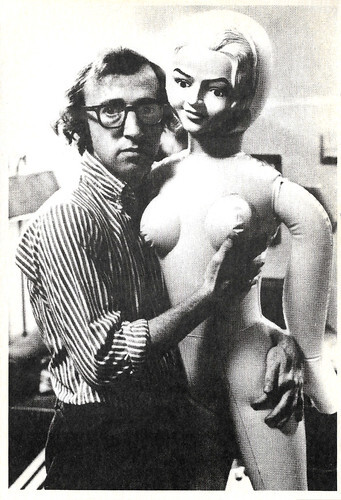
French postcard by Editions cinema, no. 115. Woody Allen in Bananas (Woody Allen, 1971).
Many transitions in his films throughout the years
Woody Allen met the young actress Louise Lasser. They married in 1966, but in 1971 the marriage was divorced again. However, Lasser played big roles in such films as Bananas (1971) and Everything You Always Wanted to Know About Sex* (*But Were Afraid to Ask) (1972), a hilarious satire of the enlightenment films of the 1960s. These films and also the Science Fiction comedy Sleeper (1973) and Love and Death (1975) are seen as the 'early, funny ones' in Allen's career as a film director and are characterised above all by their combination of absurd linguistic and visual wit.
Allen has made many transitions in his films throughout the years. In 1972, he starred in Play It Again, Sam which he also wrote, based on his own 1969 Broadway play of the same name, but which was directed by Herbert Ross. Allen played a recently divorced film critic, Allan Felix, who identifies with the film Casablanca (Michael Curtiz, 1942) and the character Rick Blaine as played by Humphrey Bogart . He is urged to begin dating again by his best friend Dick but falls in love with Dick's wife, played by Diane Keaton, who became also in real life his partner.
From the mid-1970s onwards, the humorous element in his films was pushed back in favour of a more dramatically ambitious plot. Diane Keaton often acted as a partner and female lead in the acclaimed hits Annie Hall (1977), and Manhattan (1979). The last part of this so-called New York trilogy, Stardust Memories (1980), borrows heavily from Federico Fellini 's 8½ (1963). Set in New York, it is about a filmmaker and his great contempt for his audience. Like its two predecessors, Stardust Memories is clearly autobiographical in tone, even though Allen later claimed that there were no parallels between the protagonist of his film and himself.
At the end of the decade, Mia Farrow entered his life, and from then on, she appeared in very different roles in his 'Bergmanesque' dramas including Interiors (1978), September (1987) and Another Woman (1988). Some critics accused Allen of only wanting to copy Ingmar Bergman but they overlooked Allen's independent approach. In Crimes and Misdemeanors (1989), he depicts a deadly murder mystery but does not avoid occasional comedic elements. This film was Allen's first collaboration with Bergman cinematographer Sven Nykvist. Allen's comedies became tragicomedies with more elaborate stories, often taking place in several levels of action and reality such as The Purple Rose of Cairo (1985). With Hannah and Her Sisters (1986), Allen once again achieved great success, both commercially and with the critics. The film won three Oscars and the one for best screenplay went to Woody Allen.
His A Midsummer Night's Sex Comedy (1982) was influenced by William Shakespeare 's 'A Midsummer Night's Dream' and its amorous entanglements. Zelig (1983) is a satire about a person who, chameleon-like, constantly adapts to his environment, and becomes a Hasidic Jew among Hasidic Jews and a Nazi among Nazis. In this film, which is seemingly staged like a documentary with clips from newsreels, Allen portrays a man whose impersonality causes him to drift through the ages. In Broadway Danny Rose (1984), Allen tells the story of a New York artist agent who gets lost in mafia circles and portrays the milieu of standup comedians that was the basis for his own career.
The film Husbands and Wives (1992) marked the end of the professional collaboration between Allen and Mia Farrow. Their relationship fell apart when Farrow discovered nude photographs taken by Allen in 1992 of her 21-year-old adopted daughter Soon-Yi Previn and Allen subsequently admitted to the relationship with her. A nasty court battle over custody of the remaining children followed. Farrow publicly accused Allen of sexually abusing their adopted daughter, the seven-year-old Dylan Farrow. The allegation gained substantial media attention, but Allen was never charged or prosecuted, and he vehemently denied the allegation. Allen married Previn in 1997, and they adopted two children.
During the 1990s, Allen gradually found a new style in films. His tragicomedies were replaced by films that again seem lighter and more upbeat. Examples are Bullets Over Broadway (1994) with an Oscar-winning Dianne Wiest, Mighty Aphrodite (1995) for which Mira Sorvino won an Oscar, and Deconstructing Harry (1997). In the new century, he returned after some lesser films with his acclaimed thriller Match Point (2005). Many critics spoke of a new, reinvigorated Allen. It was his first film set and produced exclusively in London and thus the first film of his 'European phase'. His next two films, the crime comedy Scoop (2006) and the drama Cassandra's Dream (2007) were also set in London. In the latter, Colin Farrell and Ewan McGregor played two brothers in London's working-class milieu who drift into crime. The comedy Vicky Cristina Barcelona (2008) was set in Spain and starred Scarlett Johansson, Javier Bardem and Penélope Cruz, who won an Oscar for Best Actress in a Supporting Role for her performance.
The romantic comedy Midnight in Paris (2011) about a successful US screenwriter (Owen Wilson) who is transported back to 1920s Paris opened the 64th Cannes Film Festival. The film was a huge success both at the box office and with critics. Allen received an Oscar and a Golden Globe for the screenplay in 2012. In addition, Midnight in Paris received Oscar nominations in the categories Best Picture, Best Director and Best Production Design. Although his stories and style have changed over the years, Woody Allen is regarded as one of the best filmmakers of our time because of his views on art and his mastery of filmmaking. In the past ten years, films such as To Rome with Love (2012), Blue Jasmine (2013) and Café Society (2016) followed. At the time of writing this post, Allen is in Paris shooting his yet-untitled new film. It will be his 50th.
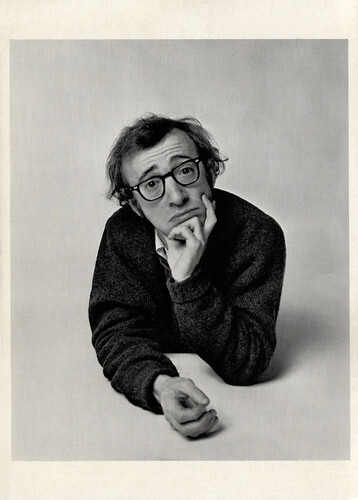
American postcard by Fotofolio, New York, N.Y. Photo: Philippe Halsman, 1969.
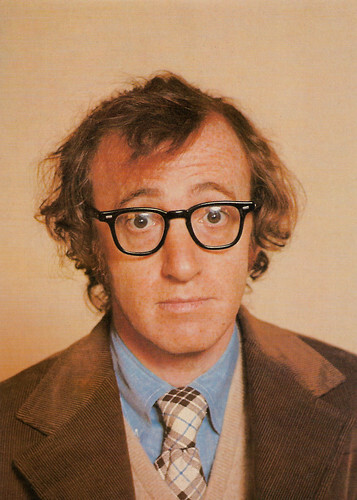
British postcard by Star-Graphics, London, no. S 120.
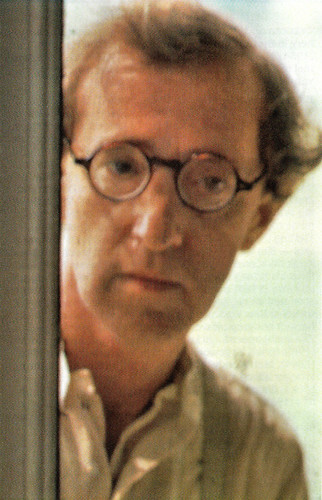
Dutch collectors card. Woody Allen in A Midsummer Night's Sex Comedy (Woody Allen, 1982).
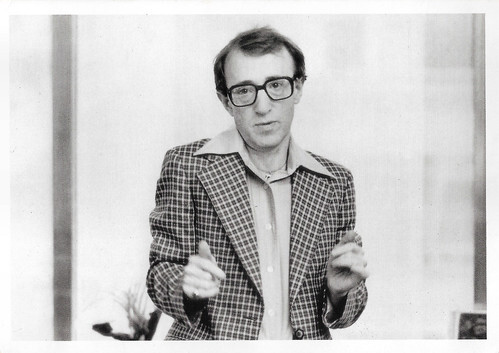
French postcard in the Collection "Portraits de Cinema" (6e série), no. 10, by Editions Admira, Aix-en Provence, no. PHN 862, 1990. Photo: Snap Photo / Cosmos. Woody Allen in Broadway Danny Rose (Woody Allen, 1984).
Sources: (IMDb), Wikipedia (German, English and Dutch), and .

East-German postcard by Progress Film-Verleih, Berlin, no. 71/78. Woody Allen in The Front (Martin Ritt, 1976).

French postcard in the Collection Magie Noire by Editions Hazan, Paris, no. 6273, 1991. Woody Allen in Hannah and Her Sisters (Woody Allen, 1986).

French postcard by Humour a la Carte, Paris, no. ST-146. (Woody Allen is mistakenly written as Woody Halen at the backside).
Spies searching for the secret recipe for egg salad
Woody Allen was born in 1935, as Allan Stewart Konigsberg in Brooklyn, NY. He was the son of Martin Konigsberg and Nettie Konigsberg and has one younger sister, film producer Letty Aronson. The family lived in Flatbush, a Jewish neighbourhood. As a young boy, Allan became intrigued with magic tricks and playing the clarinet, two hobbies that he continues today.
Allan broke into show business at 15 years when he started writing jokes for a local paper, receiving $200 a week. Thanks to his talent and the connections he made, he was soon allowed to work for entertainment stars like Sid Caesar. He started to use the stage name 'Woody Allen' for which he borrowed 'Woody' from the clarinettist Woody Herman. At 17, he changed his civil name to Heywood Allen. He chose the first name 'Heywood' in reference to jazz pianist Eddie Heywood.
In 1956, Allen married the seventeen-year-old philosophy student Harlene Rosen. The young couple moved to Manhattan. In this period, Woody rose from gag supplier to scriptwriter for TV shows such as The Ed Sullivan Show and The Tonight Show. In 1957, nominated for an Emmy, he stepped out of the shadow of his clients and in front of the camera for the first time.
Despite his lucrative job, Allen took a Communications Arts Course at New York University - for the sake of his parents - but was hardly ever seen there. A formative event of his student days was probably that, following the advice of his dean, he went to see a psychoanalyst. His marriage to Harlene fell apart. The couple separated and the marriage ended in divorce in 1962. Until Harlene was the main subject of his gags until 1969 when she sued him for two million dollars.
Woody felt that his jokes for the TV shows were being wasted. His agents, Charles Joffe and Jack Rollins convinced him to start doing stand-up and telling his own jokes. Reluctantly he agreed and, although he initially performed with such fear of the audience that he would cover his ears when they applauded his jokes, he eventually became very successful at stand-up. With his unusual intellectual style and made-up stories from his private life, he was well on his way to becoming a national celebrity.
Allen was approached to write a script for Warren Beatty to star in What's New Pussycat (Clive Donner, 1965). He would also have a moderate role as a character in the film. During production, Woody gave himself more and better lines and left Beatty with less compelling dialogue. Beatty inevitably quit the project and was replaced by Peter Sellers , who demanded all the best lines and more screen time. It was from this experience that Allen realised that he could not work on a film without complete control over its production.
Woody took his first steps in the new medium using the same formula that had brought him such great success on the stage. His theoretical directorial debut was What's Up, Tiger Lily? (Senkichi Taniguchi, Woody Allen, 1966). This was a Japanese spy flick that he dubbed over with his own comedic dialogue about spies searching for the secret recipe for egg salad. His real directorial debut came the next year with the mockumentary Take the Money and Run (Woody Allen, 1969). In the next decades, he wrote, directed and, more often than not, starred in about a film a year. Simultaneously, he wrote more than a dozen plays and several comedy books.

Swiss-German postcard by News Productions / artconcept, no. 0103-6100284. Photo: Larry Shaw. Woody Allen and Romy Schneider in What's New Pussycat (Clive Donner, 1965).

Swiss-German-British postcard by News Productions, Baulmes / Filmwelt Berlin, Bakede / News Productions, Stroud, no. 56570 Photo: Larry Shaw. Caption: Woody Allen at the Crazy Horse, Paris, 1965.

British postcard by Brent Walker Film Distributors LTD. Poster for What's Up Tiger Lily? (Woody Allen, Senkichi Taniguchi, 1966). In Woody Allen's directorial debut, he took the Japanese spy film Kokusai himitsu keisatsu: Kagi no kagi/International Secret Police: Key of Keys (Senkichi Taniguchi, 1965), the fourth instalment of five films in the Kokusai himitsu keisatsu series, and completely changed the tone of the film into a comedy about the search for the world's best egg salad recipe.

French postcard by Editions cinema, no. 115. Woody Allen in Bananas (Woody Allen, 1971).
Many transitions in his films throughout the years
Woody Allen met the young actress Louise Lasser. They married in 1966, but in 1971 the marriage was divorced again. However, Lasser played big roles in such films as Bananas (1971) and Everything You Always Wanted to Know About Sex* (*But Were Afraid to Ask) (1972), a hilarious satire of the enlightenment films of the 1960s. These films and also the Science Fiction comedy Sleeper (1973) and Love and Death (1975) are seen as the 'early, funny ones' in Allen's career as a film director and are characterised above all by their combination of absurd linguistic and visual wit.
Allen has made many transitions in his films throughout the years. In 1972, he starred in Play It Again, Sam which he also wrote, based on his own 1969 Broadway play of the same name, but which was directed by Herbert Ross. Allen played a recently divorced film critic, Allan Felix, who identifies with the film Casablanca (Michael Curtiz, 1942) and the character Rick Blaine as played by Humphrey Bogart . He is urged to begin dating again by his best friend Dick but falls in love with Dick's wife, played by Diane Keaton, who became also in real life his partner.
From the mid-1970s onwards, the humorous element in his films was pushed back in favour of a more dramatically ambitious plot. Diane Keaton often acted as a partner and female lead in the acclaimed hits Annie Hall (1977), and Manhattan (1979). The last part of this so-called New York trilogy, Stardust Memories (1980), borrows heavily from Federico Fellini 's 8½ (1963). Set in New York, it is about a filmmaker and his great contempt for his audience. Like its two predecessors, Stardust Memories is clearly autobiographical in tone, even though Allen later claimed that there were no parallels between the protagonist of his film and himself.
At the end of the decade, Mia Farrow entered his life, and from then on, she appeared in very different roles in his 'Bergmanesque' dramas including Interiors (1978), September (1987) and Another Woman (1988). Some critics accused Allen of only wanting to copy Ingmar Bergman but they overlooked Allen's independent approach. In Crimes and Misdemeanors (1989), he depicts a deadly murder mystery but does not avoid occasional comedic elements. This film was Allen's first collaboration with Bergman cinematographer Sven Nykvist. Allen's comedies became tragicomedies with more elaborate stories, often taking place in several levels of action and reality such as The Purple Rose of Cairo (1985). With Hannah and Her Sisters (1986), Allen once again achieved great success, both commercially and with the critics. The film won three Oscars and the one for best screenplay went to Woody Allen.
His A Midsummer Night's Sex Comedy (1982) was influenced by William Shakespeare 's 'A Midsummer Night's Dream' and its amorous entanglements. Zelig (1983) is a satire about a person who, chameleon-like, constantly adapts to his environment, and becomes a Hasidic Jew among Hasidic Jews and a Nazi among Nazis. In this film, which is seemingly staged like a documentary with clips from newsreels, Allen portrays a man whose impersonality causes him to drift through the ages. In Broadway Danny Rose (1984), Allen tells the story of a New York artist agent who gets lost in mafia circles and portrays the milieu of standup comedians that was the basis for his own career.
The film Husbands and Wives (1992) marked the end of the professional collaboration between Allen and Mia Farrow. Their relationship fell apart when Farrow discovered nude photographs taken by Allen in 1992 of her 21-year-old adopted daughter Soon-Yi Previn and Allen subsequently admitted to the relationship with her. A nasty court battle over custody of the remaining children followed. Farrow publicly accused Allen of sexually abusing their adopted daughter, the seven-year-old Dylan Farrow. The allegation gained substantial media attention, but Allen was never charged or prosecuted, and he vehemently denied the allegation. Allen married Previn in 1997, and they adopted two children.
During the 1990s, Allen gradually found a new style in films. His tragicomedies were replaced by films that again seem lighter and more upbeat. Examples are Bullets Over Broadway (1994) with an Oscar-winning Dianne Wiest, Mighty Aphrodite (1995) for which Mira Sorvino won an Oscar, and Deconstructing Harry (1997). In the new century, he returned after some lesser films with his acclaimed thriller Match Point (2005). Many critics spoke of a new, reinvigorated Allen. It was his first film set and produced exclusively in London and thus the first film of his 'European phase'. His next two films, the crime comedy Scoop (2006) and the drama Cassandra's Dream (2007) were also set in London. In the latter, Colin Farrell and Ewan McGregor played two brothers in London's working-class milieu who drift into crime. The comedy Vicky Cristina Barcelona (2008) was set in Spain and starred Scarlett Johansson, Javier Bardem and Penélope Cruz, who won an Oscar for Best Actress in a Supporting Role for her performance.
The romantic comedy Midnight in Paris (2011) about a successful US screenwriter (Owen Wilson) who is transported back to 1920s Paris opened the 64th Cannes Film Festival. The film was a huge success both at the box office and with critics. Allen received an Oscar and a Golden Globe for the screenplay in 2012. In addition, Midnight in Paris received Oscar nominations in the categories Best Picture, Best Director and Best Production Design. Although his stories and style have changed over the years, Woody Allen is regarded as one of the best filmmakers of our time because of his views on art and his mastery of filmmaking. In the past ten years, films such as To Rome with Love (2012), Blue Jasmine (2013) and Café Society (2016) followed. At the time of writing this post, Allen is in Paris shooting his yet-untitled new film. It will be his 50th.

American postcard by Fotofolio, New York, N.Y. Photo: Philippe Halsman, 1969.

British postcard by Star-Graphics, London, no. S 120.

Dutch collectors card. Woody Allen in A Midsummer Night's Sex Comedy (Woody Allen, 1982).

French postcard in the Collection "Portraits de Cinema" (6e série), no. 10, by Editions Admira, Aix-en Provence, no. PHN 862, 1990. Photo: Snap Photo / Cosmos. Woody Allen in Broadway Danny Rose (Woody Allen, 1984).
Sources: (IMDb), Wikipedia (German, English and Dutch), and .
Published on November 03, 2022 23:00
November 2, 2022
Cécile Aubry
The petite, blue-eyed blonde Cécile Aubry (1928-2010) was often seen as the predecessor of Brigitte Bardot as the French cinema's sex kitten. In 1949 she was discovered by noted filmmaker Henri-Georges Clouzot and after her first film Manon, she became and instant star. Her acting career was successful but brief: during the late 1940s through the mid-1950s she made seven films before she retired to marry a prince from Morocco in 1956. After her divorce, Aubry started a second career in France as a writer of children’s books, which she also adapted for television. The TV series with the boy Sebastien, played by her own son Mehdi, became a classic.
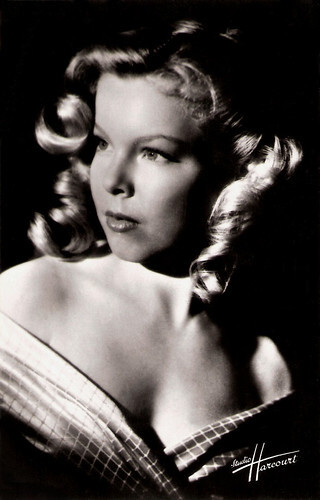
French postcard by Editions O.P, Paris, no. 55. Photo: Studio Harcourt.
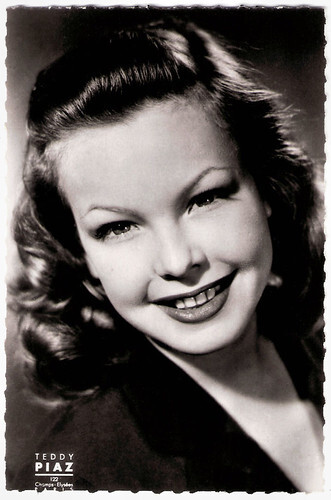
French postcard by Editions O.P, Paris, no. 48. Photo: Teddy Piaz.
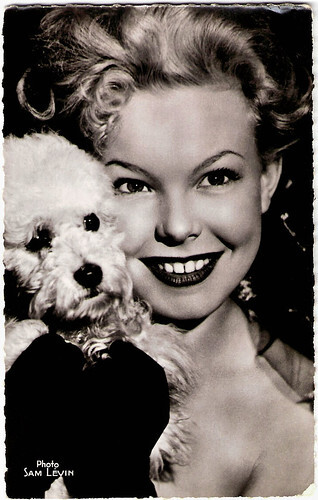
French postcard by Editions du Globe, Paris, no. 145. Photo: Sam Lévin.
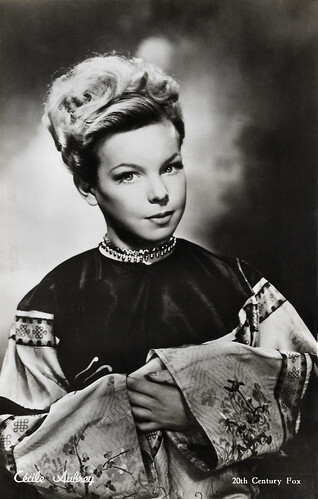
Vintage card. Photo: 20th Century Fox. Cecile Aubry in The Black Rose (Henry Hathaway, 1950).
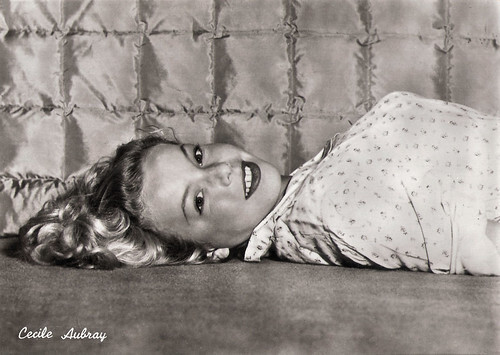
Italian postcard by Bromofoto, Milano, no. 265.
Seductive Pout
Cécile Aubry was born Anne-José Madeleine Henriette Bénard in Paris, France, in 1928. Her family was well-to-do, and Cécile had an English governess and a personal dance teacher. In her late teens, she studied acting at the Cours Simon, where she was discovered by famous film director Henri-Georges Clouzot.
Clouzot fell immediately for her ingenuity, her green bronze eyes, her blond hair and her seductive pout. He offered the 20-year-old Aubry the title role in Manon (Henri-Georges Clouzot, 1949), opposite Serge Reggiani and Michel Auclair . In this dark adaptation of Abbé Prévost's 18th-century novel Manon Lescaut, set in post-World War II, she played a capricious, luxury-seeking young woman who corrupts her lover.
Aubry managed to bring out the duality of the character – both femme fatale and femme enfant. She was a sensation. The film won the Golden Lion at the Venice Film Festival in 1949 and the 20-years-old Cécile landed on the cover of Life. In the accompanying article, the magazine described her as a “frisky, pert, sugar-and-spice bundle of adolescence.”
Ronald Bergan described in The Guardian what happened next: "in a blaze of typical Hollywood publicity, Cécile Aubry was signed up by 20th Century-Fox to co-star with Tyrone Power and Orson Welles in Henry Hathaway's The Black Rose. It was to be Aubry's only American film, placing her among several French actresses who had short-lived Hollywood careers after the liberation of France in 1944."
In her next, European film, Barbe-bleu/Bluebeard (Christian Jacque, 1951) she appeared as the last wife of Bluebeard, played in the French version by Pierre Brasseur and in the German version by Hans Albers . She performed a silhouetted striptease that left little to the imagination.
In the following years, she only appeared in a few more films, including Piovuto dal cielo/Fallen From the Sky (Leonardo De Mitri, 1953) and Tanz in der Sonne/Dance in the Sun (Géza von Cziffra, 1954) with Franco Andrei . None of these films were successful.
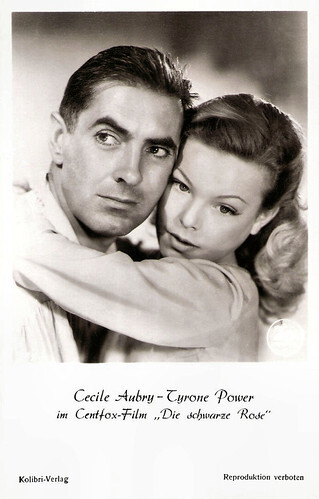
German postcard by Kolibri-Verlag. Photo: 20th Century Fox. Still from The Black Rose (1950) with Tyrone Power .
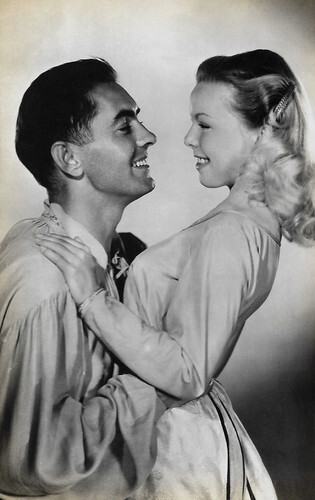
Spanish postcard by Sobe, no. 652. Tyrone Power and Cecile Aubry in The Black Rose (Henry Hathaway, 1950).
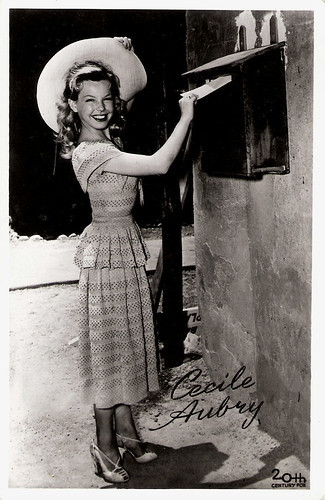
Dutch postcard by Uitg. Takken, Utrecht, no. 377. Photo: 20th Century Fox.
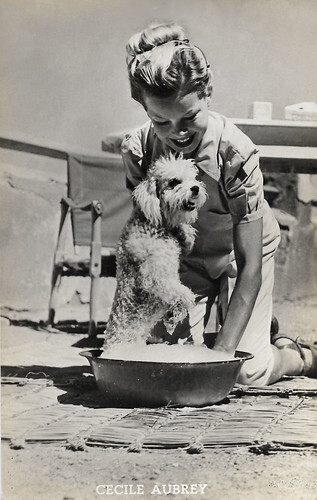
Belgian postcard. Photo: 20th Century Fox.
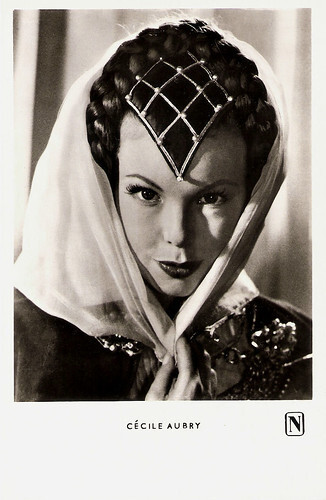
German postcard by Kunst und Bild, Berlin. Photo: publicity still for Barbe-Bleue/Bluebeard (Christian-Jaque, 1951).
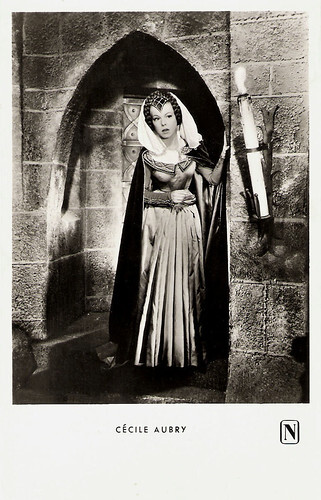
German postcard by Kunst und Bild, Berlin, no. A 410. Photo: publicity still for Barbe-Bleue/Bluebeard (Christian-Jaque, 1951).
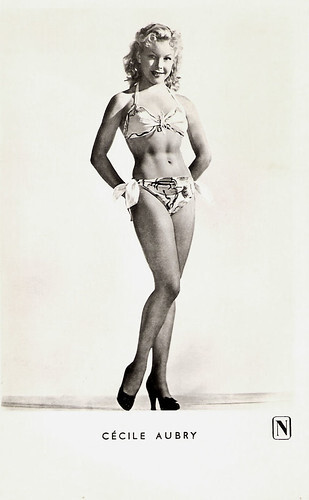
German postcard by Kunst und Bild, Berlin.
Secret marriage
Cécile Aubry stopped acting after her marriage to Si Brahim El Glaoui, caïd (local administrator) of Telouet and the oldest son of T'hami El Glaoui, pasha of Marrakech. During the filming of The Black Rose in the dunes of the Moroccan Atlas mountains, the couple had met when he visited the set. In 1955, they married in secret because Aubry thought that a marriage would harm her Hollywood career. In 1956, she announced her retirement from the cinema and reportedly said that she had only enjoyed film acting for its travel opportunities.
Their marriage lasted till 1959. After the divorce, she moved back to France. Aubry started a second successful career as a writer of children’s books. Her son Mehdi El Glaoui (only credited as Mehdi) later played roles in the French long-running TV series Poly (1961-1973) about a boy and his Shetland pony, and in the three series around Sébastien (1965-1970). These series were all written and directed by Aubry.
The most popular of these series was Belle et Sébastien/Belle and Sebastian (Cécile Aubry, 1965), which tells the adventures of a young orphan boy, Sébastien, in a small village in the Pyrenees, and the white Pyrenean Mountain Dog, Belle, whom he finds wandering through the mountains. Aubrey's series was broadcasted all over Europe during the 1960s. Later she also wrote and directed the series Le jeune Fabre/The Young Fabre (1973), again with Mehdi in the lead, now as a teenager.
Belle et Sébastien was adapted in 1981 for a Japanese animated series, Meiken Jolie, which was itself translated into English. The Scottish rock band Belle and Sebastian took its name from Aubry’s series too. Cécile Aubry last lived in a restored historic mill in the countryside, in Dourdan, near Paris. In 2010, she died of lung cancer, two weeks before her 82nd birthday.
In 2013, Belle et Sébastien was filmed again, but now for the cinema. In Belle et Sébastien/Belle and Sebastian (Nicolas Vanier, 2013), the six-year-old boy and his dog look to foil a Nazi effort to capture French Resistance fighters. Sébastien was played by Félix Bossuet and Mehdi El Glaoui played a supporting part. This film came only after Aubry's death, as she had consistently opposed it. There were a sequel, Belle et Sébastien, l'aventure continue (Christian Duguay, 2015) and the animation series Belle et Sébastien/Belle and Sebastian (Jean-Philippe Robin, 2017). A new film version, Belle et Sébastien: Nouvelle génération/ Belle and Sebastian - A new generation (Pierre Coré, 2022), followed this year.
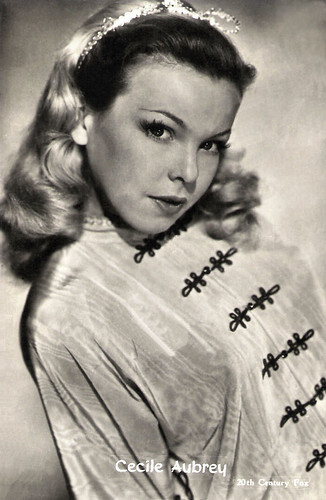
Dutch postcard. Photo: 20th Century Fox.
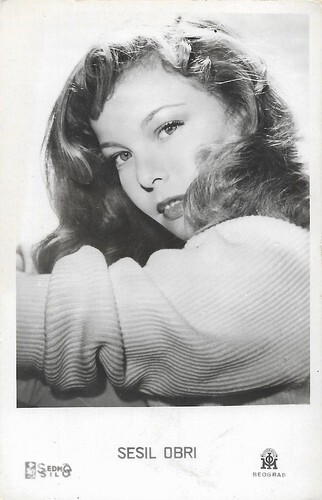
Yugoslavian postcard by Sedma Sila. Photo: Morava Film, Beograd (Belgrade).
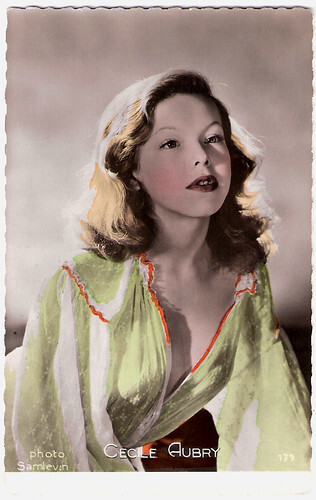
French postcard by Editions P.I., Paris, no. 179. Photo: Sam Lévin.
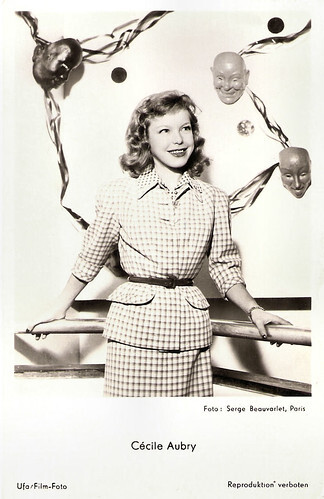
West-German postcard by Ufa, Berlin-Tempelhof, no. FK 629. Photo: Serge Beauvarlet, Paris.
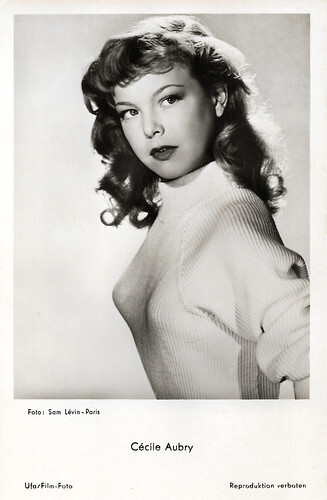
West-German postcard by Ufa/Film-Foto, Berlin-Tempelhof, no. FK-1014. Photo: Sam Lévin, Paris.
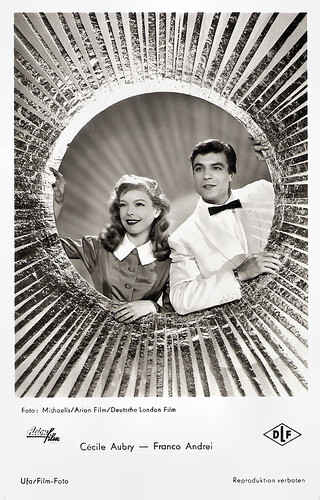
West-German postcard by Ufa, Berlin-Tempelhof, no. FK 1145. Photo: Michaelis / Arion Film / Deutsche London Film. Cécile Aubry and Franco Andrei in Tanz in der Sonne/Dance in the Sun (Géza von Cziffra, 1954).
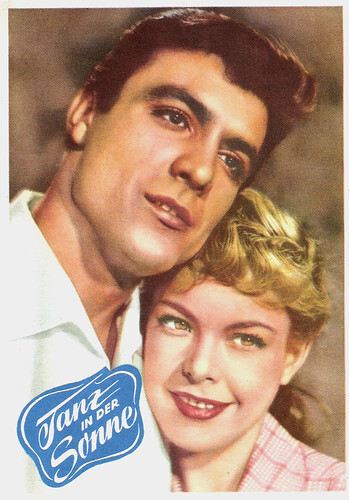
West-German postcard, offered by Cinema Capitole, Luxembourg. Franco Andrei and Cécile Aubry in Tanz in der Sonne/Dance in the Sun (Géza von Cziffra, 1954).
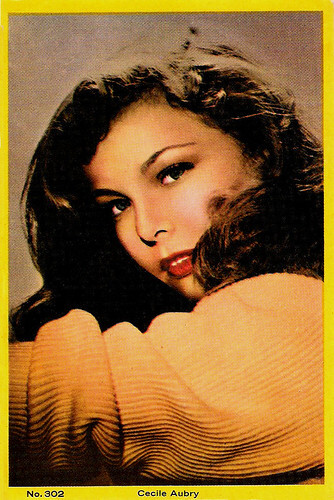
Mexican Collectors card, no. 302.
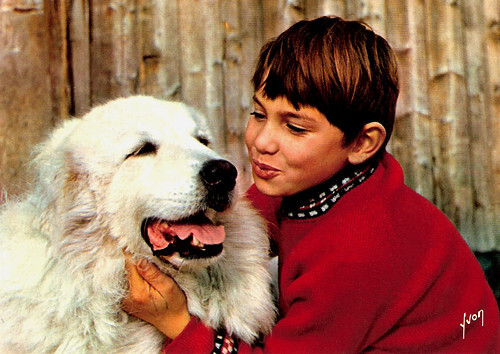
French postcard by Editions d'art Yvon, Paris, no. 6. Photo: RTF / Gaumont. Mehdi El Glaoui as Sebastien in the film and TV series Sébastien parmi les hommes (Cécile Aubry, 1968).
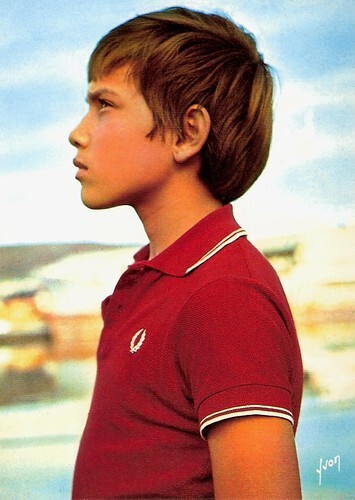
French postcard by Editions d'art Yvon, Paris. Photo: RTF, Gaumont Télévision International and Téléclip. Mehdi El Glaoui as Sebastien in the film and TV series Sebastien et la Mary-Morgane (Cécile Aubry, 1970).
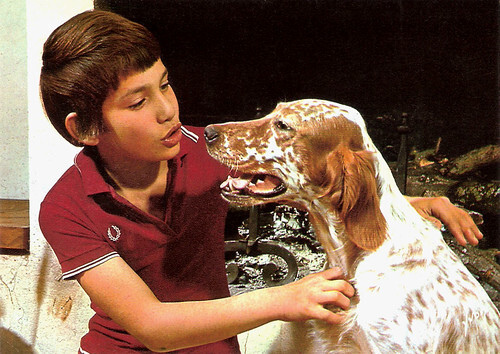
French postcard by Editions d'art Yvon, Paris, no. 40/001-19. Photo: RTF / Gaumont / Téléclip. Mehdi El Glaoui in Sebastien et la Mary-Morgane (Cécile Aubry, 1970).
Sources: Marlene Pilaete (L'encinémathèque - now defunct), Ronald Bergan (The Guardian), Bruce Weber (The New York Times), Thomas Staedeli (Cyranos), Sandra Brennan (AllMovie), Wikipedia, and .

French postcard by Editions O.P, Paris, no. 55. Photo: Studio Harcourt.

French postcard by Editions O.P, Paris, no. 48. Photo: Teddy Piaz.

French postcard by Editions du Globe, Paris, no. 145. Photo: Sam Lévin.

Vintage card. Photo: 20th Century Fox. Cecile Aubry in The Black Rose (Henry Hathaway, 1950).

Italian postcard by Bromofoto, Milano, no. 265.
Seductive Pout
Cécile Aubry was born Anne-José Madeleine Henriette Bénard in Paris, France, in 1928. Her family was well-to-do, and Cécile had an English governess and a personal dance teacher. In her late teens, she studied acting at the Cours Simon, where she was discovered by famous film director Henri-Georges Clouzot.
Clouzot fell immediately for her ingenuity, her green bronze eyes, her blond hair and her seductive pout. He offered the 20-year-old Aubry the title role in Manon (Henri-Georges Clouzot, 1949), opposite Serge Reggiani and Michel Auclair . In this dark adaptation of Abbé Prévost's 18th-century novel Manon Lescaut, set in post-World War II, she played a capricious, luxury-seeking young woman who corrupts her lover.
Aubry managed to bring out the duality of the character – both femme fatale and femme enfant. She was a sensation. The film won the Golden Lion at the Venice Film Festival in 1949 and the 20-years-old Cécile landed on the cover of Life. In the accompanying article, the magazine described her as a “frisky, pert, sugar-and-spice bundle of adolescence.”
Ronald Bergan described in The Guardian what happened next: "in a blaze of typical Hollywood publicity, Cécile Aubry was signed up by 20th Century-Fox to co-star with Tyrone Power and Orson Welles in Henry Hathaway's The Black Rose. It was to be Aubry's only American film, placing her among several French actresses who had short-lived Hollywood careers after the liberation of France in 1944."
In her next, European film, Barbe-bleu/Bluebeard (Christian Jacque, 1951) she appeared as the last wife of Bluebeard, played in the French version by Pierre Brasseur and in the German version by Hans Albers . She performed a silhouetted striptease that left little to the imagination.
In the following years, she only appeared in a few more films, including Piovuto dal cielo/Fallen From the Sky (Leonardo De Mitri, 1953) and Tanz in der Sonne/Dance in the Sun (Géza von Cziffra, 1954) with Franco Andrei . None of these films were successful.

German postcard by Kolibri-Verlag. Photo: 20th Century Fox. Still from The Black Rose (1950) with Tyrone Power .

Spanish postcard by Sobe, no. 652. Tyrone Power and Cecile Aubry in The Black Rose (Henry Hathaway, 1950).

Dutch postcard by Uitg. Takken, Utrecht, no. 377. Photo: 20th Century Fox.

Belgian postcard. Photo: 20th Century Fox.

German postcard by Kunst und Bild, Berlin. Photo: publicity still for Barbe-Bleue/Bluebeard (Christian-Jaque, 1951).

German postcard by Kunst und Bild, Berlin, no. A 410. Photo: publicity still for Barbe-Bleue/Bluebeard (Christian-Jaque, 1951).

German postcard by Kunst und Bild, Berlin.
Secret marriage
Cécile Aubry stopped acting after her marriage to Si Brahim El Glaoui, caïd (local administrator) of Telouet and the oldest son of T'hami El Glaoui, pasha of Marrakech. During the filming of The Black Rose in the dunes of the Moroccan Atlas mountains, the couple had met when he visited the set. In 1955, they married in secret because Aubry thought that a marriage would harm her Hollywood career. In 1956, she announced her retirement from the cinema and reportedly said that she had only enjoyed film acting for its travel opportunities.
Their marriage lasted till 1959. After the divorce, she moved back to France. Aubry started a second successful career as a writer of children’s books. Her son Mehdi El Glaoui (only credited as Mehdi) later played roles in the French long-running TV series Poly (1961-1973) about a boy and his Shetland pony, and in the three series around Sébastien (1965-1970). These series were all written and directed by Aubry.
The most popular of these series was Belle et Sébastien/Belle and Sebastian (Cécile Aubry, 1965), which tells the adventures of a young orphan boy, Sébastien, in a small village in the Pyrenees, and the white Pyrenean Mountain Dog, Belle, whom he finds wandering through the mountains. Aubrey's series was broadcasted all over Europe during the 1960s. Later she also wrote and directed the series Le jeune Fabre/The Young Fabre (1973), again with Mehdi in the lead, now as a teenager.
Belle et Sébastien was adapted in 1981 for a Japanese animated series, Meiken Jolie, which was itself translated into English. The Scottish rock band Belle and Sebastian took its name from Aubry’s series too. Cécile Aubry last lived in a restored historic mill in the countryside, in Dourdan, near Paris. In 2010, she died of lung cancer, two weeks before her 82nd birthday.
In 2013, Belle et Sébastien was filmed again, but now for the cinema. In Belle et Sébastien/Belle and Sebastian (Nicolas Vanier, 2013), the six-year-old boy and his dog look to foil a Nazi effort to capture French Resistance fighters. Sébastien was played by Félix Bossuet and Mehdi El Glaoui played a supporting part. This film came only after Aubry's death, as she had consistently opposed it. There were a sequel, Belle et Sébastien, l'aventure continue (Christian Duguay, 2015) and the animation series Belle et Sébastien/Belle and Sebastian (Jean-Philippe Robin, 2017). A new film version, Belle et Sébastien: Nouvelle génération/ Belle and Sebastian - A new generation (Pierre Coré, 2022), followed this year.

Dutch postcard. Photo: 20th Century Fox.

Yugoslavian postcard by Sedma Sila. Photo: Morava Film, Beograd (Belgrade).

French postcard by Editions P.I., Paris, no. 179. Photo: Sam Lévin.

West-German postcard by Ufa, Berlin-Tempelhof, no. FK 629. Photo: Serge Beauvarlet, Paris.

West-German postcard by Ufa/Film-Foto, Berlin-Tempelhof, no. FK-1014. Photo: Sam Lévin, Paris.

West-German postcard by Ufa, Berlin-Tempelhof, no. FK 1145. Photo: Michaelis / Arion Film / Deutsche London Film. Cécile Aubry and Franco Andrei in Tanz in der Sonne/Dance in the Sun (Géza von Cziffra, 1954).

West-German postcard, offered by Cinema Capitole, Luxembourg. Franco Andrei and Cécile Aubry in Tanz in der Sonne/Dance in the Sun (Géza von Cziffra, 1954).

Mexican Collectors card, no. 302.

French postcard by Editions d'art Yvon, Paris, no. 6. Photo: RTF / Gaumont. Mehdi El Glaoui as Sebastien in the film and TV series Sébastien parmi les hommes (Cécile Aubry, 1968).

French postcard by Editions d'art Yvon, Paris. Photo: RTF, Gaumont Télévision International and Téléclip. Mehdi El Glaoui as Sebastien in the film and TV series Sebastien et la Mary-Morgane (Cécile Aubry, 1970).

French postcard by Editions d'art Yvon, Paris, no. 40/001-19. Photo: RTF / Gaumont / Téléclip. Mehdi El Glaoui in Sebastien et la Mary-Morgane (Cécile Aubry, 1970).
Sources: Marlene Pilaete (L'encinémathèque - now defunct), Ronald Bergan (The Guardian), Bruce Weber (The New York Times), Thomas Staedeli (Cyranos), Sandra Brennan (AllMovie), Wikipedia, and .
Published on November 02, 2022 23:00
November 1, 2022
Melita Petri
Melita Petri (?-?), aka Melitta Petri, started out as operetta singer in the early 1910s. Between 1915 and 1919 she had a short but intense film career in German silent cinema, often in comedies by Heinrich Bolten-Baeckers (B.B.-Film), coupled with such actors as Leo Peukert and Herbert Paulmüller.
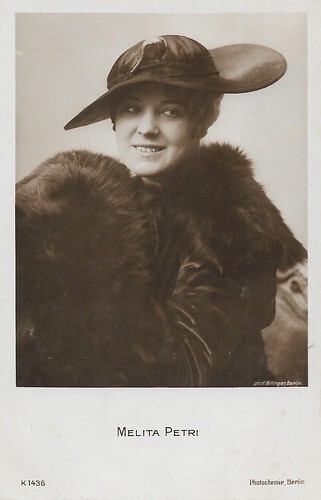
German postcard by Photochemie, Berlin, no. K.1436. Photo: Willinger, Berlin.
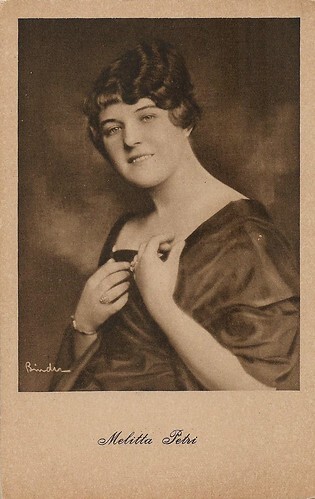
German postcard by Verlag Hermann Wolff, Berlin, no. 9. Photo: Alex Binder, Berlin.
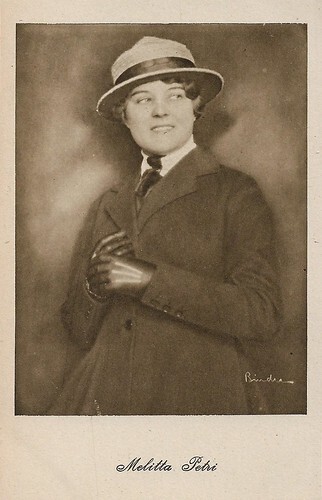
German postcard by Verlag Hermann Wolff, Berlin, no. 38. Photo: Alex Binder, Berlin.
Operetta singer
While the life dates of Melita Petri are unknown, and most German film sites only give her filmography, we discovered that Petri must have debuted as an operetta singer in the early 1910s.
In 1911-1912 she was engaged by the German-Dutch company Het Duitsche Tooneel (The German Theatre), which gave many German and Austrian operettas on the Dutch stages of Amsterdam, Rotterdam in The Hague. Under the direction of Hans Edmund, the star singers Paul Stampa, Willy Dietrich, Laura Bernauer and Lotte Gassner appeared.
Petri was first mentioned in November 1911 when she was performing in the 1856 play 'Robert und Bertram' (Robert and Bertram) by Gustav Räder.
In January 1912 she performed in the musical farce 'Bummelstudenten' (Career students) by Rudolph Bernauer, followed by Leo Fall's operetta 'Die Dollarprinzessin' (The Dollar Princess).
In March 1912 Petri performed as Prince Orlofsky in 'Die Fledermaus' (the Bat) and as Diana in 'Orpheus in der Unterwelt' (Orphée aux enfers/Orpheus in the Underworld) by Jacques Offenbach. There may have been more operettas but Het Duitsch Tooneel stopped its activities in the Netherlands after March 1912.
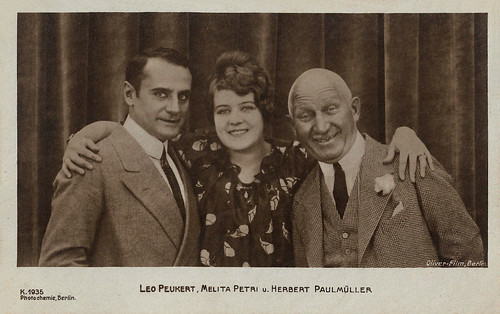
German postcard by Photochemie, Berlin, no. K. 1935. Photo: Oliver-Film, Berlin. Leo Peukert , Melita Petri, and Herbert Paulmüller often played together but only a few times at Oliver-Film, in Resemanns Brautfahrt (1918), Der müde Theodor (1918), Logierbesuch in der Sommernacht (1918), sometimes in coproduction with BB-Filmfabrikation such as in Wenn der Bräutigam mit der Braut (1919), and Die blonden Mädels vom Lindenhof (1918).
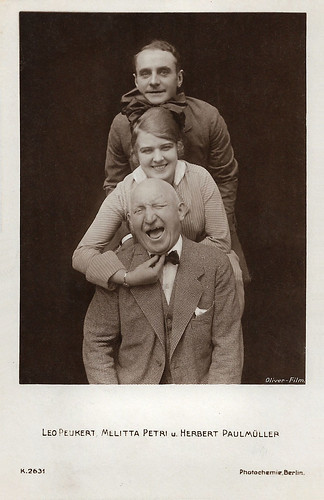
German postcard by Photochemie, Berlin, no. K. 2631. Photo: Oliver-Film, Berlin. Leo Peukert , Melita Petri, and Herbert Paulmüller.
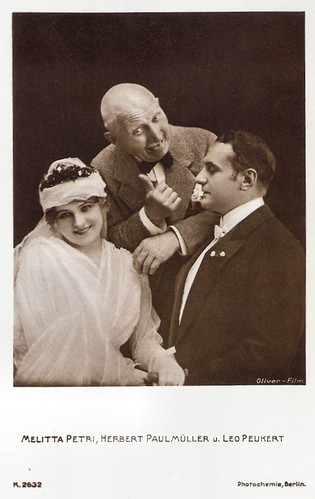
German postcard by Photochemie, Berlin, no. K. 2632. Photo: Oliver-Film, Berlin. Leo Peukert , Melita Petri, and Herbert Paulmüller.
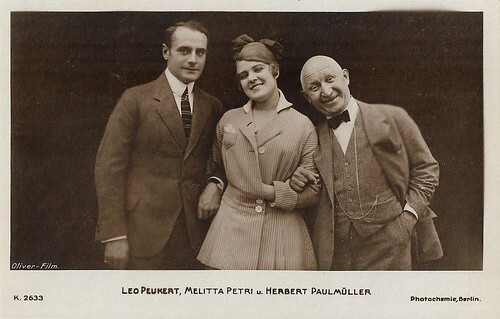
German postcard by Photochemie, no. K.2633. Photo: Oliver-Film. Leo Peukert , Melita Petri, and Herbert Paulmüller.
Comedy star
In 1915 Melita Petri debuted on screen in comedies by Heinrich Bolten-Backers for his own film company BB-Filmfabrikation in Berlin-Steglitz, starting with such films as Kulissenzauber/Scenery magic (Heinrich Bolten-Backers, Leo Peukert, 1915) with Leo Peukert and Alexander Moissi .
While Moissi's contribution was a one-off at BB-Film, both Melita Petri and Leo Peukert were regulars there, together with Herbert Paulmüller, and later on also with Conrad Dreher.
The number of her films increased by the year: 8 in 1916, well 22 in 1917 (the peak year), then 12 in 1918, and only 6 in 1919, the last year of Petri's output in film. Probably all if not most of these films were short comedies. As mentioned, most comedies were directed by Bolten-Backers, although from several titles the director is unknown.
Occasional additional actors to these comedies were Sabine Impekoven, Paul Heidemann , Carl Auen , Lily Flohr , Otto Treptow, and Richard Alexander. Also, occasionally, these comedies were produced by Oliver-Film such as Der müde Theodor/The tired Theodore (Leo Peukert, 1918), and Resemanns Brautfahrt/Resemann's Bridal Ride (N.N., 1918), director unknown.
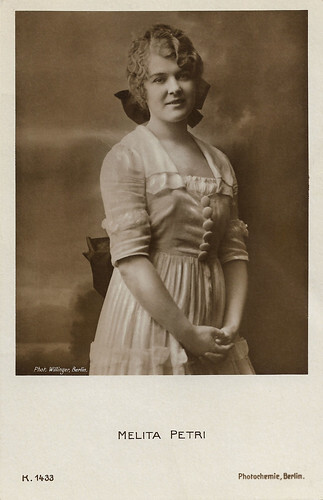
German postcard by. Photochemie, Berlin, no. K.1433. Photo: Willinger, Berlin.
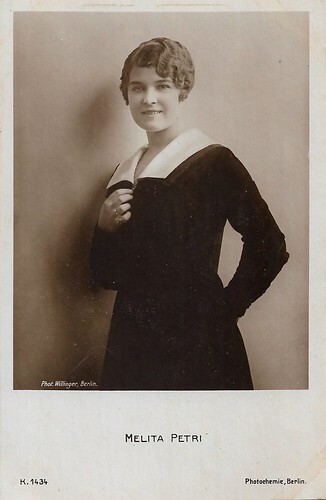
German postcard by. Photochemie, Berlin, no. K.1434. Photo: Willinger, Berlin.
After 1919 Bolten-Backers would continue to shoot short comedies with the BB Film regulars like Peukert, Impekoven and also Arnold Rieck , but henceforth without Petri. The latter may have retired or returned to the stage. All in all, Melita Petri acted in some 52 films.
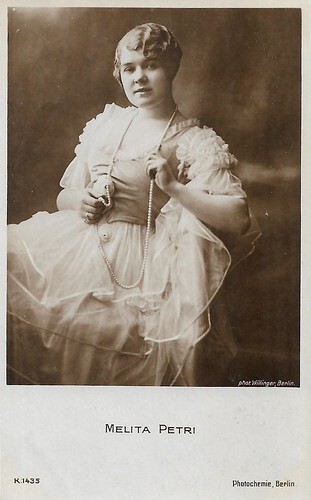
German postcard by. Photochemie, Berlin, no. K.1435. Photo: Willinger, Berlin.
Sources: Thomas Staedeli (Cyranos.ch), Filmportal de, Delpher (Dutch), and .

German postcard by Photochemie, Berlin, no. K.1436. Photo: Willinger, Berlin.

German postcard by Verlag Hermann Wolff, Berlin, no. 9. Photo: Alex Binder, Berlin.

German postcard by Verlag Hermann Wolff, Berlin, no. 38. Photo: Alex Binder, Berlin.
Operetta singer
While the life dates of Melita Petri are unknown, and most German film sites only give her filmography, we discovered that Petri must have debuted as an operetta singer in the early 1910s.
In 1911-1912 she was engaged by the German-Dutch company Het Duitsche Tooneel (The German Theatre), which gave many German and Austrian operettas on the Dutch stages of Amsterdam, Rotterdam in The Hague. Under the direction of Hans Edmund, the star singers Paul Stampa, Willy Dietrich, Laura Bernauer and Lotte Gassner appeared.
Petri was first mentioned in November 1911 when she was performing in the 1856 play 'Robert und Bertram' (Robert and Bertram) by Gustav Räder.
In January 1912 she performed in the musical farce 'Bummelstudenten' (Career students) by Rudolph Bernauer, followed by Leo Fall's operetta 'Die Dollarprinzessin' (The Dollar Princess).
In March 1912 Petri performed as Prince Orlofsky in 'Die Fledermaus' (the Bat) and as Diana in 'Orpheus in der Unterwelt' (Orphée aux enfers/Orpheus in the Underworld) by Jacques Offenbach. There may have been more operettas but Het Duitsch Tooneel stopped its activities in the Netherlands after March 1912.

German postcard by Photochemie, Berlin, no. K. 1935. Photo: Oliver-Film, Berlin. Leo Peukert , Melita Petri, and Herbert Paulmüller often played together but only a few times at Oliver-Film, in Resemanns Brautfahrt (1918), Der müde Theodor (1918), Logierbesuch in der Sommernacht (1918), sometimes in coproduction with BB-Filmfabrikation such as in Wenn der Bräutigam mit der Braut (1919), and Die blonden Mädels vom Lindenhof (1918).

German postcard by Photochemie, Berlin, no. K. 2631. Photo: Oliver-Film, Berlin. Leo Peukert , Melita Petri, and Herbert Paulmüller.

German postcard by Photochemie, Berlin, no. K. 2632. Photo: Oliver-Film, Berlin. Leo Peukert , Melita Petri, and Herbert Paulmüller.

German postcard by Photochemie, no. K.2633. Photo: Oliver-Film. Leo Peukert , Melita Petri, and Herbert Paulmüller.
Comedy star
In 1915 Melita Petri debuted on screen in comedies by Heinrich Bolten-Backers for his own film company BB-Filmfabrikation in Berlin-Steglitz, starting with such films as Kulissenzauber/Scenery magic (Heinrich Bolten-Backers, Leo Peukert, 1915) with Leo Peukert and Alexander Moissi .
While Moissi's contribution was a one-off at BB-Film, both Melita Petri and Leo Peukert were regulars there, together with Herbert Paulmüller, and later on also with Conrad Dreher.
The number of her films increased by the year: 8 in 1916, well 22 in 1917 (the peak year), then 12 in 1918, and only 6 in 1919, the last year of Petri's output in film. Probably all if not most of these films were short comedies. As mentioned, most comedies were directed by Bolten-Backers, although from several titles the director is unknown.
Occasional additional actors to these comedies were Sabine Impekoven, Paul Heidemann , Carl Auen , Lily Flohr , Otto Treptow, and Richard Alexander. Also, occasionally, these comedies were produced by Oliver-Film such as Der müde Theodor/The tired Theodore (Leo Peukert, 1918), and Resemanns Brautfahrt/Resemann's Bridal Ride (N.N., 1918), director unknown.

German postcard by. Photochemie, Berlin, no. K.1433. Photo: Willinger, Berlin.

German postcard by. Photochemie, Berlin, no. K.1434. Photo: Willinger, Berlin.
After 1919 Bolten-Backers would continue to shoot short comedies with the BB Film regulars like Peukert, Impekoven and also Arnold Rieck , but henceforth without Petri. The latter may have retired or returned to the stage. All in all, Melita Petri acted in some 52 films.

German postcard by. Photochemie, Berlin, no. K.1435. Photo: Willinger, Berlin.
Sources: Thomas Staedeli (Cyranos.ch), Filmportal de, Delpher (Dutch), and .
Published on November 01, 2022 23:00
October 31, 2022
Directed by John Huston
American director, screenwriter and character actor John Huston (1906-1987) was a Hollywood titan for more than five decades. His debut was the hardboiled mystery The Maltese Falcon (1941) which turned Humphrey Bogart into a superstar. With such films as Key Largo (1948) and The Asphalt Jungle (1950), he became one of the decisive factors in the popularity of Film Noir. His other classics include The Treasure of the Sierra Madre (1948), The African Queen (1951), Moby Dick (1956), The Misfits (1961), Fat City (1972), The Man Who Would Be King (1975) and Prizzi's Honor (1985). Huston received 15 Oscar nominations and won twice, and he directed both his father, Walter Huston and his daughter, Anjelica Huston, to Oscar wins.

American postcard by Pomegranate Publications, Petaluma, CA, no. 5314, 1989. Photo: The Avery Collection. John Huston in Man in the Wilderness (Richard C. Sarafian, 1971).
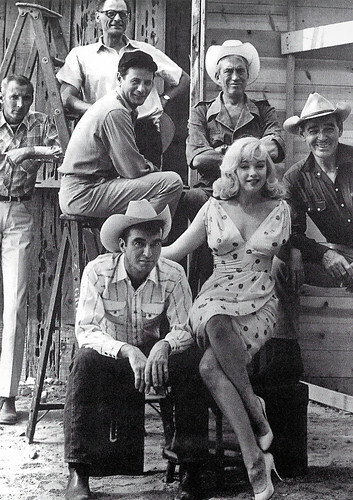
Chinese postcard by Laverton. Photo: Elliott Erwitt/Magnum Photos. John Huston on the set of The Misfits (John Huston, 1961) with his stars Montgomery Clift , Marilyn Monroe , Clark Gable , Eli Wallach, producer Frank E. Taylor and writer Arthur Miller.
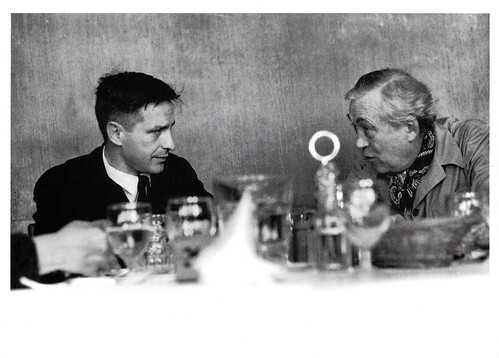
Swiss-British-German postcard by News Productions, Baulmes and Stroud / Filmwelt Berlin, Bakede, no. 56569, 1994. Photo: Larry Shaw. Caption: John Cassavetes and John Huston, Pinewood Studios, England, 1967.
One of the greatest detective films ever made
John Marcellus Huston was born in Nevada, Missouri, in 1906. The age-old story goes that the small town of his birth was won by John's grandfather in a poker game. However, he was raised in Weatherford, Texas, until his family moved to Los Angeles, California. John's father was the character actor Walter Huston, and his mother, Rhea Gore, was a newspaperwoman who travelled around the country looking for stories. The only child of the couple, John began performing on stage with his vaudevillian father at age 3. Upon his parents' divorce at age 7, the young boy would take turns travelling around the vaudeville circuit with his father and the country with his mother on reporting excursions. A frail and sickly child, he was once placed in a sanitarium due to both an enlarged heart and kidney ailment. Making a miraculous recovery, he quit school at age 14 to become a full-fledged boxer and eventually won the Amateur Lightweight Boxing Championship of California.
John married his high school sweetheart, Dorothy Harvey, and in 1925, he also made his stage debut with a leading role off-Broadway in the play 'The Triumph of the Egg'. He made his Broadway debut that same year with 'Ruint' (1925) and followed that with another Broadway show 'Adam Solitaire' (1925). John soon grew restless with the confines of both his marriage and acting and abandoned both, taking a sojourn to Mexico where he became an officer in the cavalry and expert horseman while writing plays on the sly. Trying to control his wanderlust urges, he subsequently returned to America and attempted newspaper and magazine reporting work in New York by submitting short stories. He was even hired at one point by mogul Samuel Goldwyn Jr. as a screenwriter, but again he grew restless. During this time he also appeared unbilled in a few obligatory films. By 1932 John was on the move again and left for London and Paris where he studied painting and sketching. The promising artist became a homeless beggar during one harrowing point.
Returning again to America in 1933, he played the title role in a production of 'Abraham Lincoln', only a few years after his father Walter portrayed the part on film for D.W. Griffith . John began to collaborate on a few scripts for Warner Brothers. He also married again. Warners was so impressed with his talents that he was signed on as both screenwriter and director for the Dashiell Hammett hardboiled mystery The Maltese Falcon (John Huston, 1941). This film classic made a superstar out of Humphrey Bogart and is considered by critics as one of the greatest detective films ever made. In the meantime, John wrote and staged a couple of Broadway plays. After his successful film debut, he directed bad-girl Bette Davis and good girl Olivia de Havilland in the melodrama In This Our Life (John Huston, 1942). He then reunited with three of the stars of The Maltese Falcon, Humphrey Bogart , Mary Astor and Sydney Greenstreet in the romantic war picture Across the Pacific (John Huston, Vincent Sherman, 1942).
During World War II, John Huston served as a Signal Corps lieutenant and went on to helm a number of film documentaries for the U.S. government including the controversial Let There Be Light (1941) about Post-Traumatic Stress Disorder (PTSD), or 'shell shock', for which he followed a group of mentally traumatized veteran patients as they go through psychiatric treatment. His father Walter narrated the film. This film was banned for 35 years because the American government thought it was unsuitable for audiences, and it was shown for the first time at the Cannes festival in 1981. The end of WWII also saw the end of his second marriage with Edith Lesley Black (1937-1945).
The impulsive and unpredictable Huston married his third wife, actress Evelyn Keyes , in 1946 but this marriage also lasted a relatively short time. That same year Huston directed Jean-Paul Sartre's experimental play 'No Exit' on Broadway. The show was a box-office bust and ran less than a month but it nevertheless earned the New York Drama Critics Award as 'best foreign play'. Hollywood glory came to him again in association with Bogart and Warner Brothers. The Treasure of the Sierra Madre (John Huston, 1948) became a classic tale of gold, greed and man's inhumanity to man set in Mexico. John won Oscars for both director and screenplay and his father Walter received the Best Supporting Actor award. John can be glimpsed at the beginning of the film in a cameo playing a tourist, but he wouldn't act again on film for a decade and a half.
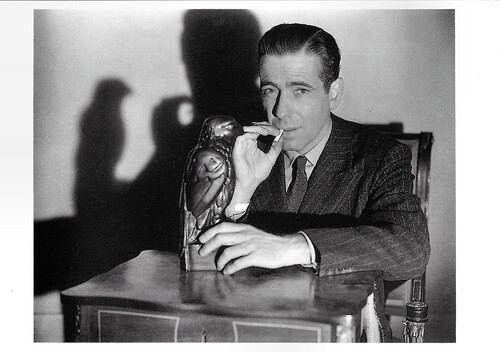
Swiss-German-British postcard by News Productions, Baulmes / Filmwelt Berlin, Bakede / News Productions, Stroud, no. 56495. Photo: Warner Bros / Collection Cinémathèque Suisse, Lausanne. Humphrey Bogart in The Maltese Falcon (John Huston, 1941).
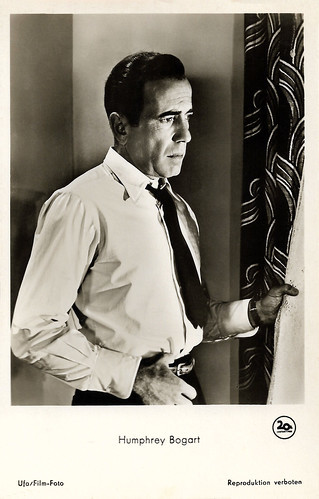
German postcard by UFA/Film-Foto, Berlin-Tempelhof, no. FK 305. Photo: 20th Century Fox. Humphrey Bogart in The Maltese Falcon (John Huston, 1941).
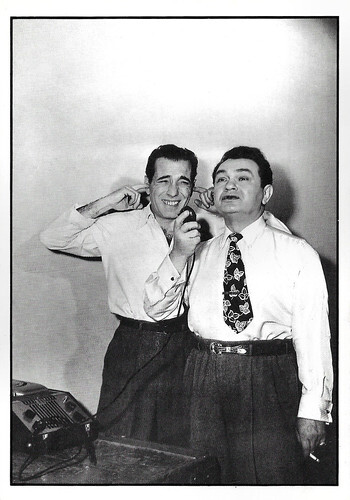
French postcard in the Entr'acte series by Éditions Asphodèle, Mâcon, no. 004/13. Photo: Collection B. Courtel / D.R. Humphrey Bogart and Edward G. Robinson on the set of Key Largo (John Huston, 1948). Caption: Ouch! My ears! Wouldn't Humphrey Bogart appreciate the efforts of his partner Edward G. Robinson in recording a song?
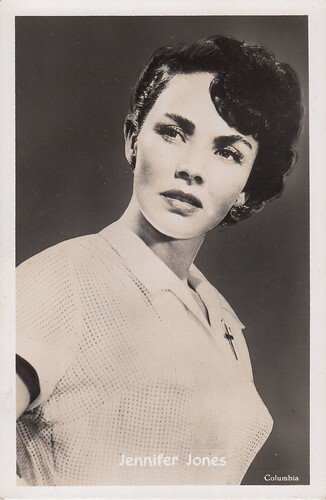
Belgian postcard by Nieuwe Merksemsche Chocolaterie S.P.R.L., Merksem Anvers, no. D7. Photo: Columbia. Jennifer Jones in We Were Strangers (John Huston, 1949). Collection: Marlene Pilaete.
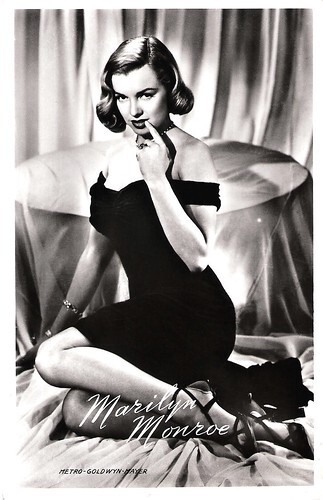
Dutch postcard by Uitg. Takken, Utrecht, no. 1708. Photo: Eric Carpenter / Metro-Goldwyn-Mayer. Marilyn Monroe in The Asphalt Jungle (John Huston, 1950).
Some of the finest American films of that period
In the following decade, John Huston wrote and directed write and/or direct some of the finest American films of that period including Key Largo (1948) and The African Queen (1951) both with Humphrey Bogart , the Film Noir The Asphalt Jungle (John Huston, 1950), the war film The Red Badge of Courage (John Huston, 1951) with Audie Murphy and the classic musical Moulin Rouge (John Huston, 1952) starring José Ferrer.
An ardent supporter of human rights, he, along with director William Wyler and others, dared to form the Committee for the First Amendment in 1947, which strove to undermine the House Un-American Activities Committee. Disgusted by the Hollywood blacklisting that was killing the careers of many talented colleagues, he moved to St. Clerans in Ireland and became a citizen there along with his fourth wife, Russian prima ballerina Enrica (Ricki) Soma. The couple had two children, son Tony Huston (1950) and daughter Anjelica Huston (1951) who went on to have an enviable Hollywood career of her own. Huston and Ricki split after his son, director Danny Huston (1962), was born to actress Zoe Sallis. They did not divorce, however, and remained estranged until her sudden death in 1969 in a car accident. John subsequently adopted his late wife's daughter, Allegra Huston, from another union. The ever-impulsive Huston would move yet again to Mexico where he married (1972) and divorced (1977) his fifth and final wife, Celeste Shane. In his autobiography, published some five years after their divorce, he refused to mention her by name, referring to her only as "a crocodile". On talk shows, he often said it was the only one of his marriages he regretted.
His later films included Moby Dick (John Huston, 1956) based on the classic story by Herman Melville about Captain Ahab ( Gregory Peck ) and his obsession with a huge whale, Moby Dick, The Unforgiven (John Huston, 1960) about a frontier family who is suspected that their adopted daughter ( Audrey Hepburn ) was stolen from the local Kiowa tribe, and The Misfits (John Huston, 1961) the last completed film for both Clark Gable and Marilyn Monroe . The films he made in the 1960s also included Freud (John Huston, 1962) with Montgomery Clift , The Night of the Iguana (John Huston, 1964) starring Richard Burton and Ava Gardner , and The Bible: In the Beginning... (John Huston, 1966) with Michael Parks as Jesus were mostly well-regarded but not close to the level of his earlier revered work. Huston also experimented behind the camera with colour effects and approached such taboo topics as homosexuality and psychoanalysis.
Huston returned to acting auspiciously with a major role in Otto Preminger's epic film The Cardinal (1963) for which Huston received an Oscar nomination at age 57. From that time forward, he would be glimpsed here and there in character roles in both good and bad films that, at the very least, helped finance his own projects. Gary Brumburgh at IMDb : "The former list included outstanding roles in Chinatown (Roman Polanski, 1974) and The Wind and the Lion (John Milius, 1975), while the latter comprised of hammy parts in such awful drek as Candy (Christian Marquand, 1968) and Myra Breckinridge (Michael Sarne, 1970).
Huston directed his daughter Angelica in her film debut, the thoroughly mediocre A Walk with Love and Death (John Huston, 1969), but he made up for it 15 years later by directing her to an Oscar in the gangster film Prizzi's Honor (1985) with Jack Nicholson . In the 1970s Huston resurged as a director of quality films with Fat City (John Huston, 1972) starring Jeff Bridges, The Man Who Would Be King (John Huston, 1975) with Sean Connery and Wise Blood (John Huston, 1979). He ended his career on a high note with Under the Volcano (1984) with Albert Finney , Prizzi's Honor (1985) and the James Joyce adaptation The Dead (John Huston, 1987). His only certifiable misfire during that era was the musical version of Annie (John Huston, 1982), though it was popular among children.
Huston lived the macho, outdoors life, unencumbered by convention or restrictions, and is often compared to Ernest Hemingway and Orson Welles . Gary Brumbrugh: "He was, in fact, the source of inspiration for Clint Eastwood in the helming of the film White Hunter Black Heart (1990) which chronicled the making of The African Queen. Illness robbed Huston of a good portion of his twilight years with chronic emphysema the main culprit. As always, however, he continued to work tirelessly while hooked up to an oxygen machine if need be. At the end, the living legend was shooting an acting cameo in the film Mr. North (1988) for his son Danny, making his directorial bow at the time." While on location, John Huston became seriously ill with pneumonia and died in Middletown, Rhode Island, at the age of 81. He was buried with his mother at Hollywood Memorial Park, now called Hollywood Forever.
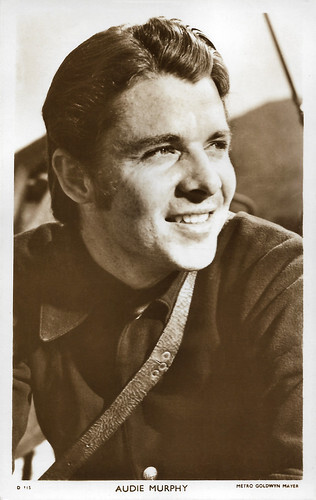
British postcard, in the Picturegoer Series, London, no. D 115. Photo: Metro Goldwyn Mayer. Audie Murphy in The Red Badge of Courage (John Huston, 1951).
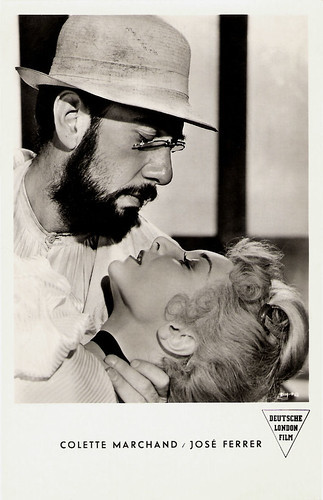
German postcard. Photo: Deutsche London Film. José Ferrer and Colette Marchand in Moulin Rouge (John Huston, 1952).
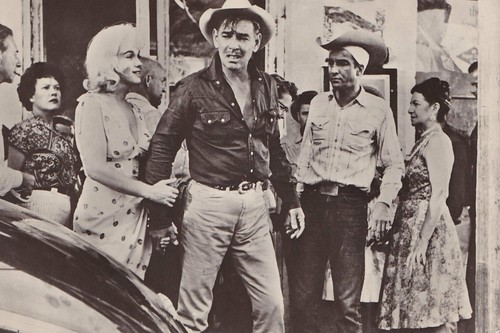
Czech postcard by Pressfoto, Praha (Prague). Photo: Marilyn Monroe , Clark Gable , and Montgomery Clift in The Misfits (John Huston, 1961). Collection: Carla Bosch.
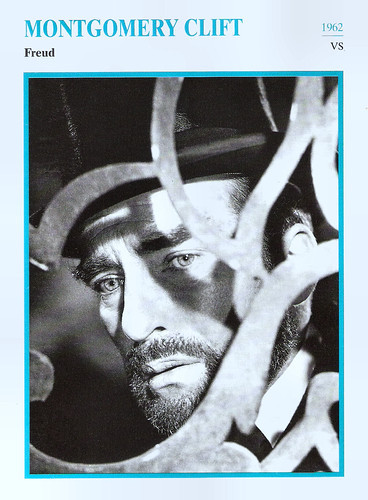
Dutch collectors card in the series 'Filmsterren: een Portret' by Edito Service, 1994. Photo: The Kobal Collection. Montgomery Clift in Freud (John Huston, 1962).
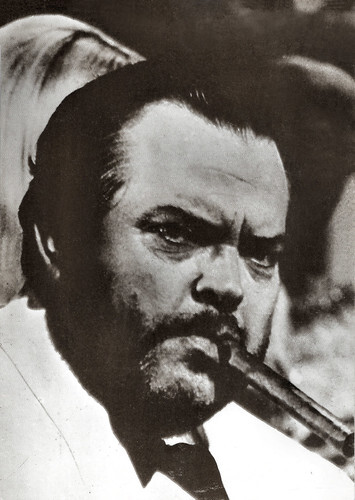
French postcard by Delta Productions, Montpellier, no. CP152. Orson Welles in Casino Royale (Val Guest, Ken Hughes, John Huston, 1967).
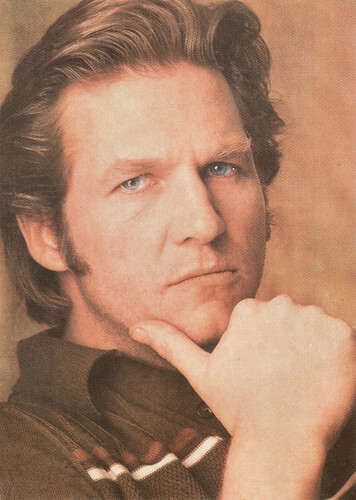
Romanian postcard by Casa Filmului Acin. Jeff Bridges on a publicity still for Fat City (John Huston, 1972).
Sources: (IMDb), Wikipedia and .

American postcard by Pomegranate Publications, Petaluma, CA, no. 5314, 1989. Photo: The Avery Collection. John Huston in Man in the Wilderness (Richard C. Sarafian, 1971).

Chinese postcard by Laverton. Photo: Elliott Erwitt/Magnum Photos. John Huston on the set of The Misfits (John Huston, 1961) with his stars Montgomery Clift , Marilyn Monroe , Clark Gable , Eli Wallach, producer Frank E. Taylor and writer Arthur Miller.

Swiss-British-German postcard by News Productions, Baulmes and Stroud / Filmwelt Berlin, Bakede, no. 56569, 1994. Photo: Larry Shaw. Caption: John Cassavetes and John Huston, Pinewood Studios, England, 1967.
One of the greatest detective films ever made
John Marcellus Huston was born in Nevada, Missouri, in 1906. The age-old story goes that the small town of his birth was won by John's grandfather in a poker game. However, he was raised in Weatherford, Texas, until his family moved to Los Angeles, California. John's father was the character actor Walter Huston, and his mother, Rhea Gore, was a newspaperwoman who travelled around the country looking for stories. The only child of the couple, John began performing on stage with his vaudevillian father at age 3. Upon his parents' divorce at age 7, the young boy would take turns travelling around the vaudeville circuit with his father and the country with his mother on reporting excursions. A frail and sickly child, he was once placed in a sanitarium due to both an enlarged heart and kidney ailment. Making a miraculous recovery, he quit school at age 14 to become a full-fledged boxer and eventually won the Amateur Lightweight Boxing Championship of California.
John married his high school sweetheart, Dorothy Harvey, and in 1925, he also made his stage debut with a leading role off-Broadway in the play 'The Triumph of the Egg'. He made his Broadway debut that same year with 'Ruint' (1925) and followed that with another Broadway show 'Adam Solitaire' (1925). John soon grew restless with the confines of both his marriage and acting and abandoned both, taking a sojourn to Mexico where he became an officer in the cavalry and expert horseman while writing plays on the sly. Trying to control his wanderlust urges, he subsequently returned to America and attempted newspaper and magazine reporting work in New York by submitting short stories. He was even hired at one point by mogul Samuel Goldwyn Jr. as a screenwriter, but again he grew restless. During this time he also appeared unbilled in a few obligatory films. By 1932 John was on the move again and left for London and Paris where he studied painting and sketching. The promising artist became a homeless beggar during one harrowing point.
Returning again to America in 1933, he played the title role in a production of 'Abraham Lincoln', only a few years after his father Walter portrayed the part on film for D.W. Griffith . John began to collaborate on a few scripts for Warner Brothers. He also married again. Warners was so impressed with his talents that he was signed on as both screenwriter and director for the Dashiell Hammett hardboiled mystery The Maltese Falcon (John Huston, 1941). This film classic made a superstar out of Humphrey Bogart and is considered by critics as one of the greatest detective films ever made. In the meantime, John wrote and staged a couple of Broadway plays. After his successful film debut, he directed bad-girl Bette Davis and good girl Olivia de Havilland in the melodrama In This Our Life (John Huston, 1942). He then reunited with three of the stars of The Maltese Falcon, Humphrey Bogart , Mary Astor and Sydney Greenstreet in the romantic war picture Across the Pacific (John Huston, Vincent Sherman, 1942).
During World War II, John Huston served as a Signal Corps lieutenant and went on to helm a number of film documentaries for the U.S. government including the controversial Let There Be Light (1941) about Post-Traumatic Stress Disorder (PTSD), or 'shell shock', for which he followed a group of mentally traumatized veteran patients as they go through psychiatric treatment. His father Walter narrated the film. This film was banned for 35 years because the American government thought it was unsuitable for audiences, and it was shown for the first time at the Cannes festival in 1981. The end of WWII also saw the end of his second marriage with Edith Lesley Black (1937-1945).
The impulsive and unpredictable Huston married his third wife, actress Evelyn Keyes , in 1946 but this marriage also lasted a relatively short time. That same year Huston directed Jean-Paul Sartre's experimental play 'No Exit' on Broadway. The show was a box-office bust and ran less than a month but it nevertheless earned the New York Drama Critics Award as 'best foreign play'. Hollywood glory came to him again in association with Bogart and Warner Brothers. The Treasure of the Sierra Madre (John Huston, 1948) became a classic tale of gold, greed and man's inhumanity to man set in Mexico. John won Oscars for both director and screenplay and his father Walter received the Best Supporting Actor award. John can be glimpsed at the beginning of the film in a cameo playing a tourist, but he wouldn't act again on film for a decade and a half.

Swiss-German-British postcard by News Productions, Baulmes / Filmwelt Berlin, Bakede / News Productions, Stroud, no. 56495. Photo: Warner Bros / Collection Cinémathèque Suisse, Lausanne. Humphrey Bogart in The Maltese Falcon (John Huston, 1941).

German postcard by UFA/Film-Foto, Berlin-Tempelhof, no. FK 305. Photo: 20th Century Fox. Humphrey Bogart in The Maltese Falcon (John Huston, 1941).

French postcard in the Entr'acte series by Éditions Asphodèle, Mâcon, no. 004/13. Photo: Collection B. Courtel / D.R. Humphrey Bogart and Edward G. Robinson on the set of Key Largo (John Huston, 1948). Caption: Ouch! My ears! Wouldn't Humphrey Bogart appreciate the efforts of his partner Edward G. Robinson in recording a song?

Belgian postcard by Nieuwe Merksemsche Chocolaterie S.P.R.L., Merksem Anvers, no. D7. Photo: Columbia. Jennifer Jones in We Were Strangers (John Huston, 1949). Collection: Marlene Pilaete.

Dutch postcard by Uitg. Takken, Utrecht, no. 1708. Photo: Eric Carpenter / Metro-Goldwyn-Mayer. Marilyn Monroe in The Asphalt Jungle (John Huston, 1950).
Some of the finest American films of that period
In the following decade, John Huston wrote and directed write and/or direct some of the finest American films of that period including Key Largo (1948) and The African Queen (1951) both with Humphrey Bogart , the Film Noir The Asphalt Jungle (John Huston, 1950), the war film The Red Badge of Courage (John Huston, 1951) with Audie Murphy and the classic musical Moulin Rouge (John Huston, 1952) starring José Ferrer.
An ardent supporter of human rights, he, along with director William Wyler and others, dared to form the Committee for the First Amendment in 1947, which strove to undermine the House Un-American Activities Committee. Disgusted by the Hollywood blacklisting that was killing the careers of many talented colleagues, he moved to St. Clerans in Ireland and became a citizen there along with his fourth wife, Russian prima ballerina Enrica (Ricki) Soma. The couple had two children, son Tony Huston (1950) and daughter Anjelica Huston (1951) who went on to have an enviable Hollywood career of her own. Huston and Ricki split after his son, director Danny Huston (1962), was born to actress Zoe Sallis. They did not divorce, however, and remained estranged until her sudden death in 1969 in a car accident. John subsequently adopted his late wife's daughter, Allegra Huston, from another union. The ever-impulsive Huston would move yet again to Mexico where he married (1972) and divorced (1977) his fifth and final wife, Celeste Shane. In his autobiography, published some five years after their divorce, he refused to mention her by name, referring to her only as "a crocodile". On talk shows, he often said it was the only one of his marriages he regretted.
His later films included Moby Dick (John Huston, 1956) based on the classic story by Herman Melville about Captain Ahab ( Gregory Peck ) and his obsession with a huge whale, Moby Dick, The Unforgiven (John Huston, 1960) about a frontier family who is suspected that their adopted daughter ( Audrey Hepburn ) was stolen from the local Kiowa tribe, and The Misfits (John Huston, 1961) the last completed film for both Clark Gable and Marilyn Monroe . The films he made in the 1960s also included Freud (John Huston, 1962) with Montgomery Clift , The Night of the Iguana (John Huston, 1964) starring Richard Burton and Ava Gardner , and The Bible: In the Beginning... (John Huston, 1966) with Michael Parks as Jesus were mostly well-regarded but not close to the level of his earlier revered work. Huston also experimented behind the camera with colour effects and approached such taboo topics as homosexuality and psychoanalysis.
Huston returned to acting auspiciously with a major role in Otto Preminger's epic film The Cardinal (1963) for which Huston received an Oscar nomination at age 57. From that time forward, he would be glimpsed here and there in character roles in both good and bad films that, at the very least, helped finance his own projects. Gary Brumburgh at IMDb : "The former list included outstanding roles in Chinatown (Roman Polanski, 1974) and The Wind and the Lion (John Milius, 1975), while the latter comprised of hammy parts in such awful drek as Candy (Christian Marquand, 1968) and Myra Breckinridge (Michael Sarne, 1970).
Huston directed his daughter Angelica in her film debut, the thoroughly mediocre A Walk with Love and Death (John Huston, 1969), but he made up for it 15 years later by directing her to an Oscar in the gangster film Prizzi's Honor (1985) with Jack Nicholson . In the 1970s Huston resurged as a director of quality films with Fat City (John Huston, 1972) starring Jeff Bridges, The Man Who Would Be King (John Huston, 1975) with Sean Connery and Wise Blood (John Huston, 1979). He ended his career on a high note with Under the Volcano (1984) with Albert Finney , Prizzi's Honor (1985) and the James Joyce adaptation The Dead (John Huston, 1987). His only certifiable misfire during that era was the musical version of Annie (John Huston, 1982), though it was popular among children.
Huston lived the macho, outdoors life, unencumbered by convention or restrictions, and is often compared to Ernest Hemingway and Orson Welles . Gary Brumbrugh: "He was, in fact, the source of inspiration for Clint Eastwood in the helming of the film White Hunter Black Heart (1990) which chronicled the making of The African Queen. Illness robbed Huston of a good portion of his twilight years with chronic emphysema the main culprit. As always, however, he continued to work tirelessly while hooked up to an oxygen machine if need be. At the end, the living legend was shooting an acting cameo in the film Mr. North (1988) for his son Danny, making his directorial bow at the time." While on location, John Huston became seriously ill with pneumonia and died in Middletown, Rhode Island, at the age of 81. He was buried with his mother at Hollywood Memorial Park, now called Hollywood Forever.

British postcard, in the Picturegoer Series, London, no. D 115. Photo: Metro Goldwyn Mayer. Audie Murphy in The Red Badge of Courage (John Huston, 1951).

German postcard. Photo: Deutsche London Film. José Ferrer and Colette Marchand in Moulin Rouge (John Huston, 1952).

Czech postcard by Pressfoto, Praha (Prague). Photo: Marilyn Monroe , Clark Gable , and Montgomery Clift in The Misfits (John Huston, 1961). Collection: Carla Bosch.

Dutch collectors card in the series 'Filmsterren: een Portret' by Edito Service, 1994. Photo: The Kobal Collection. Montgomery Clift in Freud (John Huston, 1962).

French postcard by Delta Productions, Montpellier, no. CP152. Orson Welles in Casino Royale (Val Guest, Ken Hughes, John Huston, 1967).

Romanian postcard by Casa Filmului Acin. Jeff Bridges on a publicity still for Fat City (John Huston, 1972).
Sources: (IMDb), Wikipedia and .
Published on October 31, 2022 23:00
October 30, 2022
La Belle et la Bête (1946)
The surrealistic fairytale La belle et la bête/Beauty and the Beast (Jean Cocteau, René Clément, 1946) is a classic of French cinema. Josette Day stars as Belle and Jean Marais in a triple role as the beast, Avenant and the prince. The film, produced by André Paulvé, was based on the eponymous 1756 fairy tale by Jeanne-Marie Leprince de Beaumont. The wonderful shadowy images were created by Cocteau, cameraman Henri Alekan and photographer Aldo Graziati.
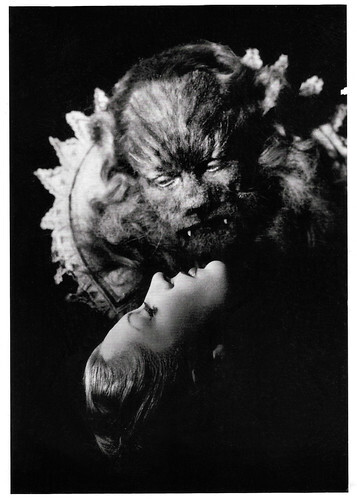
Swiss postcard by News Productions, Baulmes, no. 56515. Photo: Collection Cinémathèque Suisse, Lausanne. Jean Marais and Josette Day in La belle et la bête/Beauty and the Beast (Jean Cocteau, René Clément, 1946).
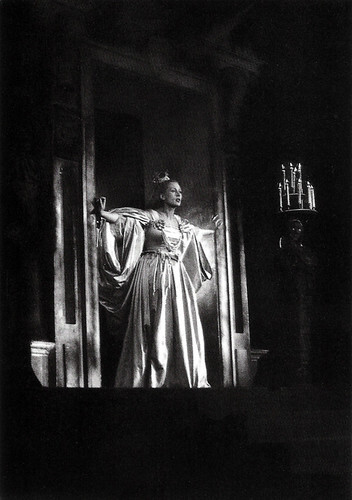
French postcard, no. C130. Photo: Josette Day in La belle et la bête/Beauty and the Beast (Jean Cocteau, René Clément, 1946).
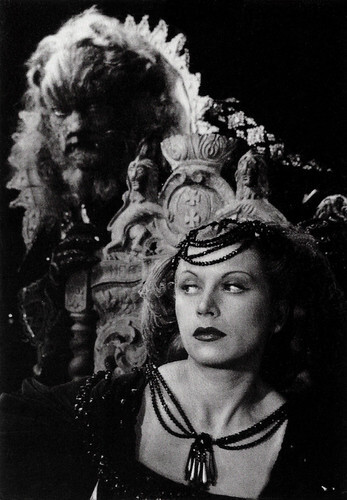
French postcard, no. C142. Photo: Aldo. Jean Marais and Josette Day in La belle et la bête/Beauty and the Beast (Jean Cocteau, René Clément, 1946).
One of the most beautiful fantasy films of all time
La belle et la bête/Beauty and the Beast (Jean Cocteau, René Clément, 1946) is a French black-and-white fairy tale adaptation. This film is often cited as one of the most beautiful fantasy films of all time and to some extent inspired Disney's animated film, Beauty and the Beast (Gary Trousdale, Kirk Wise, 1991).
At the end of World War II, Jean Marais suggested to Jean Cocteau that he make a film based on the 18th-century fairy tale of Madame Jeanne-Marie Le Prince de Beaumont. Cocteau thought it was an excellent idea. Not only did it coincide with the dreams he had in his childhood - but it also offered an opportunity for a new genre within the film: filmed fairy tales. During the shooting of the film, Cocteau became very ill because of a skin disease and eventually had to be hospitalised. While he was recovering, René Clément served as the director.
The leads feature Josette Day as Belle and Michel Auclair as her brother Ludovic. He gave the role of the Beast to the actor who was then seen as the world's most beautiful man, Jean Marais . Marais plays a triple role as the beast, Belle's worshipper (Avenant) and the prince. Georges Auric wrote the music and Henri Alekan did the camera work. Christian Bérard and Lucien Carré did the art direction. The House of Lanvin made all of the costumes, with resident designer Pierre Cardin supervising the men's wardrobe. Many rules were broken during the making of this film, Auric's music breaking rather than underlining the visual effects. Alekan's camerawork is not conventional, but sharp and clear - almost like a documentary.
It was the first film that Jean Cocteau both wrote and directed since his debut Le sang d'un poète/The Blood of a Poet (Jean Cocteau, 1932). On the surface, La belle et la bête seems different from the previous one, but both films work with myths and create an atmosphere of unearthly beauty. In his adaptation, Cocteau made morality play a role subject to magic, symbolism, surrealism and psychoanalysis. There are human arms anchored in the wall carrying candlesticks and caryatids with moving eyes and exhaling smoke. Cocteau also placed several enchanted lucky charms and enchanted gardens in the film. The film was shot in the French countryside, in a setting that lends credibility to both the down-to-earth, realistic home of Belle and her family. The Beast's castle exteriors were shot at the Château de la Roche Courbon, a French historic site.
La belle et la bête is known for its surrealistic qualities and its use of existing film techniques to evoke a sense of magic and enchantment. Cocteau shows here how difficult it is sometimes to separate fantasy from reality. The camera work and set designs reference nineteenth-century artist Gustave Doré's illustrations and engravings and, in the farm scenes, Johannes Vermeer's paintings. Jean Cocteau's use of imagery provided a lot of surrealist or Jungian analysis. La belle et la bête remains true to the fairy tale in spirit, but the portrayal is definitely Cocteau's. With this, he inspired later directors such as Ingmar Bergman , François Truffaut and Vincente Minnelli.
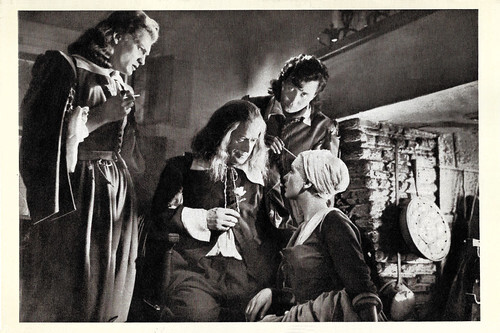
French card by Editions La Malibran, Saint-Dié, no CF 19. Photo: Aldo. Jean Marais , Marcel André, Michel Auclair and Josette Day in La belle et la bête/Beauty and the Beast (Jean Cocteau, René Clément, 1946).
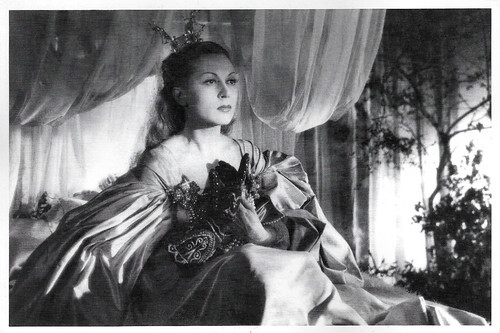
French card by Groupes National des cinemas de recherche (CNC). Josette Day in La belle et la bête/Beauty and the Beast (Jean Cocteau, René Clément, 1946).
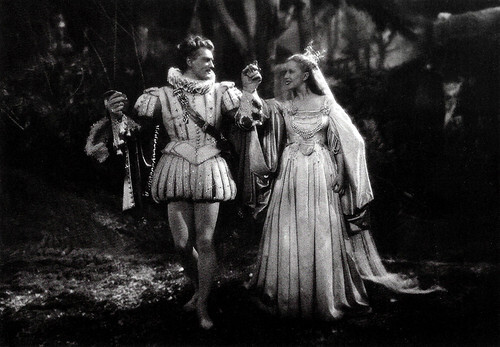
French postcard, no. C 141. Jean Marais and Josette Day in La belle et la bête/Beauty and the Beast (Jean Cocteau, René Clément, 1946).
A monster with magical abilities, created as half-man, half-animal
A merchant (Marcel André) lives in the countryside with his son Ludovic ( Michel Auclair ) and three daughters, Félicie ( Mila Parély ), Adélaïde (Nane Germon) and Belle ( Josette Day ). The merchant is balancing on the brink of bankruptcy. His two eldest daughters are vain, selfish and mean and treat their youngest sister Belle like a servant. Jean Cocteau regularly mocks them in the film, for instance when he lets clucking ducks be a comment on their bickering between them.
One day, the father leaves on a business trip. Before his departure, he promised his daughters to bring back gifts. For Félicie and Adélaïde beautiful dresses and for Belle a beautiful rose. On the way, he gets lost in a forest. There he discovers a strange castle, where he picks a rose to give to Belle. Suddenly, the owner of the castle ( Jean Marais ) appears, a monster with magical abilities, created as half-man, half-animal.
The lord of the castle condemns the merchant to death unless he gives him one of his daughters. Belle sacrifices herself and goes to the castle. Her journey to the castle is filmed in slow motion, creating a dreamy atmosphere. When she meets the beast, she faints. Slowly, she learns to love him. It turns out that only she can see his hidden inner beauty. The real beast turns out to be Avenant, the one who wants to marry her.
There are two different worlds in this film, the ordinary bourgeois home of the merchant on the one hand, and the enchanted castle of the Beast where anything is possible. These two worlds are linked by the mysterious forest. In and around the castle live the candelabra, the gardens and the caryatids.
Throughout the film, the Beast unveils five magical guides, the rose, a golden key, a gauntlet, a ring and the mirror, some of these are taken from Madame Leprince de Beaumont's fairy tale. Later this is joined by the white horse, "le Magnifique", and in the end, these two worlds come together. Belle's room is in her father's room - but also in her castle room. When Avenant dies, the Beast becomes the Prince he once used to be.
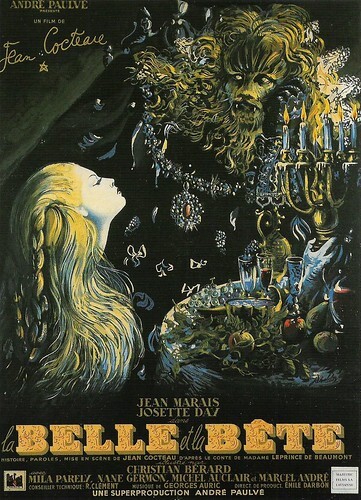
Swiss postcard by CVB Publishers. Image: Collection Cinémathèque Lausanne. Reproduction of the French film poster for La Belle et la Bête (Jean Cocteau, René Clément, 1946). The poster was designed by Cocteau's friend Jean-Denis Malcles.
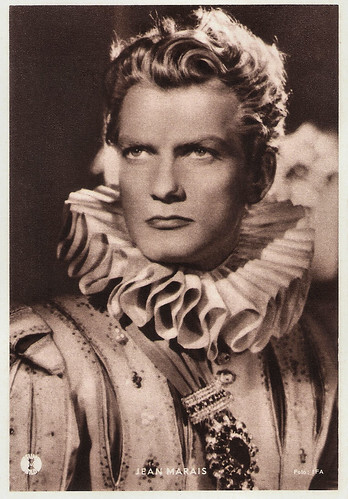
German postcard by Film und Bild, Frankfurt a.M. Photo: Aldo Graziati / IFA. Publicity still for La belle et la bête/Beauty and the Beast (Jean Coctteau, 1946).
Sources: Wikipedia (Dutch) and IMDb.

Swiss postcard by News Productions, Baulmes, no. 56515. Photo: Collection Cinémathèque Suisse, Lausanne. Jean Marais and Josette Day in La belle et la bête/Beauty and the Beast (Jean Cocteau, René Clément, 1946).

French postcard, no. C130. Photo: Josette Day in La belle et la bête/Beauty and the Beast (Jean Cocteau, René Clément, 1946).

French postcard, no. C142. Photo: Aldo. Jean Marais and Josette Day in La belle et la bête/Beauty and the Beast (Jean Cocteau, René Clément, 1946).
One of the most beautiful fantasy films of all time
La belle et la bête/Beauty and the Beast (Jean Cocteau, René Clément, 1946) is a French black-and-white fairy tale adaptation. This film is often cited as one of the most beautiful fantasy films of all time and to some extent inspired Disney's animated film, Beauty and the Beast (Gary Trousdale, Kirk Wise, 1991).
At the end of World War II, Jean Marais suggested to Jean Cocteau that he make a film based on the 18th-century fairy tale of Madame Jeanne-Marie Le Prince de Beaumont. Cocteau thought it was an excellent idea. Not only did it coincide with the dreams he had in his childhood - but it also offered an opportunity for a new genre within the film: filmed fairy tales. During the shooting of the film, Cocteau became very ill because of a skin disease and eventually had to be hospitalised. While he was recovering, René Clément served as the director.
The leads feature Josette Day as Belle and Michel Auclair as her brother Ludovic. He gave the role of the Beast to the actor who was then seen as the world's most beautiful man, Jean Marais . Marais plays a triple role as the beast, Belle's worshipper (Avenant) and the prince. Georges Auric wrote the music and Henri Alekan did the camera work. Christian Bérard and Lucien Carré did the art direction. The House of Lanvin made all of the costumes, with resident designer Pierre Cardin supervising the men's wardrobe. Many rules were broken during the making of this film, Auric's music breaking rather than underlining the visual effects. Alekan's camerawork is not conventional, but sharp and clear - almost like a documentary.
It was the first film that Jean Cocteau both wrote and directed since his debut Le sang d'un poète/The Blood of a Poet (Jean Cocteau, 1932). On the surface, La belle et la bête seems different from the previous one, but both films work with myths and create an atmosphere of unearthly beauty. In his adaptation, Cocteau made morality play a role subject to magic, symbolism, surrealism and psychoanalysis. There are human arms anchored in the wall carrying candlesticks and caryatids with moving eyes and exhaling smoke. Cocteau also placed several enchanted lucky charms and enchanted gardens in the film. The film was shot in the French countryside, in a setting that lends credibility to both the down-to-earth, realistic home of Belle and her family. The Beast's castle exteriors were shot at the Château de la Roche Courbon, a French historic site.
La belle et la bête is known for its surrealistic qualities and its use of existing film techniques to evoke a sense of magic and enchantment. Cocteau shows here how difficult it is sometimes to separate fantasy from reality. The camera work and set designs reference nineteenth-century artist Gustave Doré's illustrations and engravings and, in the farm scenes, Johannes Vermeer's paintings. Jean Cocteau's use of imagery provided a lot of surrealist or Jungian analysis. La belle et la bête remains true to the fairy tale in spirit, but the portrayal is definitely Cocteau's. With this, he inspired later directors such as Ingmar Bergman , François Truffaut and Vincente Minnelli.

French card by Editions La Malibran, Saint-Dié, no CF 19. Photo: Aldo. Jean Marais , Marcel André, Michel Auclair and Josette Day in La belle et la bête/Beauty and the Beast (Jean Cocteau, René Clément, 1946).

French card by Groupes National des cinemas de recherche (CNC). Josette Day in La belle et la bête/Beauty and the Beast (Jean Cocteau, René Clément, 1946).

French postcard, no. C 141. Jean Marais and Josette Day in La belle et la bête/Beauty and the Beast (Jean Cocteau, René Clément, 1946).
A monster with magical abilities, created as half-man, half-animal
A merchant (Marcel André) lives in the countryside with his son Ludovic ( Michel Auclair ) and three daughters, Félicie ( Mila Parély ), Adélaïde (Nane Germon) and Belle ( Josette Day ). The merchant is balancing on the brink of bankruptcy. His two eldest daughters are vain, selfish and mean and treat their youngest sister Belle like a servant. Jean Cocteau regularly mocks them in the film, for instance when he lets clucking ducks be a comment on their bickering between them.
One day, the father leaves on a business trip. Before his departure, he promised his daughters to bring back gifts. For Félicie and Adélaïde beautiful dresses and for Belle a beautiful rose. On the way, he gets lost in a forest. There he discovers a strange castle, where he picks a rose to give to Belle. Suddenly, the owner of the castle ( Jean Marais ) appears, a monster with magical abilities, created as half-man, half-animal.
The lord of the castle condemns the merchant to death unless he gives him one of his daughters. Belle sacrifices herself and goes to the castle. Her journey to the castle is filmed in slow motion, creating a dreamy atmosphere. When she meets the beast, she faints. Slowly, she learns to love him. It turns out that only she can see his hidden inner beauty. The real beast turns out to be Avenant, the one who wants to marry her.
There are two different worlds in this film, the ordinary bourgeois home of the merchant on the one hand, and the enchanted castle of the Beast where anything is possible. These two worlds are linked by the mysterious forest. In and around the castle live the candelabra, the gardens and the caryatids.
Throughout the film, the Beast unveils five magical guides, the rose, a golden key, a gauntlet, a ring and the mirror, some of these are taken from Madame Leprince de Beaumont's fairy tale. Later this is joined by the white horse, "le Magnifique", and in the end, these two worlds come together. Belle's room is in her father's room - but also in her castle room. When Avenant dies, the Beast becomes the Prince he once used to be.

Swiss postcard by CVB Publishers. Image: Collection Cinémathèque Lausanne. Reproduction of the French film poster for La Belle et la Bête (Jean Cocteau, René Clément, 1946). The poster was designed by Cocteau's friend Jean-Denis Malcles.

German postcard by Film und Bild, Frankfurt a.M. Photo: Aldo Graziati / IFA. Publicity still for La belle et la bête/Beauty and the Beast (Jean Coctteau, 1946).
Sources: Wikipedia (Dutch) and IMDb.
Published on October 30, 2022 23:00
Paul van Yperen's Blog
- Paul van Yperen's profile
- 13 followers
Paul van Yperen isn't a Goodreads Author
(yet),
but they
do have a blog,
so here are some recent posts imported from
their feed.



